4 Volumes
Constitutional Era
American history between the Revolution and the approach of the Civil War, was dominated by the Constitutional Convention in Philadelphia in 1787. Background rumbling was from the French Revolution. The War of 1812 was merely an embarrassment.
Culture: The Flavors of Philadelphia Life
Philadelphia began as a religious colony, a utopia if you will. But all religions were welcome, so Quakerism mainly persists in its effects on others, both locally and in America, in Art, clubs, and the way of life.
Sociology: Philadelphia and the Quaker Colonies
The early Philadelphia had many faces, its people were varied and interesting; its history turbulent and of lasting importance.
Nineteenth Century Philadelphia 1801-1928 (III)
At the beginning of our country Philadelphia was the central city in America.
Volunteerism
The characteristic American behavior called volunteerism got its start with Benjamin Franklin's Junto, and has been a source of comment by foreign visitors ever since. It's still a very active force.
William Penn: Visionary with Persuasiveness
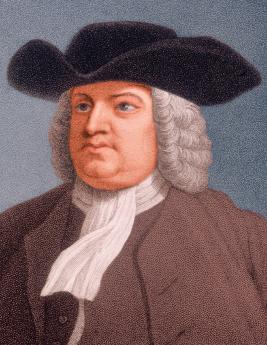
|
| William Penn |
It was a signal and blessed providence which first induced so rare a genius, so excellent and qualified a man as Penn, to obtain and settle such a great tract as Pennsylvania, say 40,000 square miles, as his proper domains. It was a bold conception; and the courage was strong which led him to propose such a grant to himself, in lieu of payments due to his father. He besides manifested the energy and influence of his character in court negotiations, although so unlikely to be a successful courtier by his profession as a Friend, in that he succeeded to attain the grant even against the will and influence of the Duke of York himself who, as he owned New York, desired also to possess the region of Pennsylvania as the right and appendage of his province.
"This memorable event in history, this momentous concern to us, the founding of Pennsylvania, was confirmed to William Penn the Great Seal on the 5th of January, 1681."
-John F. Watson,
Annals of Philadelphia and Pennsylvania in the Olden Time
Second Amendment: The 28th Infantry Division
SINCE the nation was only formed in 1776, and the only memorable war before that was the French and Indian War of 1754, the origin in 1747 of the Pennsylvania 28th Division of Infantry needs a little explaining. The 28th is a National Guard reserve unit, taking its present organizational form 138 years ago. Even counting from that moment makes it the oldest (and third largest) division in the Army, but another 123 years of history stretch back before that.
 AMENDMENT II A well-regulated militia, being necessary to the security of a free state, the right of the people to keep and bear arms, shall not be infringed. 
|
| Second Amendment |
A few people remember that Ben Franklin made his first step into politics during King George's War (1744-48), when French and Spanish privateers were suddenly roaming Delaware Bay . The pacifist Quaker government hesitated in confusion, so Franklin stepped forward to call for a volunteer militia. It was paid for with a lottery because the Quaker legislature resisted; there seemingly was no end to Franklin's ingenuity. The unit remained a permanent one, and since then served with distinction in the various conflicts through the Civil War, when it was organized into the National Guard. The volunteer movement it inspired was part of the impetus for the Second Amendment to the Constitution which the National Rifle Association will be glad to explain to you, although historians commonly trace the civilian soldier tradition back to King James and the English Civil War. Franklin was unfailingly patriotic, and never hesitated about military measures when they seemed necessary. He lived long enough so his military sympathies were still a dominant force at the Constitutional Convention, more than forty years later.
Major General Wesley E. Craig Jr., former commander of the Division, was kind enough to address the Right Angle Club about the 28th Division recently. Since the citizen soldiers of the National Guard all have other careers, his daytime job was as an executive for Strawbridge and Clothier. A moment of reflection about the Scottish origin of his own name, connected with a strongly Quaker firm, evokes the two strongest social and ethnic tensions of early Pennsylvania history.
The audience was treated to a description of the military history of the unit, whose largest battle was the Battle of the Bulge in World War II. But they are in Iraq today, with almost every soldier having served one tour of duty, many of them two or even more. They were the unit stationed in El Ambar province during the period before the Sheiks finally decided that America was going to win this war, and changed sides. General Craig had returned to America only a month before this famous turning-point. Before that, units of the 28th were in Bosnia and Kosovo, and are proud to have been chosen for the introduction of many innovative technologies. They are the only reserve division with Stryker vehicles, and before that employed unmanned drone aircraft for reconnaissance. Observer drones fly at 2000 feet and carry no weapons, unlike the Predator drones which carry rockets and fly at 10,000 feet.
Not everything is a story of combat action; the 28th Division is very proud of its activities in the Katrina rescue missions and other domestic emergencies. The Go Ahead Division is proud of its reputation for being on time, every time.
And it is mindful of the sad side. In Iraq, it is 31 KIA, with 167 WIA. If you're uncertain what that means, try a little harder.
Franklin: Upstart Hero of King George's War (1747)
In 1747, Benjamin Franklin had a life-transforming experience, acting quite unlike his character before, or later. At that time, Old Europe was engaged in some distant tribal skirmishing which has come to be known as King George's War. King George II, that is, under whose rule Franklin in 1751 inscribed on the cornerstone of the Pennsylvania Hospital that Pennsylvania was flourishing, "for he sought the happiness of his people."
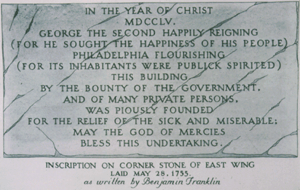
|
|
The cornerstone of the Pennsylvania Hospital inscribed by Franklin. |
Those distant commotions suddenly developed a harsh reality for the little pacifist sanctuaries on the Delaware River, when French and Spanish privateers suddenly raided and destroyed settlements on Delaware Bay. The Quaker Assemblies and their absentee Proprietor merely dithered and huddled in the face of what impended as a totally unexpected threat of annihilation of the pacifist colonies. It probably only seemed natural for the owner of the largest newspaper in the colony to publish a pamphlet called "Plain Truth," urging the inhabitants to rally to their own defense, and pressure their government to lead them. The Quaker leaders were in fact unable to readjust a lifetime of pacifist belief in a few days of an emergency, and the English Proprietor, then Thomas Penn, was far too remote to take active charge of matters. So, Franklin gave speeches, also an unfamiliar role for him, and finally brought out a detailed proposal for the creation of a Pennsylvania Militia. Ten thousand volunteers promptly signed up, elected Franklin as their Colonel; but he declined, and served as a common soldier.
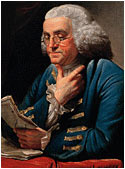
|
| Benjamin Franklin in 1767. |
Against naval attack, the Militia needed cannon, which did not exist in the colony. So Franklin organized a lottery, raised three thousand pounds, and tried to buy cannon from Governor Clinton of New York. New York declined to sell, and so Franklin led a delegation to New York to negotiate. The negotiations largely consisted of getting Governor Clinton drunk and convivial, but they were successful, the artillery was shipped off to Philadelphia. Although they were undoubtedly grateful to Franklin for saving the day, this entirely extra-legal recruitment of an army badly rattled the Quakers and their Proprietor, since it demonstrated the ineffectiveness of their governance at a time of obvious crisis, and might ultimately have led to their overthrow. Franklin's heroic behavior seemed so threatening to Thomas Penn that he described him as "a dangerous man," acting like "the Tribune of the People."
When the underlying commotion in Old Europe subsided, the threat to the colonies disappeared, so the Militia disbanded in a year. Franklin seemed to be just as uncomfortable with his unaccustomed role as the governing leaders were, and he hardly ever mentioned it again. However, this is the sort of reflex leadership which makes political careers, and it surely influenced his decision to retire from business in 1748, run for election to the Assembly, and live like a gentleman. Seven years later, during the French and Indian War, he had become the chosen leader of the Pennsylvania Assembly, had much longer to think through what he was doing, and had learned how to organize a war. By that time, as the saying goes, he knew who he was. He was a man whose silent memories could flashback to that time when a bald fat printer stepped out of the crowd, saying "Follow me," and ten thousand men with muskets did so.
Nation's First Hospital, 1751-2016
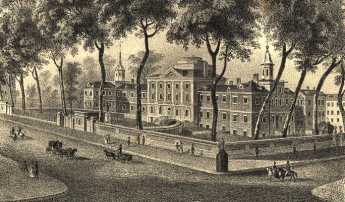
|
| Pennsylvania Hospital |
As commonly stated in medical history circles, the history of the Pennsylvania Hospital is the history of American medicine. The beautiful old original building, with additions attached, still stands where it did in 1755, a great credit to Samuel Rhoads the builder and designer of it. The colonial building on Pine Street stopped housing 150 patients around 1980, supposedly at the demand of the Fire Marshall, although its perpetual fire insurance policy still owes the hospital several thousand dollars a year as an unspent premium dividend. There may have been one small fire during two centuries of use, but its true fire hazard would be difficult to assert. It was just out of date. The original patient areas consisted of long open wards, with forty or so beds lined up behind fluted columns, in four sections on two floors. The pharmacy was on the first floor, the lunatics in the basement, and the operating rooms on the third floor under a domed skylight. It was entirely serviceable in 1948 when I arrived as an intern doctor. Individual privacy was limited to what a curtain between the beds would provide, but on the other hand, it was possible for one nurse to stand at the end of the award and recognize any distress among forty patients immediately. In this trade-off between delicacy and utility, the utility was certain to be preferred by the Quaker founders. Visitors were essentially excluded, and if a patient recovered enough to be unnaturally curious about neighboring patients, well, he had probably recovered enough to go home.
Located between two large rivers, South Philadelphia up to ten blocks away was essentially a swamp until the Civil War. So, there were seasonal epidemics of malaria, yellow fever, typhoid, and poliomyelitis at the hospital until the early twentieth century. Philadelphia was a port city, so sailors brought in cases of venereal disease, scurvy, even an occasional case of anthrax or leprosy. During the Industrial Revolution of the nineteenth century, tuberculosis, rheumatic fever, and diphtheria were part of clinical practice. But underlying the ebb and flow of environmental effects, there was a steady population of illness which did not change a great deal from 1776 to 1948. These patients were all poor, because the rules in Benjamin Franklin's handwriting restricted service to the "sick poor, and only if there is room, for those who can pay." In 1948 there was a poor box for those who might feel grateful, but no credit manager or official payment office. The matter had been considered, but the cost of collection was considered greater than the likely revenue. When Mr. Daniel Gill was offered the position as the hospital's first credit manager, it was suggested that he be given a tenth of what he collected. To his lifelong regret, Dan Gill regretted that he refused an offer that he had felt he could not afford to accept.
So, the wards were filled with victims of the diseases of poverty, punctuated by occasional epidemics of whatever was prevalent. And a second constant feature of the patients was their medical condition forced them to be housed in bed. For centuries, physicians dreaded the news that a new patient was being admitted with "dead legs".
The First and Oldest Hospital in America
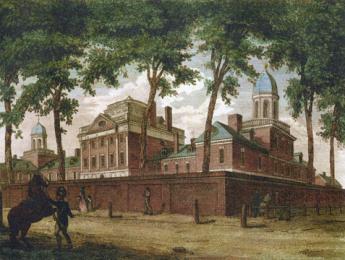
|
| South East Prospect of Pennsylvania Hospital |
There is a painting of the region around 8th and Spruce Streets in the 1750s, depicting a pasture, with cows, and three or four buildings between 8th and 13th Streets. When the Pennsylvania Hospital moved there in 1755 from its temporary location in a house located a block from Independence Hall, there were complaints that it was now located so far out in the woods that it was difficult and dangerous to go there. Still another description of the area is evoked by the provision which the Penn family placed in the deed of gift of the land, strictly forbidding the use of the land as a tannery. Tanneries have always been notorious for giving off noxious odors, so most people wanted them to be somewhere else, anywhere else. In any event, the main activity of Penn's "green country town" at that time was concentrated closer to the Delaware River, and the nation's first hospital was definitely placed in the outskirts. Two blocks further West the almshouse was already in place, but not much else. We are told that Benjamin Franklin had flown his Famous Kite at 9th and Chestnut, using a barn there to store his materials. It might be recalled that the population of Philadelphia, although the second largest English-speaking city in the world, was only about twenty-five thousand inhabitants at the time of the Revolution, and in 1751 was even smaller.
In any event, the first and oldest hospital in America was built on 8th Street between Spruce and Pine, and the Eighteenth Century buildings on Pine Street still present a breathtaking view at any season, but particularly in May when the azaleas are in bloom, and fragrance from the flowering magnolias fills the evening atmosphere for blocks around. Although some people today mistake the Pennsylvania Hospital for a state hospital, it was founded in the reign of George II, decades before there was such a thing as the State of Pennsylvania. The Cornerstone was laid by Benjamin Franklin, with full Masonic rites. Most doctors regard a hospital as a mere workshop, but the affection with which many Pennsylvania physicians regarded their special hospital is indicated by the number who have requested that their ashes be buried in the garden.
For two hundred years, beginning with the first American resident physician Jacob Ehrenzeller, the interns and residents were paid no salary, so they had to live on the grounds. An Internet was just that, interned within the four walls for at least two years. Because the resident physicians had no money, they stayed in the hospital at night and on weekends, playing cards and swapping stories. The hospital was home for them, as it was for the student nurses, likewise unpaid but more strictly confined and supervised. This penury seemed acceptable because the patients were mostly charity ward patients, otherwise unable to pay for their own care. Ehrenzeller finished his medical apprenticeship and went to practice for many decades in the farm country of Chester County, but gradually upper-class Philadelphia moved from 4th Street westward to and beyond the hospital, and two of the richest men in American history, Morris and Biddle, had houses within a block of the hospital, although Morris never lived in his house, having more pressing matters in debtor's prison. Therefore, later resident physicians at the hospital had the potential of setting up a private practice in the area and becoming society doctors as well as academically prominent ones. Being a charity hospital in a rich neighborhood created the potential for volunteer work by the town aristocrats and large bequests for charity. The British housed their wounded in the hospital during the Revolutionary War and shot deserters against the red brick wall of the small cemetery to the north. A century later, there were a couple of dozen rooms for private patients in the hospital for the convenience of the doctors and the neighbors, but everyone else was a charity patient. And a century after that, the hospital still did not have an accounting department to collect bills and tended to regard people who asked for a bill as a nuisance. Benjamin Franklin is regarded as the Founder of the hospital, and his autobiography famously describes how he fast-talked the legislature into matching the donations of the public, not mentioning to them that he had already collected enough promises to see the project through. This seems in character; Franklin's biographer Edmond Morgan summed up that, "Franklin doesn't tell us everything, but what he does tell us, is straight." The idea for the hospital was that of Dr. Thomas Bond, whose house is now a bed and breakfast on Second Street, but it was characteristic of Franklin to be the secretary of the first board of managers of the hospital. In Quaker tradition, the clerk of a meeting is the person who really runs the show. It thus comes about that the minutes of the founding board were recorded in Franklin's own handwriting, among them the purpose of the institution, which is to care for the Sick Poor, and if there is room, for Those Who can pay. This tradition and this method of operation continued until the advent in 1965 of Medicare when charity care was displaced by concepts which the nation had decided were better. The Pennsylvania Hospital was not only the first hospital but for many decades it was the only hospital in America. Its traditions, sometimes quaint and sometimes glorious, cast a long shadow on American medicine.
REFERENCES
| America's First Hospital: The Pennsylvania Hospital 1751-1841 William Henry Williams Ph.D. ISBN-10: 0910702020 | Amazon |
Slaveowning Quaker Steps Up To The Plate
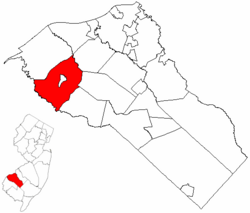
|
| County of Gloucester |
I, Joseph Nicholson of the Township of Woolwich and County of Gloucester, do hereby set free from bondage my Negro Tenor, aged about twenty-two years, and do, for myself, my Executors and Administrators, release unto the said Tenor, all my Right, and all claim whatsoever as to her person or to any Estate that may acquire, hereby declaring the said Tenor, absolutely free, without any interruption from me, or any person claiming under me.
In Witness whereof I have hereunto set my Hand and Seal this twenty-seventh day of the Twelfth Month, in the Year of our Lord One Thousand Seven Hundred and Seventy-nine. 1779.
. . . Joseph Nicholson (Seal)
. . Sealed and Delivered in the presence of Joseph Allen
Pennsylvania Prison Society
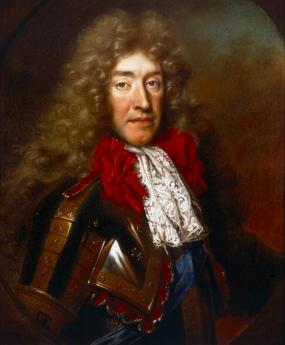
|
| Duke of York |
William Penn, who spent considerable time in British prisons, established a penal code for his new colony which largely swept away the draconian punishments established by the code of the Duke of York. Until as late as 1780, jails were mainly confinement hotels for debtors, prisoners awaiting trial, and witnesses. For actual punishment, the methods were execution and flogging. Penn's Code for Pennsylvania restricted execution to the crime of murder, and flogging to sexual offenses; everything else was punished by fines and imprisonment. Hidden in this code, of course, was the need to invent and construct prisons to service the imprisonment. It would take over a century to address this need, and Philadelphia still has not completely caught up with the need for more prison cells. Without a prison system, the Penn code was impractical, and the colonial penal code retrogressed toward floggings, pillories, and hangings after Penn's death.
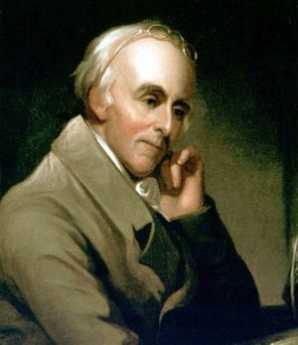
|
| Dr. Benjamin Rush |
In colonial Philadelphia, the main prison was on Walnut Street, with sixteen cells. A neighboring Quaker, Richard Wistar, started a soup kitchen in his own home, taking the soup over to prisoners. By 1773, he had established the Pennsylvania Society for Assisting Distressed Prisoners, which was unfortunately disbanded by the occupying British Army in 1777. In 1783, Dr. Benjamin Rush with the assistance of Benjamin Franklin, Bishop White, and the Vaux family, founded the Philadelphia Society for Alleviating the Miseries of Public Prisons, which after a century changed its name to the Pennsylvania Prison Society. The Prison Society believes it is the oldest continuous non-profit society in America.
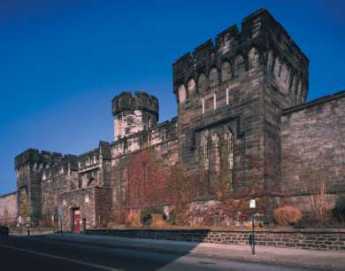
|
| Eastern State Penitentiary |
The Prison Society has had several major changes in direction. The original concept was to substitute public labor for imprisonment, a less costly arrangement than imprisonment while avoiding a return to floggings and dismemberment. However, the degrading sight of prisoners in chain gangs caused a public outcry, and the approach was abandoned. In the spirit of the French and American revolutions, loss of liberty was seen as the greatest punishment conceivable. Added to this was the Quaker concept of inspiring remorse through silent meditation, and the eventual outcome was the construction of the Eastern State Penitentiary on what was then called Cherry Hill. In 1823, it was ominous that Eastern State Penitentiary was the largest structure in America. Although the concept was widely admired and imitated, the prolix Charles Dickens took a violent dislike to the idea of never talking to anyone, and led a reversion away from penitentiaries back to simple prisons. In the days before Alzheimers and schizophrenia were well characterized, the spectacle of massive recidivism was added to the rumor that protracted solitude led to insanity.

|
| Catherine Wise |
From Catherine Wise the Communications Director of the Pennsylvania Prison Society, the Right Angle Club recently learned that the current evolution of the American penal system has led to a steady state, but a troubled one. There are 2.2 million inmates in American prisons today, more than any other nation including Russia and China. Of these, 75,000 are confined in Pennsylvania, 9,000 in Philadelphia. Recidivism is 67%, the cost is $31,000 per year per inmate, the majority of inmates have been involved with illicit drugs, a growing number are infected with HIV and Hepatitis C, mental illness runs around 20%. The cost of incarceration is growing faster than the cost of either education or healthcare for the community. Prison overcrowding is extremely serious, the programs for managing parole and integration back into society are weak and underfunded. Eighty percent of the inmates are non-white, most prisons are located in remote regions too far for easy visiting, medical care in prison would not seem at all acceptable in general society. The Prison Society has no difficulty finding projects which are urgently needed. Just for an example, take the peculiar prison statistics; it really seems improbable that only 9,000 of the 75,000 Pennsylvania prisoners are in Philadelphia. Then reflect, NIMBY, that no one wants a prison or its visitors near his home, except areas of rural poverty welcome the employment a prison brings. Reflect for a moment that "jails" are paid for by local county taxes and contain prisoners with less than two years to serve. "Prisons" are paid for with state taxes, and contain those sentenced to longer than two years. Finally, add the fact that nonvoting Philadelphia prisoners in rural prisons are counted by the census as residents of the rural area for the purpose of distributing legislative and congressional seats. The rural politicians love the system, the urban neighbors love to be rid of the prison environment, but the prisoner families can't visit the prisoner. Who cares? Who even notices?
During the first World War, Quaker interest in prison matters was greatly stimulated by the imprisonment of many Quaker conscientious objectors to the wartime draft; since that time prison conditions have again become a central interest of the religion. It's hard to prove but is confidently asserted, that violence and mistreatment of prisoners are appreciably less in Pennsylvania than the rest of the country, California for example. In any event, The Pennsylvania Prison Society is a particularly effective advocate for humane treatment because of credibility achieved over two centuries, with newspaper editors on its board, and sympathetic affiliations with the legislative judicial committees. It knows what it is talking about, as a result of over 5000 annual prison visitations, and it has served the prison administrative corps by performing volunteer work, accepting contracts for parole projects, arranging bus trips for prisoner families to remote prisons, and working for improved funding for prisons. At the moment, there are six highly imaginative bills before the Pennsylvania Legislature, devised and researched by this outside organization with credibility, and political clout. Although the Society takes an occasional contract for a project, it is itself entirely funded by outside contributions, and because of occasional adversarial situations, asks for no funds from the state. Even the contract funds have been questioned, and are only accepted when the working relationships fostered are more useful for the prisoner clients than any co-option which might result.
One final word about medical care in prison. It's not as good as medical care for non-prisoners, and unfortunately it probably never can be. The remote rural location of prisons makes it difficult to obtain physicians and nurses, regardless of wage levels. It's dangerous to be around prisoners, as any guard will tell you, and it's more dangerous to be in control of narcotics amidst a population of addicted convicts. Malingering is nearly universal, both to obtain desired drugs and to spend "easy time" in the infirmary. Many prison escapes are engineered around the necessarily weakened security of the medical system. The prison budgeting system has all the rigidity and weaknesses of any governmental medical system, and in this case, it's run far out of sight of the public. Even the bureaucrats in charge are victimized by other bureaucrats. The average duration of incarceration in Pennsylvania is longer than in most other states; the prisons have to keep mental patients because the mental hospitals have all been closed. Fifty years ago, when there was no place to put a non-criminal with tuberculosis, he was put in jail. The parole system is underfunded, there is not nearly enough community support to absorb ex-con. Behind all this is a shortage of prison facilities. The legislature has got itself into a position that if it moved more prisoners into the outside, more prisoners would just fill the vacancies, costs would go up, and things wouldn't look much better. Only after the backlogs have been absorbed, would there be much visible effect.
Tales of the Troop
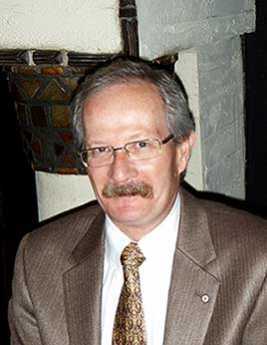 |
| Dennis Boylan |
Dennis Boylan, the former commander of the First Troop, Philadelphia City Cavalry, has been poking around in the archives up at the Armory, and was invited to tell the Right Angle Club about it. In all its history, there have only been 2500 members of the troop, but they have been a colorful lot, leaving lots of history in bits and pieces. The troop boasts that it has seen active duty in every armed conflict of America, and means to continue to fight as a unit of the Pennsylvania National Guard. However, we have lately had so many actions, the troop has had to split off units to be able to go to the Sinai Peninsula, Bosnia, Kosovo, Iraq, Afghanistan and whatever is going to come next. An eighteen month tour of active duty takes a lot out of a citizen soldier's life, but no one is complaining, and there is no fall-off in volunteers.
Although most troopers are polite and taciturn, it is probably hard to remain unaffected by association with people like A.J. Drexel Biddle, a pioneer of the bayonet and hand-to-hand fighting, much sought after for training other units of the military. Or George C.Thomas, who was a golf course architect, but also a seaplane expert, responsible for the seaplane ramps next to the Corinthian Yacht Club along Delaware. Or Rodman Wannamaker, responsible for aeronautic development, also down in the marshes where the Schuylkill joins Delaware. Robert Glendinning, who was notable for other adventures, was also an early pioneer in airplanes. As a matter of fact, Henry Watt had himself flown from Society Hill to Wall Street in a seaplane, when he was President of the New York Stock Exchange.
It's hard to believe, but a former trooper named Eadweard Muybridge distinguished himself in the art world, as a result of a bet with Leland Stopford, that a horse at a gallop reaches a point where all four feet are simultaneously off the ground. The consequence was a famous set of rapid-sequence photographs which are quite famous at the Pennsylvania Academy of Fine Arts. There are elephants, horses, people in various states of undress which remain as interesting artworks as well as scientific evidence that horses feet do indeed leave the ground. But in case anyone believes that Muybridge was some sort of sissy from the art world, there is the story that he caught his wife in an affair and shot the other man dead. As one might expect, the jury found him not guilty, on the grounds of justifiable homicide. With a name like Eadwaerd, it's probably necessary to demonstrate your manliness.
Robert Glendinning, class of 1888 at Penn, became Governor of the New York Stock Exchange, founded Chestnut Hill Hospital and the Philadelphia School for the Deaf. And Thomas Leiper makes a pretty good claim for starting the first railroad in America. It was only 2 miles long, in Swarthmore, and built because he was not permitted to extend his canal for the purpose of transporting stone from upstate quarries. The railroad developed into the Pennsylvania Railroad; Leiper's house, "Strathaven" is still an important Delaware County landmark.
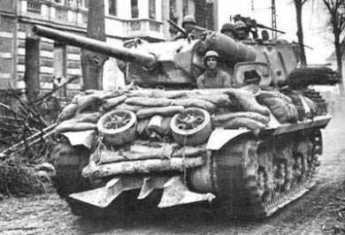 |
| Tank in Philadelphia |
And then, there's the story of the salute to the QE2. When the liner made a tour up the Delaware, a search was made for cannons to provide a proper salute, and the call came to the Troop. Well, they had a tank, and they could fit a simulator on the tank's gun. So, the tank rumbled down Broad street to do its duty. South Philadelphia responded in character, too. Instead of stopping to admire the novelty of a moving tank, the drivers just honked their horns and drove around it.
July 4, 1776: Patients in the Pennsylvania Hospital on Independence Day
According to the records of the Pennsylvania Hospital, the following 48 persons were patients in the hospital on July 4, 1776:
| Richard Brinkinshire (Admitted 11/15/1775) | John Ridgeway (Admitted 12/26/1775) |
| James Chartier (Admitted 1/6/1776) | patient (Admitted 1/6/1776) |
| patient (Admitted 1/20/1776) | patient (Admitted 1/20/1776) |
| Mary Yell (Admitted 2/7/1776l) | John Beckworth (Admitted 2/7/1776) |
| Bart. McCarty (Admitted 2/10/1776) | John King (Admitted 2/10/1776) |
| Robert Alden (Admitted 2/17/1776) | William Patterson (Admitted 3/6/1776) |
| Elizabeth Hanna (Admitted 3/9/1776) | John McMahon (Admitted 3/13/1776) |
| Mary Burgess (Admitted 3/23/1776) | Mary Anderson (Admitted 4/10/1776) |
| John Hatfield (Admitted 4/15/1776) | Eliza Haighn (Admitted 4/17/1776) |
| Charles Whitford (Admitted 4/24/1776) | patient (Admitted 5/8/1776) |
| Susanna Carrington (Admitted 5/8/1776) | patient (Admitted 5/8/1776) |
| William Johnson (Admitted 5/13/1776) | Lazarus Chesterfield (Admitted 5/22/1776) |
| Mary Spieckel (Admitted 5/22/1776l) | William Edwards (Admitted 5/22/1776) |
| patient (Admitted 5/23/1776, Lunatic) | Jane White (Admitted 5/25/1776) |
| Charles McGillop (Admitted 5/29/1776) | ---Fitzgerald (Admitted 6/1/1776) |
| Michael Rowe (Admitted 6/6/1776) | patient (Admitted 6/6/1776) |
| John Hughes (Admitted 6/12/1776) | Joseph Smith (Admitted 6/15/1776) |
| Esther Munro Lunda (Admitted 6/15/1776) | Mathew Coope (Admitted 6/19/1776) |
| Anne Patterson (Admitted 6/19/1776) | Thomas Savoury (Admitted 6/20/1776) |
| Rebecca Winter (Admitted 6/26/1776) | Elizabeth Manning (Admitted 6/26/1776) |
| Negro (Admitted 6/24/1776) | Elex. Scanvay (Admitted 6/24/1776) |
| Fanny Stewart (Admitted 6/24/1776) | Peter Barber (Admitted 6/29/1776) |
| Catherine Campbell (Admitted 6/29/1776) | Ann McGlauklin (Admitted 7/3/1776) |
| Elizabeth Lindsay (Admitted 7/3/1776) | Ann Jones (Admitted 7/3/1776) |
The records indicate the following diseases were the reason for admission of those patients. Although in Colonial times there was no medical delicacy to avoid offending readers, present privacy standards require that we strip the diagnoses from the name of the patient and list them independently. There is some overlap, sometimes making it difficult to judge which disorder caused the admission.
- Sore, poisoned or ulcerated legs: 16 cases
- Lunacy, mind or head disorders: 10 cases
- Syphilis: 7 cases
- Fever and Rheumatic fever: 7 cases
- Dropsy: 5 cases
- Gunshot: 4 cases
- Diabetes: 1
- Blindness with clear pupil: 1
- Spitting blood: 1 case
- Dislocated arm: 1 case
- Inflammation of face: 1 case
- Scurvy: 1 case
- broken arm: 1 case
The following physicians were elected at the Managers Meeting dated 5/13/1776:
- Dr. Thomas Bond
- Dr. Thomas Cadwalader
- Dr. John Redman
- Dr. William Shippen
- Dr. Adam Kuhn
- Dr. John Morgan
College of Physicians of Philadelphia
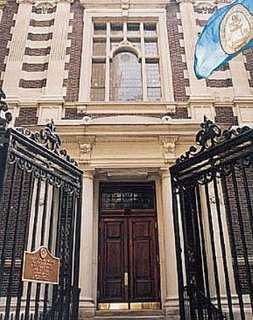
|
| College of Physicians of Philadelphia |
The College of Physicians of Philadelphia is the oldest medical organization in America, or even the Western Hemisphere, having been founded in 1787, the year of the Constitutional Convention. The CPP, located on 22nd Street near Market, is not to be confused with the American College of Physicians (a much more recent organization, formed in 1923 and located at Fifth and Arch Streets). The term "Physician" was then much more specific, and Philip Syng Physick, now known as the father of American Surgery was not considered eligible for membership because he was a surgeon, not a physician.
The general idea of the founding of the College seems to have been to focus on the physicians who had attended medical school (usually in Edinburgh), as distinguished from the general run of a physician at the time, who had merely served an apprenticeship. The first medical school, at the University of Pennsylvania (then at Ninth and Walnut Streets, but now at 36th and Spruce) caused the College of Physicians to turn away from pedagogy to the direction of setting standards and providing a forum for the "better sort" of the profession to be self-governing. At one point, there was even a real possibility that the College of Physicians of Philadelphia would become the credentialing agency for the whole country, but licensing took the direction of state boards during the Nineteenth Century. Every book and journal must have a Library of Congress number. The Transactions of the College of Physicians of Philadelphia has a Library of Congress number, all right. Number one. Jonathan Rhoads, the giant of 20th Century surgery and the only person to be president of the College twice, once remarked that being first may not be terribly important in the greater scheme of things, but -- it's awfully hard to imitate.
The College was a very strong guiding force in the development of a system of medical ethics for the profession. A curious false turn was taken in the direction of Lambda Chi, a secret society of physicians for the purpose of invisibly policing medical conduct, but the College soon recognized this was the wrong direction to take, and eventually, it assumed the lead in forming the American Medical Association in 1848. The portrait of Chapman, the first President of the AMA, hangs above the mantle in the fellows' reception room, the original minutes and rolls of the delegates are found in the library. Half a dozen presidents of the College were also presidents of the AMA, but for some curious reason the College never became the local branch of the AMA, reserving that for the State and Pennsylvania County Medical Societies.
Every year a number of the most distinguished physicians in the world address the College, and an annual lecture by a Nobel Prize winner has been established. The College had the largest medical library in the country until recently, and it is still one of the largest. The present building is a Carnegie Library, in a sense. Andrew Carnegie was a patient of S. Weir Mitchell at the time Mitchell was president of the College and donated a large sum for a new building. The present elegant marble and the walnut-paneled structure was built in 1905, fairly recent by Philadelphia standards but nevertheless a national landmark.
With all this dignity, history and tradition, it likely comes as a surprise to learn that the College building has sixty thousand paid visitors each year. The source of this popularity is a combination of medical exhibits for the public, and the Mutter Museum. In the late Nineteenth Century Thomas Dent Mutter gave his large personal collection of anatomical specimens to the College for a museum in the style of the medieval European medical schools, where the students could learn from specimens on display because anatomical dissection was discouraged if not forbidden, and Kodachrome slides had not been invented. Mutter's collection is a combination of believe-it-or-not "freaks", anthropological studies of human variations, and a museum of medical history. The former curator, Gretchen Worden, has produced an illustrated book of the exhibits which quickly sold out and must be reprinted, and a yearly illustrated calendar which is quite popular. The doctors are a little bemused by the popularity of this material with the public, but tolerant.
Among the odd features of this collection is the brain of Sir William Osler, the giant of modern medical education. Osler belonged to a club of people who had such a high opinion of their own genius they pledged to donate their brains after death to the collection of specimens, in the hope that eventually science would be able to determine the anatomical source of their talents. Most people today are a little staggered at the arrogance of such an idea, so widely at variance with the concept that all men are created equal. Albert Einstein is another acknowledged genius whose brain is still floating in a pickle jar, waiting for its unique properties to be discerned. Presumably, time will eventually tell whether even the greatest intellects suffer from unconquerable hubris, or whether the envious rest of us must adapt to the consensus of political correctness, just to avoid facing the reality of our own inferiority.
The Garden Show Evolves
Adam Levine, who is the unofficial authority on the Philadelphia garden scene, has written elegant books about The Flower Show, and about the larger gardens in the region. At a recent luncheon meeting at the Franklin Inn, he traced the evolution of the Flower Show.

|
| The Pennsylvania Horticultural Society |
The Pennsylvania Horticultural Society was founded in 1827, and it organized the first Flower Show in 1829. For a century it was only an amateur display, very similar to the sort of local garden club display found in many towns and villages in England. The timing of such shows is dictated by the booming season of the flowers of the region, so the display depends on the dates of the local flowers, related in turn to soil and weather conditions. In the early part of the Twentieth Century, W. Atlee Burpee became the dominant force in the Philadelphia show. The show established a long tradition of domination by seed companies and nurseries, with elaborate displays which often took a week to set up, preceded by months or years of planning. The central difference in the nature of the Philadelphia show was that plants were forced into bloom, so much of its impact depended on displays which were seemingly entirely out of season. After World War II, Ernesta Ballard became the moving and controlling force, driving The Show into enormous popularity in the new larger quarters at Convention Hall. Considerable revenue was generated and used to beautify Philadelphia. The Show became the biggest, best, most popular and best funded flower show in America. Ernesta was a success.
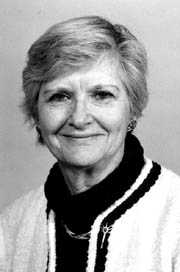
|
| Mrs. Ballard |
Gradually, the most elaborate or dominant displays were put on by florists, using cut flowers. That was not necessarily Mrs. Ballard's original intention, although it might have been. It is the nature of plant nurseries to take away a ball of topsoil when they sell a plant, and that tends to dictate the location of the major nurseries in places where farmers are willing to ruin the land for farming, looking to speculate on suburban development. They thus are usually rural or exurban, because prime farmland is too expensive. Obviously, nurseries are pressed outward from the rim of the expanding city, and may even be forced to locate at a considerable distance away. These realities of the business tend to diminish the local loyalties of the nurseries and the city to each other. Mainly, cut flower arrangements resisted this trend by using greenhouses, but air freight has now made it possible for exhibitors of live plants to come from the Netherlands, Peru, and even Korea. The Flower Show is still held in Philadelphia, but it is much less a product of Philadelphians, especially amateur Philadelphians. When large single exhibits now can cost $100,000 apiece to organize, it is not surprising that the Philadelphians who do exhibit, are members of the upper crust.
And then there are those unions. While upper crust exhibitors can afford to pay full union wages for an electrician to plug in one electrical outlet, they are instantly offended by the whole featherbedding experience of being forced to do it. And since a great many blue collar union members are hostile to any suggestion that these gentleman farmers are in any way their social superiors, they can display what is known as an attitude. Philadelphia is famous for aggressive unions, and the Convention Center is additionally notorious for unions with political clout. Somehow, the politicians in charge of this unfortunate passive-aggressive scene get control of it and are seen to get control of it. After all, snooty exhibitors are occasionally in a position to move whole factories out to the suburbs, to the general injury of the city; moving a flower show wouldn't be too hard to do. The paradox is that 70% of these union members live in the suburbs themselves. The Flower Show cannot run without the enthusiastic help of 3500 volunteers, easily turned off by muscling them. The judging is done by 175 volunteer judges from all over America, coming to Philadelphia at their own expense, for example.
The Flower Show has had memorable moments. There was a time when the Shipley School consistently won most of the prizes. There was a famous episode when the Widener Estate of Linwood had a world-famous Acacia display. When it was broken up, there was an uproar when it was given to Washington DC, instead of staying right here where it belonged. Now, the gossip is about exhibitors from Ukraine, or from Japan, making little laughable mistakes about local geography with many streets named One Way.
The Show goes on and thrives. But just what its future is going to be is unclear. The Convention Center has doubled its space, but whether it can double its business is uncertain. And the management has recently changed from leadership which had a focus on the show and regarded city beautification as something to do with left-over profits, to leadership with a primary interest in the beautification of the city. No business will thrive if it neglects its revenue stream. So, please be careful with our nice Flower Show.
REFERENCES
| Standardized Plant Names: American Joint Committee on Horticultural, Frederick Law Olmsted | Google Books |
Wagner Free Institute of Science
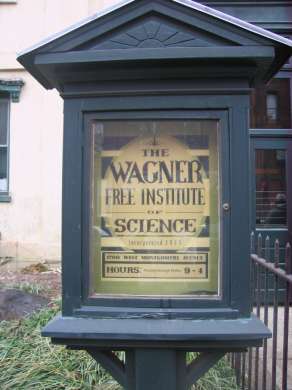
|
| Wagner Institute Logo |
William Wagner emigrated to Philadelphia as a prosperous merchant shortly after the nation was formed, becoming a friend affiliated in business with Stephen Girard, although never a partner. Business took him around the world, where he pursued his hobby of collecting scientific specimens. The collection grew until it needed a museum to house it, accordingly built on the family farm somewhat north of the city limits, now 1700 Montgomery Street. A woodprint shows a game of baseball in play in the fields, with the museum recognizably looming in the background. Those fields are now filled with Nineteenth century red brick Philadelphia rowhouses, built later to support the activities of the Museum. Unfortunately, a need for a parking lot was not anticipated in 1848, but the place is quite safe to visit because land directly across 17th Street, also part of the original Wagner farm, was given over to the 22nd District police station. It's even possible the parking issue has since been considered since nearby land was deeded to a Unitarian Church on condition of reverting to the museum if it stops being a church.
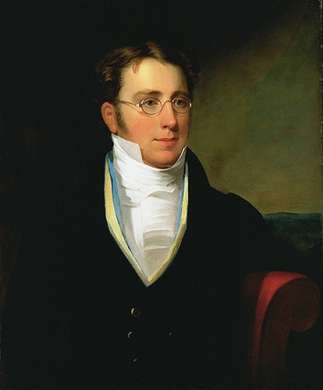
|
| William Wagner |
William Wagner became the first director of his museum, following the ideas of his friend Girard a few blocks to the south. Stephen Girard had left his estate to the education of poor white orphan boys; Wagner extended the idea of offering free scientific education to the working public. The example ofBenjamin Franklin's discovery of the nature of electricity with only a second-grade education is a locally dramatic example of the important truth that science can be enjoyed and even skillfully performed without academic preparation or advanced degrees. Science in the early Nineteenth century evolved from Natural Philosophy to what we now call Natural Science, heavily weighted toward geology, botany and zoology with a strong dose of Charles Darwin. Today, those ideas are having a reawakening in the Green (Environmental) Movement, so perhaps a resurgence of interest really is about to appear. The museum might be called a historical record of Nineteenth-century science, although its lecture series are wider ranging and, of course, up to date. Reflecting the intended science education of the working public, many of the lectures are given in the evening and on weekends. Many are given in other locations, like the Free Library branches. The Wagner resembles the Barnes Museum in the sense that two museums once intended to illustrate educational innovations have come to overshadow the public's perception of the educational programs, whereas the cost of maintaining museums grew far faster than the income from endowments. It all resembles academia in general in getting progressively more expensive to provide for.
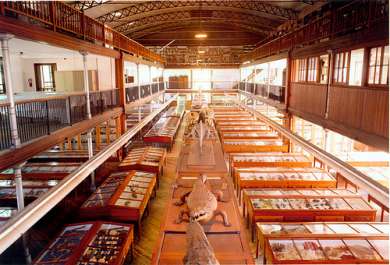
|
| The Wagner Museum |
The Wagner museum was formally opened in 1854, about the time of the City-County consolidation which relieved the population pressure needing to fill up surrounding fields with redbrick rowhouses, and eventually with Temple University. The formal Institute directorship was transferred to the professional management of Joseph P. Leidy, a dynamo of a man who received the informal title of The Last Man Who Knew Everything. When Leidy retired at the end of the Nineteenth century, the museum was closed to further acquisitions. For those who can remember natural science museums around 1930, the Wagner is strongly reminiscent, but over time it has become one of the few, perhaps the only, surviving example of the type. The building next door is a scientific library, available to scholars by appointment. The Athenaeum and the Mutter Museum are also surviving museum monuments, but even those two have been elaborately modernized. The Wagner resolutely adheres to looking as much like the original as maintenance will permit. The structure is as interesting as the contents; only the lecture topics move forward with the times.
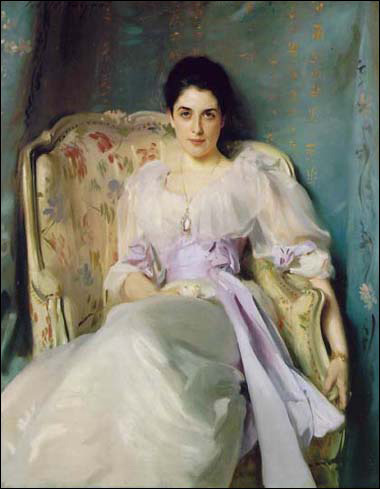
|
| Anna Karenina |
The Institute drifted away from the Wagner family, but a few Wagners of the present generation became attracted by the connection to their name, and have struggled to keep it alive. The board has a few Wagner family members, who do their best to spark the enthusiasm of others who value the lectures, the scientific educational movement, and historical quality of an expensive but unique museum in a difficult neighborhood. Quite a few loyalists throng around the evening lectures with a happy air of joint participation and tradition. It would be hard to overlook the sincerity and courtesy that hovers around the edges of a shared cultural belief. It's a family activity, all right, but it is no longer a Wagner family but a Wagner Museum family. Participants are unmistakeably really happy that visitors have come to see it. The opening lines of Tolstoy's Anna Karenina declare that all happy families are happy in the same way, but that's wrong. The Wagner Museum family are obviously happy but in a unique way. In a nation which so universally prizes the future, here's one group who have seen the merit of having some institutions grow in value by seeming to stay just the way they began.
The Savoy and the Orpheus
Much of the music in Philadelphia is world-class, produced by eminent professionals who command high salaries for their work. As a result of many years of striving, through unions and otherwise, it is getting a little difficult to afford all this talent and excellence. That's one reason there is so much amateur musical effort, although it must be admitted that a city which appreciates music will almost surely generate a lot of amateur effort, just for the love of performing.
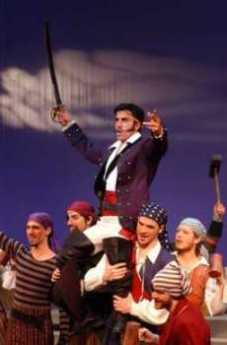
|
| The Pirates of Penzance |
The Savoy Company, putting on Gilbert and Sullivan operettas, and the Orpheus Club, which is an all-male choral society, were founded in Philadelphia around 1875. Both groups have little trouble attracting membership, although the members of the Savoy generally only perform for four or five seasons and then become inactive members. Members of the Orpheus commonly remain active members for fifty years, so it's harder for a newcomer to find a vacancy. Membership applications may possibly be enhanced at the Savoy by its reputation, deserved or undeserved, as a marriage market. At one time, fifty or more years ago, both organizations had a reputation for hard drinking, but during those days of Prohibition, many clubs served that function. Nowadays, alcohol is not a necessity with either of them.
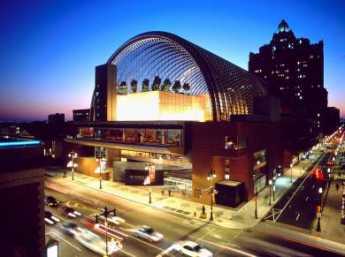
|
| The Kimmel Center |
The exceedingly high hall-rental costs of the Kimmel Center and the Academy of Music are getting to be a problem for these amateur groups. The Savoy is lucky to be invited to have two performances a year at Longwood Gardens, and neither organization has to contend with paying professional musicians like its commercial competitors. Many performers in the Philadelphia Orchestra donate their time for the Savoy, among whom William Kincaid the famous flutist was one of the most enthusiastic. Without this help, it's unlikely the organizations would survive. Certainly, it would be hard to distribute four tickets per performance to members of the clubs, while striving to keep membership high.
All of this is just one facet of the general dilemma that it is increasingly impossible to break even in the performing arts, by ticket sales alone. Many taxpayers are Luke warm about music and see no reason why they should support it with taxes, and philanthropists can be fickle. It's a delicate balancing act because philanthropists are easily infuriated by strikes, and politicians are seldom attracted by what may be called the finer things. When the economy turns sour, ticket-buyers flee.
Onward, Christian Soldiers
Among the ten largest cities in the United States, Philadelphia at 24% has the highest poverty rate. Why that should be so, and what should be done to change it, are questions for another article. Meanwhile, many helpless hopeless people need immediate help with problems of daily survival. No doubt, Philadelphia's long history of practical charity has acted as a magnet for victims of social problems caused elsewhere, and many of our locals who deserve some blame have moved away to more promising environments. For those who remain and want to help the immediate need, these things don't matter, just so long perhaps as emergency measures do not interfere with long-term solutions.

|
| Salvation Sign |
Among many private relief efforts, the Salvation Army is widely acknowledged to be the most efficient and most effective, as well the largest. Before the big event in 2004, it had a $3 billion budget and 3 million volunteers; an army, indeed. Except for Quaker charities, which mean to spend nothing on solicitation except through their own example, the Army spends a notable record of 91% of its budget for direct relief. In Philadelphia, they have 9 community centers, 8 residential centers, and 2 children's shelters. This is the largest charity in the United States, with branches in 110 other countries. There are 65,000 homeless people sheltered, every night.
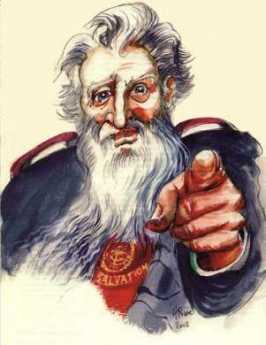
|
| William Booth |
A moment should be spent on the history of the Army. It was founded by William Booth, who was a London pawnbroker before he became a Methodist minister. Sir Arthur Sullivan wrote "Onward, Christian Soldiers" in 1871 a decade before it became so aptly associated with the Salvation Army, and indeed before it became attached to the words of Sabine Baring-Gould . Originally the music had to do with St. Gertrude. The militarism of the organization has offended some people, even elders of the Methodist Church, and the Christian emphasis offends non-Christians. United, or Community, Funds are miffed that the Army usually will not agree to limit its solicitations to their umbrella, and modern sophisticates scorn the 19th Century traditions of Christmas Kettles, and such like. Since the main emphasis of the Army has been on relieving the problems of the Industrial Revolution, like alcoholism, drug addiction, prostitution, some see an implied criticism of modern progress, or of capitalism, or the entertainment business in general. Some people don't like the fact that most of the causes of poverty could be described as self-inflicted. You simply can't satisfy everybody. But when the rehabilitation of alcoholism and drug addiction generally carries a success rate of 25%, the Salvation Army approach -- no matter what you may think of its symbols -- is able to defend the claim of 65% success. If you don't like "Human Needs in Jesus' Name", just try "Practical Success in a Difficult Field" for a subtitle.
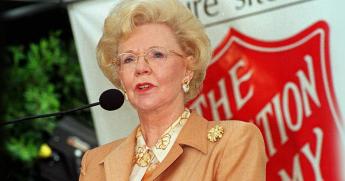
|
| Joan Kroc |
It thus becomes understandable that when in 2004 Joan Kroc, the widow of the founder of McDonalds Hamburger chain, decided to leave her estate of $1.5 billion to relief of the poor, she chose the Salvation Army to run things for her. Her interesting will divide the country into four parts, with 28 cities to receive $36 million grants for the construction of community centers, plus an equal amount for the endowment to run them. The size of the grants was calculated to force the local cities to match them (Philadelphia still has $20 million to go) and the endowments specify no income to be derived if the amount falls below the original $36 million, or otherwise to be limited to a 5% spending rule. She was perhaps optimistic that investment advisors could regularly produce a 17% return, and really truly optimistic if she believed our government could restrain inflation within those bounds. But a sharp business mind shines through these covenants, a very necessary ingredient of successful philanthropy.
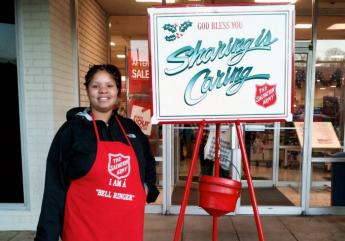
|
| Salvation Workers |
Mrs. Kroc wanted these centers to be located in the areas of worst need; that explains the choice of a 12-acre plot in Nicetown, at the corner of Wissahickon and Hunting Park Avenues. The area now surrounding a former factory for the Budd Company has a 35% poverty rate. But after 2009 it will have an aquatic center of several swimming pools, gyms and fitness centers, a computer laboratory, arts and performing theater centers, and other more traditional Salvation Army facilities. It will also have 27 other American cities with comparable centers to share experiences with, to compete against, and to be put to shame by Philadelphia's superior ideas. We hope.
www.Philadelphia-Reflections.com/blog/1425.htm
Cushman Club for Lonesome Actresses
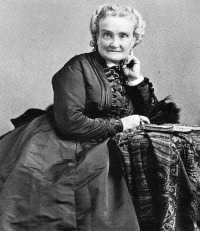 |
| Charolotte Cushman |
Lydia Ellicott Morris was married to another member of the Quaker colonial aristocracy, George Spencer Morris; both of them were active members of many organizations, including the Philadelphia Savings Fund Society, Friends Hospital, and several of the clubs on Camac Street. Their home for many years was located at 225 South Eighth Street. George Morris was a senior partner of Morris and Erskine, Architects. One day, Lydia was riding on a trolley car.
On the trolley, she overheard two young actresses fretting over the problem that traveling actresses were forced to live in hotels and boarding houses along with traveling salesmen. This circumstance forced them to experience much-unwanted attention and made being an actress a difficult occupation for respectable women. Lydia promptly got off the trolley and formed an organization raising funds to create in 1907 a boarding home to provide safe, respectable, inexpensive lodgings for actresses in traveling shows, playing in Philadelphia. It was named after Charlotte Cushman, the first internationally famous American actress, and located at 1010 Spruce Street. Charlotte Cushman had no connection with the club, but her fame can be appreciated from the fact that in 1874 after her final performance, 15,000 people were reported to have serenaded her outside of New York's Fifth Avenue Hotel. The Ninth Regimental Band played, while fireworks illuminated Madison Square. Ms. Cushman died in 1876.
Another major donor to the club was a Mr. Peterson, otherwise unidentified, who gave them $50,000. Further funds were raised at five annual teas. In 1925, Philadelphia was a major center for the film industry, and much Charlotte Cushman Club early history relates to movie associations. Much of the early endowment was unfortunately lost in the 1929 stock market crash, however, and the club continued only a subdued presence for a number of years. By 1999, it was clear that the original purpose was not really needed, and the club was disbanded. Its possessions, including the last of several clubhouses, the collections, and a rather valuable library, were sold off, and most of its other belongings were donated to the Franklin Inn Club. The club began a new existence as the Charlotte Cushman Foundation, first endowing the Charlotte Cushman Board Room and Exhibit, at the University of the Arts, and then in 2001 began making grants to local nonprofit theatre groups. At present, the Foundation dispenses an income of about $45,000 yearly among 43 non-profit theatrical societies which continue in Philadelphia. Present dominant activity is to select the Leading Actress in a Play, as part of the annual Barrymore Awards. The rise of the club reflected the vibrant downtown social life of Philadelphia at a time when almost all Philadelphians were residents of the center city. And its decline parallels the loss of civic-minded center city residents following the spread of household automobiles and the continuing wreckage of traditional civic feeling following the 1929 crash.
The Foundations's website is www.charlottecushmanfoundation.org, and its email address is CharlotteCushmanFoundation@gmail.com
AFSC: American Friends Service Committee
Two things uniquely characterize the work of the Friends Service Committee (AFSC): it's often both dangerous and unpopular. That's not required for relief following Indonesian tidal waves perhaps, but the work that really needs someone to do is often both dangerous and controversial.
The Service Committee was founded in 1917, mostly by Rufus Jones and Henry Cadbury, as a way of helping conscientious objectors to World War I. The Mennonites, the Brethren, and the Quakers were opposed to all wars, not just that particular one, but two of those religions are of German ancestry, and lacked the same credibility of the English-origin Quakers in a war with English allies against the Huns, Boche, and Kaiser enemies. The early focus of the Committee was on the Field Service, or Ambulance Corps; which was plenty close to the action, and plenty dangerous. After the War, the defeated German population was starving, and the Quaker Herbert Hoover directed the relief effort with great credit to the Quaker name, and immense European gratitude.
After that, when German Jews were suffering persecution by the Hitler administration, the Quakers initially responded in a uniquely Quaker way. Rufus Jones and two other Quakers went to see Reinhard Heydrich, to tell him the world disapproved of his behavior. They fully realized they represented a pool of important world opinion, particularly within Germany, and it was time to speak truth to Power. The Germans left the room to confer, and the three Quakers bowed their heads in silent prayer. Apparently, the room was tape recorded, and when the German officials returned, they did promise some efforts to improve matters. As the situation for the Jews soon got much worse, many Quakers risked a great deal to shelter and rescue the persecuted exiles. Relief to the defeated German populace had to be repeated after that war, as well. Each effort built up more credibility to be able to switch sides for the next effort, and the sincerity has seldom been seriously questioned.
The Japanese were also our hated enemies in World War II, and once more a long history helped the relief effort. Nearly 100,000 American citizens of Japanese origin were interned on the West Coast as potential traitors in 1941, often under deplorable conditions. Clarence Pickett was a director of AFSC at the time, and his sister had spent years in Japan as a missionary, so his remonstrations with the American government were prompt and credible. One of the more active workers was Esther Rhoads, sister of the famous surgeon, who had spent time in Japan earlier. One of the ingenious efforts with the Nisei was to assist 4,000 of them to get into college and find them hostels and jobs while they were away at school. Many of these college students later became prominent in various ways, greatly assisting the post-war reconciliation between the two countries.
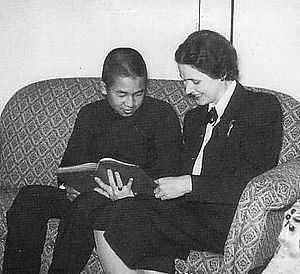
|
| Prince Akihito and Elizabeth Gray Vining |
Two Quaker ladies at the AFSC made a totally unique contribution when a request was received to provide a suitable tutor for the Crown Prince, now Emperor. He didn't convert to Christianity, but he later married a Christian, and you can be sure he got a plenty good dose of Quaker style and belief from Elizabeth Gray Vining. This tall, strikingly handsome Philadelphia woman had Bryn Mawr written all over her and turned heads whenever she entered a room. When she went back home, she was followed as a tutor for seven years by, guess who, Esther Rhoads who by then was the director of the Tokyo girls school. It remains to be seen, of course, what the final outcome of this deeply emotional situation will prove to have been. At the moment, the main sufferer seems to be the immensely talented American-educated woman who married the Emperor. But we will see; these are all powerful women in a very quiet way, unaccustomed to losing. One wishes the royal family all the best in their sometimes difficult position.
And then the Service Committee did its work in Vietnam, in Iraq, in Zimbabwe, and Somalia on the unpopular side, in every case. There are stories of venturing into war zones with hundred-dollar bills scotch-taped to their torso, where every fifty feet there was someone who would cut your throat for a dime. One worker in Laos entertained a group of us tourists with tales of living for weeks with nothing to eat but grasshoppers and cockroaches. Dangerous, unpopular, and uncomfortable. It sounds like a wonderful outlet for someone who is a perpetual rebel without a cause, but if you can find one of those at the Service Committee, you must have done a lot of looking.
The Service Committee, like the Quaker school system, is mostly run by non-Quaker staff. That means that neither of them exactly speaks for the religion itself. This little religious group of 12,000 members is stretched thin to provide a vastly greater world influence than its numbers imply. Hidden in the secrets of the group is an enduring ability to attract sincere non-member adherents to their work. And a quiet watchfulness to avoid losing control to any wandering rebels without a cause.
REFERENCES
| Window for the Crown Prince: Akihito of Japan, Elizabeth Gray Vining ISBN-13: 978-0804816045 | Amazon |
Philadelphia Mafia: The First Fifty Years
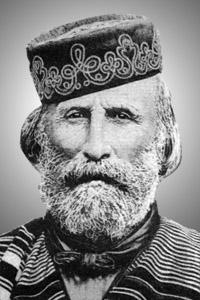 |
| General Giuseppe Garibaldi |
General Giuseppe Garibaldi unified Italy, but a great many Italians either didn't want to be unified, or emigrated to America after 1860 to escape the turmoil. The far western tip of Sicily was the most remote place in Europe, protected by mountains and volcanoes, speaking its own language, and loyal to no government except its own informal one. Over a period of centuries, secret traditions of feudalism and invisible governance had protected Sicily from invaders of various sorts. Although religion was a powerful force, theirs had traces of the Greek Orthodox Church; allegiance to the Vatican faded out as the local priesthood got closer to it. These people mostly wanted to be left alone, and dealt with outside authority in various devious ways, not stopping with murder if necessary. Informal taxes were collected as "paid protection" since a secret army costs money if only to support funerals and soldiers' widows. Rank within the underground army was identified by various degrees of "honor", which could sound vague but were in fact quite unambiguous. Central to the code of the Sicilian underground government, like all guerilla movements was a strict rule of silence, "omerta". As an intern in a hospital accident room, I have seen members of this organization actually go to their deaths, grimly repeating the mantra, "I don't know nuthin."
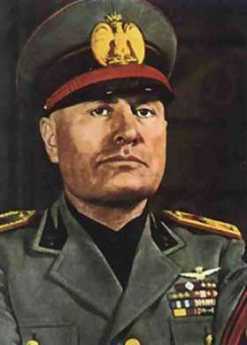 |
| Benito Mussolini |
Italy may have been unified by Garibaldi in the sense of being freed of French, Austrian and Papal domination, but unification was far from peaceful and contented, with losers often choosing emigration. A second wave of emigration was provoked by the harsh rule of the dictator Benito Mussolini, who determined to squelch underground resistance once and for all.
Western Sicilians originally chose New Orleans as their new home, which unfortunately for them already had its own secret society, the Ku Klux Klan. A prompt reaction to the "Italians" with ten or twelve lynchings soon convinced the Sicilians to resettle elsewhere. It seems possible that some of the later techniques of the Mafia were learned from the Klan. In any event, the Sicilians split into two main groups, one going to New York and the other to Philadelphia. Offshoots of the New York group moved to the mining areas of Luzerne County in central Pennsylvania (Hazelton), while another early group migrated to Norristown. There were, of course, links of intermarriage among these groups, but in the early years they drifted apart as separate colonies.
Italian immigrants were no exception to the common tendency of new immigrant groups to gravitate into crime. Records of the Pennsylvania police and jail systems for three centuries show successive waves of inmates with surnames identifying Scottish, then German, then Irish, and eventually Italians. At present, seventy percent of prison inmates are black. Almost without exception, the main victims of immigrant predation have been members of their own immigrant group. Immigrants are easily victimized, somewhat defenseless, and uncertain of the assistance of local law enforcement. Among the most famous of the lawless predator groups among the Italians was the Black Hand, whose specialty was extortion with notes signed with a black hand symbol, enforced by putting bombs under porches. Locals will show you a place on Ninth Street a couple of blocks from the Pennsylvania Hospital where the Black Hand blew things up. The Black Hand, however, was not the Mafia; it exemplified what the Mafia was formed to control.
The Italian community for fifty years was centered on Christian Street, mostly between Eighth and Ninth, gradually migrating westward toward Eleventh Street. Christian Street had been named by the Swedish Philadelphia colony after their monarchs, but the original Swedes tended to remain in Queen (Christina) Village, along Delaware, while the newer migrants drifted to newer areas. During the Civil War, northern railroads heading south ended in Camden. In time, the main Civil War traffic ferried across the Delaware River to wharves at the foot of Washington Avenue. South Street was the honky-tonk area, with a black community growing along with it. After the War, an immigration station was constructed in the Washington Avenue wharf, and the new Italians tended to settle nearby. As the streets were extended westward, the street names were also extended, but the region of Eighth and Christian was largely open fields when the Italians moved into the area, and never had been Swedish. Although there were forty or more murders in the block of Christian from Eighth to Ninth in ten years after the first World War ("Murderers Row"), in modern times the neighboring region is prized by Italian residents as an extremely safe place to live, because the Don likes it nice and quiet.
While it is probably true this safety net quality might not be so evident to blacks and Vietnamese, the safe streets for Italians feature are universally attributed to the Mafia. The Sicilian group quickly reestablished the secret army of "soldiers" and "dons" (usually one don overseeing ten soldiers), started collecting taxes in the form of protection money from the local residents, and putting one "capo" in overall command. You had to be a Sicilian, and a Western Sicilian at that, to be eligible for membership in this secret army. The hierarchy was secret but could be surmised by the elaborate "respect" paid by one to another.
My office partner, Dr. Robert Gill, tells a story illustrating the paying of respect. He was called in consultation to an Italian home by Dr. Baglivo, a highly respected general practitioner in the Italian community. The two of them walked down Eighth Street, and as they passed a barber shop, Dr. Baglivo suggested they both go in for a haircut. Evidently, the patient to be visited was a very important person, and as they went in the shop, Dr. Baglivo introduced Dr. Gill to the group of assembled loiterers as the big doctor from the Pennsylvania Hospital, come to visit you-know-who with the last name ending in a vowel. The group jumped to their feet, in respect, and the barber turned to the lathered-up, half-shaved man in the barber chair. "You!", he cried out, "Get out of that chair! Let the Doctor have a haircut.!" The man dutifully scrambled out of the chair with shaving cream dripping, and humbly sat in a waiting chair, while the big doctor got his haircut. As they left the shop, payment for the haircut was elaborately refused. The point, of course, is not so much one of respect for the medical profession, as respect for someone who had been chosen to attend a capo.
The Mafia was thought to do a fair amount of slashing and breaking of kneecaps, but killing was not permitted except at the order of the boss, or capo. The police could be fairly tolerant of informal methods of law enforcement, but dead bodies brought newspaper attention where even paid-off politicians might not be able to shield the Organization from "heat". For the first forty years, members of the Mafia were sort of volunteer firemen, earning their living as tradesmen and laborers; Mafiosi were paid protection money but were not generally wealthy. The identity of the capo was for forty years a complete mystery to the non-Sicilian community.
But then, along came Prohibition.
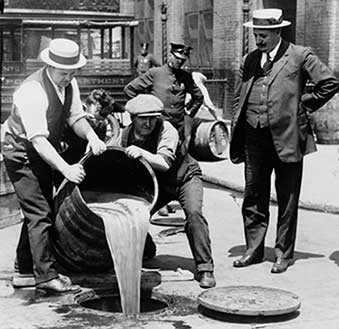 |
| Prohibition |
Prohibition created big money fairly safely, so bootleggers proliferated widely. It was soon no longer possible for one tightly-knit fraternal organization to intimidate a whole host of petty criminals acting alone or in small groups, so the Mafia was forced to control the bootlegging industry through dominating its sources of supply. As a general rule, "rum-running" involved bringing in conventional brand liquor from Canada. That route made Chicago, Boston and New York the major entry and distribution points for "good stuff". From Philadelphia south, most illegal liquor was "moonshine" or other illegally distilled products. Some liquor was distilled in abandoned buildings and garages, but a substantial amount was distilled in the Pine Barrens of nearby New Jersey. The colorful history of the Teamsters Union can be traced in part to the transportation network established for conveying one form of bootleg or another to its retail destinations. Trucks were often hijacked, so paid protection took a new motorized form. The manpower required soon exceeded the number of Sicilian neighbors related by intermarriage. Local groups had to be coordinated with national groups, requiring the establishment of syndicates and governing councils. Even then, one group of recognized Mafia might collide with another; the resulting murders had to be negotiated through a quasi-judicial appellate system.
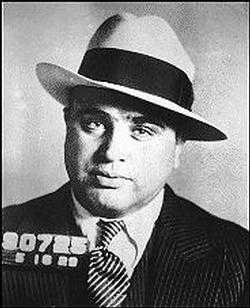 |
| Al Capone |
Philadelphia appears to have had a share of gangland warfare, but mainly that was based in Chicago and New York. In one year, Chicago experienced four hundred gangland murders, Philadelphia only forty. Al Capone came to visit Philadelphia, for reasons unknown, was assured he was most unwelcome and got himself put in jail, for his own protection. Eastern Penitentiary likes to show off his well-decorated cell, to which meals were apparently catered. What was really going on remains a mystery. A group of ten Philadelphia Mafiosi is now known to have gone to New York to participate in the "Castellammerese Wars", where two large New York Mafia groups engaged in a fierce battle for supremacy in what was now a source of vast riches. Occasional lurid episodes like this surfaced in Philadelphia, but the Mob was determined to remain as obscure as possible, and many details are missing or deliberately misrepresented. The essence of it all was that Prohibition had transformed the Mafia from a little vigilante group who imposed law and order on a lawless immigrant community, into a tightly organized army of killers, who mostly devoted their war efforts to exterminating rival tribes, while their daily activities consisted of running marginally tolerable criminal activities like gambling and loan sharking.
sting book by Celeste A. Morello called Before Bruno. In 1927, the Mafia decided they could no longer tolerate the Zanghi gang of four or five or a somewhat larger gang of Lanzetti brothers. On Memorial Day, 1927, several Zanghi members were standing on the corner of Eighth and Christian, when they were approached by several men in black overcoats. Down the street came a car with several others carrying shotguns. After the smoke cleared, three Zanghi (one of them the uncle of Mario Lanza the singer) were lying in a pool of blood, and the car went careening down Christian Street with four Mafiosi, including Salvatore Sabella, crouched on the running boards. "Musky" Zanghi, who was intended as another victim, emerged from the neighboring building and acted like a crazy man. "Sabella," he cried, "Sabella did it!". And he continued to squeal, right into the police station and newspapers. The unthinkable had happened; someone ratted. As it turned out, Sabella was revealed as the Capo himself, and general consternation ensued. Just how this information got circulated is unknown, but a story has it that $50,000 was paid to Musky to shut his mouth, Musky failed to appear in court as a witness, the court system was persuaded to blame the whole thing on an unknown underlying named Quattrana (who went to jail for eight years), everybody else was not guilty, Sabella retired as capo at the remarkably young age of 40 and lived for years in Norristown. In fact, because of the 1929 crash, Sabella the capo had to work as a butcher in Norristown, receiving small gifts as a pension. And, as these undocumented stories would have it, it took fifteen years but eventually someone, surely a friend of Sabella, "got" Musky Zanghi, who was hiding out in New York.And the Lanzetti brothers? Well, they got eliminated, reputedly by Sabella's successors in the organization, but the violence triggered extensive Grand Jury investigations led by Judge Edwin O. Lewis, later the father of Independence Mall. Thereafter, mob rubouts became considerably less frequent. Although newspaper and FBI activity had been extensive, and apparently effective, a more detached view makes it more likely that repeal of the Volstead Act was the major factor causing mob activity to subside.
REFERENCES
| Blood and Honor: Inside the Scarfo Mob, the Mafia's Most Violent Family George Anastasia ISBN-13: 978-0940159860 | Amazon |
| Before Bruno: The History of the Philadelphia Mafia Book 2 C. A. Morello ISBN: 978-0967733425 | Amazon |
| The Last Gangster George Anastasia ISBN-13: 978-0060544232 | Amazon |
| The Last Mouthpiece: The Man Who Dared to Defend the MobRobert F. Simone ISBN-13: 978-09401596932 | Amazon |
REFERENCES
| The Pine Barrens: John McPhee: ISBN-13: 978-0374514426 | Amazon |
Plays and Players, Haddonfield Version
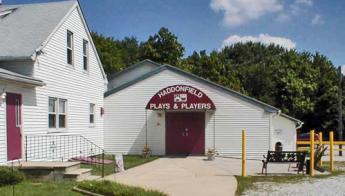
|
| Haddonfield Plays and Players |
First, an anecdote from my own lurid past. When I went there, Yale was an all-male institution with one exception, the Drama School. It's true that Shakspere had boys play the part of women in his plays, but Yale evidently felt that was going unnecessarily far, and had thus let the nose of the female camel get under the all-male tent. Meanwhile, I had discovered that a course in Advanced Chemical Engineering was carrying my amateur interest in chemistry sets a long way too far, and after two weeks, I wanted out of it. Out!
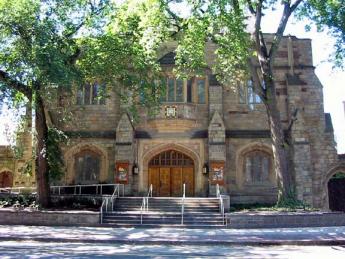
|
| Yale Drama School |
The Dean was sympathetic until I answered what I wanted to transfer into -- a course at the Drama School. Somehow, he felt that was immensely amusing, one he hadn't heard before. But, finding my grade average satisfactory, he gave a big wink and signed the paper. I didn't pretend to be offended, but I did pretend to be solemn. The experience subsequently served me very well, since that class of girls went down to Broadway at the same time I went down to New York to medical school. Almost none of my mostly all-male class of medical students knew any girls in New York, but by comparison, I knew lots. It made me very popular with both groups.
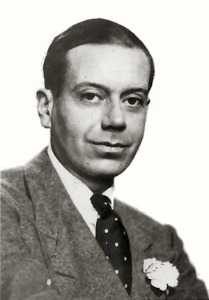
|
| Cole Porter |
It thus develops that I had the courage recently to accompany to a theater party in Haddonfield, a lady who had spent twenty-five years on the stage. The play was Cole Porter's Anything Goes, put on by the Haddonfield Plays and Players, a group celebrating its 75th year of productions. You seldom see musical comedies anymore, because the large cast and orchestra requirements are pushed by Union rules to the huge expense which a professional group cannot safely risk, and amateur groups mostly cannot enlist a large enough audience to support. In addition to the orchestra, stagehands, and administration, I counted thirty members of the cast up on the stage for the big chorus numbers. There might have been a hundred in the audience to pay the bills. This wasn't the only play of the season, there will be five I understand, so the performers have to be quick studies, which generally means considerable experience. Even with what therefore must have been a short time to rehearse, this group was good, really, really good. The lady by my side remarked these people must be semi-professionals, at least. I didn't think so, so she demanded a playbill to see. Sure enough, semi-pro.
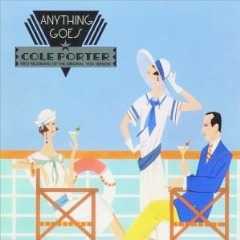
|
| Anything Goes |
All of which may seem a round-about way to get to an observation about the current theater revival in Philadelphia. There are at least fifty new amateur theater groups scattered throughout our region, filled with "kids" having a wonderful time playing Shakspere, Albee, Shaw and whatever. At cast parties, almost none of them expresses any interest in going to Broadway or Hollywood; they are mostly software engineers or similar. Since the Philadelphia revival of interest in performing arts is so striking, it has led to ruminations about why the theater similarly flowered in Elizabethan London, at a time when there were only two theaters in Paris, by comparison. Perhaps this parallel has something to teach us about the hidden social impact of Sir Thomas Gresham and dual coinage, or Sir Francis Drake and the Armada.
But maybe, I realize for the first time, there is a flight in our direction, from New York City.
Christmas Reflections
My father in law, a prominent obstetrician in Binghamton, New York, regularly took his family to New York City sometime between Thanksgiving and Christmas. The three-day junket was described as a visit to do Christmas shopping. Another relative made similar trips from home in Tyler, Texas. Several of my patients made such visits to Philadelphia from their homes in West Virginia, stopping by to make a medical visit to me during the same trip. From the seasonal crowds in Penn Station and in the shops on Chestnut Street, it was clear that an annual visit to the big city was a common custom in the upper crust of small to medium-sized cities, for whom the more expensive shops of the bigger city provided big-ticket items bought infrequently, and the distinctive luxuries which made them stand out from the socially less-enlightened back home.
These shopping visits were not confined to purchasing, although that was the main focus. It was a time to go to the theater, orchestra and opera, maybe an occasional ballet and art exhibit. The choice of a large city might be related to returning to the University, or another period of professional training for a drop-in visit because these associations made it possible to observe the latest trends and innovations, a useful issue in the smaller towns. The ladies could observe the trends in fashions, and everyone would have a chance to dress up in the better hotels and restaurants. This recirculation between the small towns and the big one at the hub unified the region, establishing hierarchy rather widely. And it hardened traditions in the big city, since islanders tend to return to the same hotel, restaurants and social gathering spots even more than the local residents do; there isn't time in a brief visit to shop for new venues, unless the trip itself reveals that times and places have somehow changed in an important way.
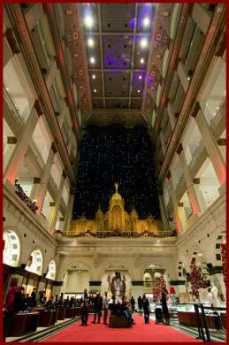 |
| Wannamakers Pipe Organ |
That's all changed, today. The pipe organ at Wannamakers, the cluster of department stores around Eighth and Market, the theater district, Caldwell's and Bailey Banks and Biddle upscale jewelers, the fancy women's clothing shops on Walnut and Chestnut Streets, and the bespoke men's tailor shops -- have disappeared in a slew of retail despond. The excited crowds of upscale shoppers have dwindled, at least in the center city shopping area. Students of sociology point to the decline of the department store as a central commotion in the center of this phenomenon, blaming that in turn on the spread of national brand names by television and more electronic forms of advertising. The department store did your comparison shopping for you, putting its brand name on the product and placing its reputation behind the choice. If Wannamaker could determine that a Japanese radio was of high quality, it became Wanamaker's radio. Today, Samsung and Sony do their own advertising, sell their products through outlets in the suburban malls. Philadelphia residents enjoy as much retail choice and pricing as ever, they just shop in the malls located along the Interstate circumferential highway, just outside what used to be the outermost suburbs. So the volume of retail shopping among Philadelphians probably hasn't changed a great deal; it has merely shifted to the malls where there is parking for your car to transport goods which the department stores used to deliver. It is the annual visits from the subordinate small cities at moderate distance that has disappeared. Small cities now have their own shopping malls, carrying national brand name merchandise. Losing this source of business, the associated entertainment industry has declined to a point below sustainability for most of them -- in the center city hub. Along with the disappearance of this regional recirculation, small cities have lost their sense of affiliation with a bigger one. The small-town professional class which was the biggest participant in this annual migration is professionally more isolated but so are their clients. The upper crust of the small town now must constrain its horizon to the smaller town professionals, with their lesser claim to distinction. For a while, the disparity can be overcome by specialization, but ultimately the distinction of the big-city specialist rests on assembling a richer experience from wider drawing power. In Medicine at least, the insistence of Medicare on paying the same fee for the same service lessens the economic incentive for self-repair of the system.
 |
| Wannamaker's Christmas Light Show |
Meanwhile, nature of Christmas itself is becoming standardized. Fewer people make their own Christmas presents, whether through knitting or baking. If the process of commercial gifts goes the full distance, eventually the joy of searching for exactly the right gift will seem more like paying your taxes. These things already cost too much, are worth too little, and neither the process of giving a gift nor the process of receiving a welcome gift will retain much joy. Or significance. What was until recently a Christian religious celebration has become diversified into a generic "Happy Holiday", presumably in order to avoid offense to other religious groups who themselves likely persist in their old traditions of ritual greeting. The assault on Christmas is however not primarily cultural, but commercial. The silent ostentation of elaborate outdoor lighting and the secular versions of Christmas carols endlessly replayed over loudspeakers in stores, probably have a more destructive effect on the community winter solstice ceremony than any competition for religious adherence.
The coming next step in the modification of the Christmas season is dimly visible in the assault of pocket telephones on the suburban shopping mall. After enjoying only a few years of victory over the center city department store, malls must now confront shoppers with portable telephones containing a camera and GPS geographical locator. Seeing something he likes, the shopper of the future can photograph its bar code in the shop display, and be immediately told of all the neighboring stores which sell the same product for a lower price. Electronics are thus about to turn Christmas shopping into an electronic auction, no doubt making it eventually easier to do the shopping from home.
What Christmastime means to me is a recollection of what it once was like at the nation's oldest hospital, and not so terribly long ago, at that. Before 1965, the Pennsylvania hospital had been staffed for centuries with unpaid student nurses, working under the direction of unpaid doctors in training, supervised by volunteer attending physicians. Of the five hundred beds, only forty were filled with paying patients and the rest were housed in long communal halls. On Christmas morning at 7 AM, the drowsy patients were astonished to be awakened by a procession of very pretty student nurses, led by Miss McClellan the grim-looking Directress of nursing, and followed by a handful of internet and residents, all singing Christmas carols and carrying lighted candles in the dark. Miss McClellan herself was never heard to utter a note, but the student nurses had been trained in four-part harmony, and the interne doctors were enthusiastic followers. The faces of the poor old indigents in the beds were filled with pure delight as we traipsed past, chanting of the travels of Orient kings, the pregnancy of virgins, and other miracles of the occasion.
Skating and Humane
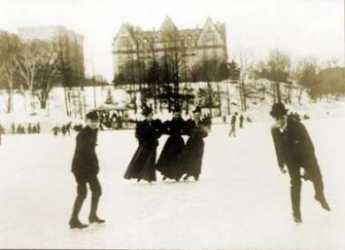
|
| Outdoor Ice Skating |
There was a time when ice skaters and rowing enthusiasts were having a little war on the Schuylkill, and the rowers won. We are indebted to our dear friend the late Elmer Hendricks Funk MD, a past president of the Philadelphia Skating and Humane Society, for some of the history.
Ice skating is both dangerous and seasonal. In the Eighteenth Century, ice skating was concentrated near the center of population on the Delaware River, and that's where you found the Skaters Club. You also found the Humane Society, whose main function was to pull drowning skaters out of the water. The Humane Society got to be quite rich because people were inclined to be sympathetic to lifesavers. In time, however, people moved away from Delaware and the two clubs, Skating and Humane, merged. No doubt the skaters thought they would be acquiring the substantial endowment of the life-saving club, but in fact, the Pennsylvania Hospital got most of the money in one of those genteel struggles that volunteer organizations sometimes get into. Skating moved from Delaware to the Schuylkill, and the club built a little house on what is now boathouse row, right next to the lighthouse.
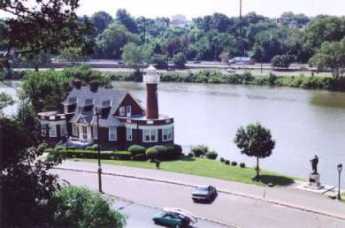
|
| Turtle Rock |
The lighthouses at Turtle Rock was useful for the southern terminus of the canal just across the river on the West Bank, and for many years there was a little canal house on the Westside, making it easier to see what this was all about. The lighthouse became incorporated into a boathouse for the first women's rowing club, but the club died out and this combined, Sedgley, is now a women's luncheon club. Next door was the Skaters and Humane, fighting to survive among all the rowers. Since rowing has a much longer season than skating, the skaters feared they would be overwhelmed. They passed a club by-law that no officer of the club could be a rower.
However, the skaters had another enemy in the ice companies, who tended to chop up the first and best ice to form in the area. And the final blow came when the Arena was built at 45th and Market Street with artificial indoor ice. So, the boathouse became the home, in 1938, of the Philadelphia Girls Rowing Club, and the skaters and lifesavers moved first to the Arena, and then to Ardmore. Haverford College was glad to sell them a swamp they owned there since it wasn't much good for a college but the local springs provided needed water for the skating rink. With a rink, skating became year-round, and there was a roof to protect against snow and rain. You can't fall through the ice in a rink.
The club had a number of lucky breaks by being first, constructing its building cheaply in the depression, being able to use ammonia as a refrigerant, and getting cheap land. There are other skating clubs, but few of them own their own rinks, and no other skating club has the national prestige of the Philadelphia Skating and Humane Society. It is the oldest, the first, the best, and the most famous. If you are anybody in skating, this is where you want to skate.
The American Friends Service Committee
Two things uniquely characterize the work of the Friends Service Committee (AFSC): it's often both dangerous and unpopular. That's not required for relief following Indonesian tidal waves perhaps, but the work that really needs someone to do is often both dangerous and controversial.
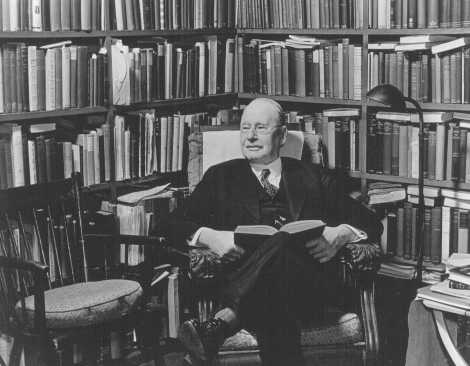
|
| Rufus Jones |
The Service Committee was founded in 1917, mostly by Rufus Jones and Henry Cadbury, as a way of helping conscientious objectors to World War I. The Mennonites, the Brethren, and the Quakers were opposed to all wars, not just that particular one, but two of those religions are of German ancestry, and lacked the same credibility of the English-origin Quakers in a war with English allies against the Huns, Boche, and Kaiser enemies. The early focus of the Committee was on the Field Service, or Ambulance Corps; which was plenty close to the action, and plenty dangerous. After the War, the defeated German population was starving, and the Quaker Herbert Hoover directed the relief effort with great credit to the Quaker name, and immense European gratitude.
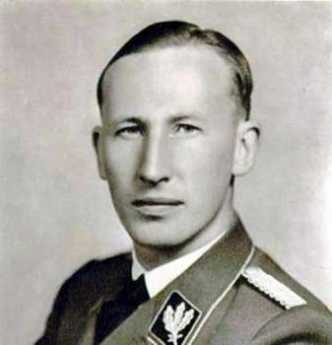
|
|
Reinhard Heydrich was the primary organizer of the mass murder of Jews in the Third Reich. |
After that, when German Jews were suffering persecution by the Hitler administration, the Quakers initially responded in a uniquely Quaker way. Rufus Jones and two other Quakers went to see Reinhard Heydrich, to tell him the world disapproved of his behavior. They fully realized they represented a pool of important world opinion, particularly within Germany, and it was time to speak truth to Power. The Germans left the room to confer, and the three Quakers bowed their heads in silent prayer. Apparently, the room was tape recorded, and when the German officials returned, they did promise some efforts to improve matters. As the situation for the Jews soon got much worse, many Quakers risked a great deal to shelter and rescue the persecuted exiles. Relief to the defeated German populace had to be repeated after that war, as well. Each effort built up more credibility to be able to switch sides for the next effort, and the sincerity has seldom been seriously questioned.
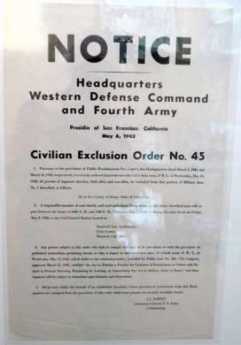
|
|
U.S. government notices to American citizens or aliens of Japanese ancestry in May 1942 that they must move to internment camps. (Photograph by Dorothea Lange.) |
The Japanese were also our hated enemies in World War II, and once more a long history helped the relief effort. Nearly 100,000 American citizens of Japanese origin were interned on the West Coast as potential traitors in 1941, often under deplorable conditions. Clarence Pickett was a director of AFSC at the time, and his sister had spent years in Japan as a missionary, so his remonstrations with the American government were prompt and credible. One of the more active workers was Esther Rhoads, sister of the famous surgeon, who had spent time in Japan earlier. One of the ingenious efforts with the Nisei was to assist 4,000 of them to get into college and find them hostels and jobs while they were away at school. Many of these college students later became prominent in various ways, greatly assisting the post-war reconciliation between the two countries.
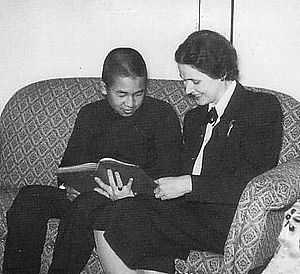
|
| Crown Prince Akihito and Elizabeth Gray Vining |
Two Quaker ladies at the AFSC made a totally unique contribution when a request was received to provide a suitable tutor for the Crown Prince, now Emperor. He didn't convert to Christianity, but he later married a Christian, and you can be sure he got a plenty good dose of Quaker style and belief from Elizabeth Gray Vining. This tall, strikingly handsome Philadelphia woman had Bryn Mawr written all over her and turned heads whenever she entered a room. When she went back home, she was followed as a tutor for seven years by, guess who, Esther Rhoads who by then was the director of the Tokyo girls school. It remains to be seen, of course, what the final outcome of this deeply emotional situation will prove to have been. At the moment, the main sufferer seems to be the immensely talented American-educated woman who married the Emperor. But we will see; these are all powerful women in a very quiet way, unaccustomed to losing. One wishes the royal family all the best in their sometimes difficult position.
And then the Service Committee did its work in Vietnam, in Iraq, in Zimbabwe, and Somalia on the unpopular side, in every case. There are stories of venturing into war zones with hundred-dollar bills scotch-taped to their torso, where every fifty feet there was someone who would cut your throat for a dime. One worker in Laos entertained a group of us tourists with tales of living for weeks with nothing to eat but grasshoppers and cockroaches. Dangerous, unpopular, and uncomfortable. It sounds like a wonderful outlet for someone who is a perpetual rebel without a cause, but if you can find one of those at the Service Committee, you must have done a lot of looking.
The Service Committee, like the Quaker school system, is mostly run by non-Quaker staff. That means that neither of them exactly speaks for the religion itself. This little religious group of 12,000 members is stretched thin to provide a vastly greater world influence than its numbers imply. Hidden in the secrets of the group is an enduring ability to attract sincere non-member adherents to their work. And a quiet watchfulness to avoid losing control to any wandering rebels without a cause.
REFERENCES
| Window for the Crown Prince: Akihito of Japan, Elizabeth Gray Vining ISBN-13: 978-0804816045 | Amazon |
Recording for the Blind and Dyslexic
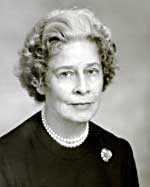
|
| Anne Mc Donald |
Anne T. Macdonald developed the idea in 1948 that a large number of blinded war veterans would benefit from recorded textbooks. Starting at the New York Public Library and now with a national headquarters in Princeton, a string of 29 centers have appeared across the nation, with an average of 7000 volunteers contributing their time reading textbooks into recording devices. The Philadelphia effort started at 36th and Market and has since moved to King of Prussia, where 280 volunteers read in teams of two, one inside the recording booth, and the other outside following the performance and stopping it for errors or muffled recordings. Since the effort specializes in technical textbooks, there is a constant search for specialists in particular technical fields. It is particularly important to understand the technical nature of the material when pronunciation is difficult, and when complicated graphs or illustrations need to be described for a blind audience. Originally, the material was produced on reels of tape but tends nowadays to concentrate on CDs and other disc recording devices.
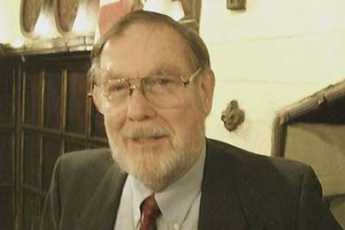
|
| Ralph Cohen |
Ralph Cohen, himself a volunteer reader, very kindly described the enterprise to an audience at the Right Angle Club of Philadelphia recently. It is particularly heartening to hear stories of blind persons receiving advanced technical degrees because of the availability of these recorded texts, even stories of those who rose from menial jobs to become engineers through this pathway.
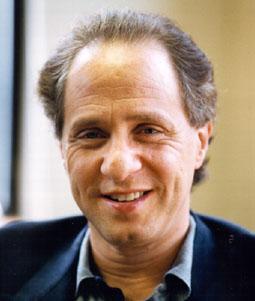
|
| Ray Kurzweil |
For those who have a particular interest in the topic, a few facts are important to know. Volunteers in technical fields are particularly needed, with two-hour recording slots extending over a relatively long time until a text is completed. Contributed money is needed in order to buy equipment and house it in a soundproof environment. Because of concern about copyright infringement, it is necessary to insist that the recorded products are only available to members of the reader's group, each one certified to be in need of such material because of a physical handicap. There is a fee of $65 to enroll, with $35 annual dues.
An interesting sidelight on reading difficulties emerges from the fact that most people who need help can see perfectly well. The disorder of dyslexia is so widespread that probably a majority of the population has at least a trace of it. The underlying problem with dyslexia lies in the brain, not in the eyes. The most common variant is to invert the sequence of words or letters, making such people utterly unable to record or remember a telephone number in the correct sequence. Often, psychological difficulties follow, as impatient siblings and acquaintances describe the victims as "stupid", a slur they often come to believe, themselves. A learning difficulty leads to a lack of learning, and the deficit becomes a real one. To the degree that these Recordings for the Blind and Dyslexic allow some to conquer their handicaps gives hope to others. One can even hope to see the whole matter unwind into a revision of the educational process, leading to a better and more prosperous society.
By an interesting coincidence, 1948 was the year Ray Kurzweil was born in Brooklyn. Developing an early interest in computers, his name is now associated with synthetic speech and voice recognition technology, and he has even branched out into music synthesis. He's a visionary, all right, and a promoter. If voice transcription gets tweaked just a little more, it is going to replace dictaphones and secretaries by the hundreds of thousands. No doubt Kurzweil is destined to become very rich if indeed he is not already so. It's thus a little startling to encounter him as a professional entertainer on the lecture circuit, apparently driven relentlessly by a need to be appreciated. If that's what he needs, let's give it to him. The transformation of half of our society seems within his grasp. And in many ways his success is based on the flash of insight that dyslexic people are not stupid; in fact, maybe no one is. We all walk around with computers in our skull, and computers are always full of bugs. No doubt it should be said of brains, as it is of computer programs, that one has never been created that did not contain many "bugs". The important issue is not whether the computer is defective, but whether it somehow mobilizes the effort to overcome its defects.
WWW.Philadelphia-Reflections.com/blog/1182.htm
Police Athletic League
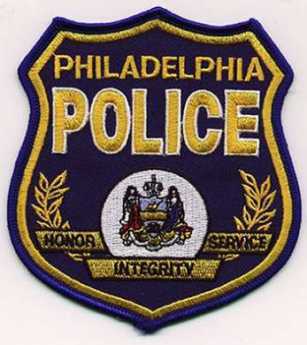
|
| pal |
T he Philadelphia chapter of the PAL is now almost sixty years old; that means its origins are to be found in the great industrial migrations and urban dislocations of World War II. Philadelphia has experienced many upsurges of crime in its long history, and almost without exception crime centers in new immigrant groups. Commentators on prison conditions over the centuries have always remarked on the over-representation of whatever is the most recent immigrant group among the inmates. Crimes related to recreational drugs may be an exception, just as crimes related to bootlegging were an exception during Prohibition. Or maybe not; perhaps issues of that sort merely affect the type of crime and the reason for committing it, while the criminals themselves continue to concentrate in the most recent immigrant population. It is merely to face the plain facts to notice that the war industries attracted large immigration to Philadelphia of African-Americans, so the recent-immigrant crime wave centered in them. There's actually hope in that if we keep calm about it. It means that crime can in time be expected to settle down, just as it did after the waves of immigration of Irish, Germans, and Scotch in earlier centuries. This wave of immigrants from the Southern states will surely be assimilated, too. Police records show that most crimes are committed by teenagers, committed between 3 PM and 9 PM. The aim of the Police Athletic League is therefore clear: keep teenagers busy and off the streets between 1 PM and 9 PM. The 27 centers of PAL, with nearly 30,000 participants between age 6 to 18, have a budget of over $2 million a year, all privately donated. The contribution of the City Government is to supply police officers to staff the centers, and that is an unexpectedly important thing to do. One might suppose hostile teenagers would be turned off by the presence of "the man", the stormtrooper of the enemy, and perhaps some are. But the presence of police in every center means that PAL is safe when very little else is safe for lower class teenagers. And of course, it is important for teenagers to learn that cops are people. Lots of cops are nice guys who will help you. Lots of cops used to be members of PAL, themselves. A men's luncheon club to which I belong donates the profits from a weekly lottery to PAL, and consequently, a speaker from the League is sent to thank us by giving a talk once a year. The Police Athletic League is clearly evolving. It started out with only programs in boxing and basketball, rather obvious choices. But now, the example of Tiger Woods has stimulated a great deal of interest in golf, which takes place on the loan of time at five local golf courses. Many famous civic leaders are involved in the governance of this organization, and recently the Lend fest family has been especially generous. You can look forward to a large well equipped PAL center soon, at Luzerne and 12th Streets, based on their generosity. It will have, among other things, squash courts, no less. Squash started out as a game in debtor's prison, but it currently has the image of upper-crust exclusivity. It's important to do things like that. And the activities of PAL have further evolved away from prize-fighting into computer classes. A popular new development has been a mathematics competition. It would go too far to say that PAL has saved a whole generation from living the life of the streets. But it's making progress which is very heartening to see.
Main Line School Night
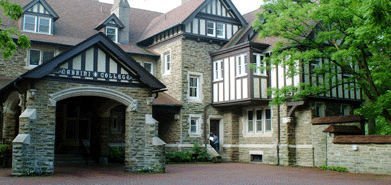
|
| Radnor |
There's a lot to learn from the Main Line School Night, and it isn't all taught in the classroom. The basic idea is life-long learning, going to school because it's fun. The idea started five or six decades ago in the Radnor, PA high school, that a lot of educated people wanted to become still more educated in topics of their own selection. No tests, please, and forget about academic credits; most of the students already have an excess of them. Forget about improving your income with advanced degrees; since this is Main Line Philadelphia, quite a few of the students already have all the income they could ever want. As related by the very low-key president of MLSN, David Hastings, the idea was an almost instant success. There were 1200 students enrolled for the second semester. They outgrew the original high school, and now teach courses in seven schools among 40 locations, to 14,000 students a year. There are 400 teachers in any given year, and the tuition charged is aimed at breaking even on the overhead. The academic world is inclined to say the courses lack rigor, by which is partly meant that if the students don't like the course, they walk out. Volleyball, yoga, and nutrition certainly do have a California sound, but computers, foreign languages, and science can be as difficult as you want to make them. If you get serious about contract bridge, you soon learn that isn't a simple child's game. Courses in wine tasting are given in the local senior citizens' retirement communities, but mostly not to the residents. It's not welcome to give that sort of course in a high school. To some extent, this continuing education is an exclusive social occasion, but then so is a course in diplomatic history at Princeton. Mr. Hastings tells of a group of sixteen ladies in a bridge course who have been coming for years, and have learned to close the course rolls by all sending in their checks on the day of registration. This is, after all, the Main Line where exclusionary techniques once learned are hard to forget. There are clouds on the horizon. In the past three years, enrollment has leveled off and declined a little. Almost no major corporation continues to be successful for more than seventy-five years, and many of the people running Main Line School Night are drawn from the Executive Service Corps. In retrospect, for example, the owners and editors of the Saturday Evening Post should have sold out and closed down, as soon as they learned the first million television sets had been sold. Perhaps the decline of enrollment of Main Line School Night reflects the advent of the Internet, or the cell phone, or some other new technological competitor. Or maybe the venture just got too big and successful to maintain its original format; perhaps it's outgrowing its blood supply. But anyway, they have 14,000 students and can be proud to be in a resting phase, when the rest of the city, or state, or country, hasn't even tried to get started on such a project.
George Willoughby, 95, Peace Activist
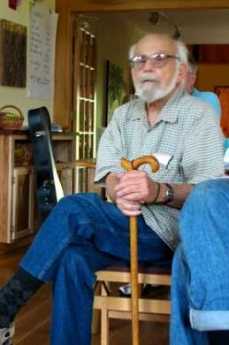
|
| George Willoughby |
Age was nothing but a number for 95-year-old peace activist George Willoughby of Deptford. His worldwide antiwar protests and nonviolent teachings started when he was in his mid-40s and continued until just weeks ago.
Mr. Willoughby was planning a six-week trip this month to India to meet friends he had made during visits to the birthplace of his idol, Mohandas K. Gandhi, and probably to give some of his trademark peace talks.
But Mr. Willoughby died at home of heart failure Jan. 5, a month short of the journey.
A Quaker who led local protests and famous treks from San Francisco to Moscow and from New Delhi to Beijing, Mr. Willoughby recruited many advocates for nonviolent conflict resolution, said a friend and member of the Central Philadelphia Meeting, Nicole Hackel.
"Once you experienced him, you didn't forget him," Hackel said, adding that she became a Quaker in the 1970s because of Mr. Willoughby's influence. "George would engage in conversation with anyone, even a 5-year-old who was attending a meeting for the first time."
Mr. Willoughby became a household name for area Quakers after he became director of the Central Committee of Conscientious Objectors in Philadelphia in 1954. He soon was a frequent presence in the news, mostly under headlines with the words peace, marchers, and protest.
In 1958, Mr. Willoughby was one of five crewmen on the sailboat Golden Rule who received 60-day jail sentences in Honolulu for trying to sail to the area of the Pacific Ocean where the U.S. government was testing nuclear bombs in the atmosphere.
That was Mr. Willoughby's first of many incarcerations, said his son, Alan.
"The Society of Friends in Honolulu brought him a lot of decent food. . . . He always spoke highly" of the Hawaii jail experience, his son said with a slight laugh.
Two years later, Mr. Willoughby organized a dual-continent march to protest nuclear testing. Protesters in groups of about a dozen each covered six countries in 10 months between the United States and the Soviet Union.
Mr. Willoughby joined the group in Poland. Soviet officials stopped them 100 yards short of the Lenin-Stalin tomb in Moscow's main square, according to reports at the time. Instead of delivering speeches, the group was forced to stand in the square in a silent vigil.
In 1963, Mr. Willoughby embarked with about a dozen others on what he intended to be his longest hike - 4,000 miles from New Delhi to Beijing to promote peace between India and China.
Before his journey, a Philadelphia Evening Bulletin reporter asked whether there was a better way than marching to bring about peace.
Mr. Willoughby responded: "Most people of these countries walk; we can reach them. Even if it does no good at all, it is worth it. It's an idea I believe in, and if it produces fruit, so much the better."
After eight months of walking, Mr. Willoughby and company were stopped at the India-China border and barred from crossing into China.
In the next three decades, Mr. Willoughby's projects included the formation of A Quaker Action Group, which opposed the Vietnam War, in 1966; the Life Center Community in West Philadelphia, a training and campaign center for nonviolence, in 1971; and Peace Brigades International, a human-rights group, in 1981.
One of his most memorable contributions to South Jersey, family and friends said, was the creation of the Old Pine Farm Natural Lands Trust, 45 acres of natural conservancy in Deptford.
In his later years, Mr. Willoughby received honors around the world for his peace work, such as the Jamnalal Bajaj Foundation award in 2002 in Mumbai, India, which recognizes those who promote Gandhi's ideas and values.
Born in Cheyenne, Wyo., Mr. Willoughby spent much of his childhood in the Panama Canal Zone, where his father worked in construction.
Mr. Willoughby was part of his high school's JROTC program, but, according to friend and biographer Gregory Barnes, he quickly realized the military was not for him.
A family rift led Mr. Willoughby to live in Des Moines, Iowa, with a family friend, Elinor Robson. In the 1930s, he received three degrees in political science, including a doctorate from the University of Iowa.
In 1940, Mr. Willoughby married Lillian Pemberton, a "birthright Quaker" he met in college. By 1944, he became a Quaker, fully immersed in the Religious Society of Friends' beliefs and ideologies.
In the late 1940s and early 1950s, Mr. Willoughby worked for the Des Moines office of the American Friends Service Committee before moving to Philadelphia with his wife and their four children.
After bypass surgery in 2000, Mr. Willoughby had to slow down. He wasn't able to participate in as many marches and rallies as he would have liked, his son said, but he remained active online.
One of Mr. Willoughby's last protests was in March 2003, an organized obstruction of the entrance of a federal building in Philadelphia to protest the war in Iraq. He took photos of his 89-year-old wife getting her head shaved as part of the demonstration.
"I've never seen her like that, but I like it," he told a reporter. Lillian Willoughby died last year.
One of Mr. Willoughby's last speeches was at Scattergood Friends School in Iowa a few months after his wife's death. He took a road trip with Hackel and one of his daughters to the Scattergood refuge camp's 70th-anniversary reunion, which was held at the school.
Once there, Mr. Willoughby did what he did best: talk. "He just fascinated the young people there," Hackel said.
Some of Mr. Willoughby's last words of advice were: "It is the duty of the opposition to oppose," his son said. "He thought it is your duty to speak up . . . for what you believe is right."
In addition to his son, Mr. Willoughby is survived by daughters Sally, Anita, and Sharon and three grandchildren.
A memorial service will be held at 2 p.m. Saturday at the Friends Center at 15th and Cherry Street
SCORE
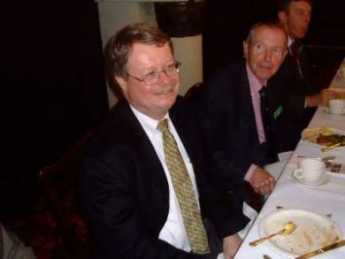
|
| Mark Maguire |
Frank Pace, formerly Secretary of the Army, founded SCORE, the Service Corps of Retired Executives, in 1964. Philadelphia was one of the main founding chapters but tended to dwindle as business large and small dwindled after the bombing of West Philadelphia by the then-Mayor; former executives living in the suburbs lost interest. In December 2006, Mark Maguire took charge and gave SCORE a new direction. This former executive of Rohm and Haas is not related to the baseball home-run king, but at least his name is easy to remember.
The new sociology of center city demanded that more small businesses be started by minority residents, who have very little family and cultural experience in this sort of activity, which nevertheless is recognized as the main source of job creation in any area. It turns out that the main source of energy in the minority community is among minority women, who are particularly unfamiliar with the problems of small business. So, SCORE needs to dispel a number of misconceptions and unrealistic ambitions, and familiarize these budding entrepreneurs with the tax and regulatory headaches ahead of them, and teach them to be watchful of common traps and obstacles, learn to cope with fair competition, and how to recognize the signs of fraud before it happens to them.
The usual vehicle for teaching these elements of commercial life is to induce the writing of a detailed business plan, which executives can criticize for lack of realism or inadequate capitalization, suggesting ways to succeed in a field that experiences 50-60% failure in the best of circumstances. Some of this requires face-to-face discussions, lectures, and required reading. But much of it can be handled with weekly email consultations, a favorite tool of Philadelphia's SCORE chapter. Much of it can be addressed by referring the client to the proper agency or service business, or bank. SCORE has a strict ethical code for its volunteers, including a prohibition of becoming a vendor or participant in the business.
In addition to the changing nature of new small businessmen, there is a changing demographic of the volunteer executives who do the advising. Over 80% of them describe themselves as retired, but in fact, it is rare for one to be totally retired from all business activity. These guys really like to work, and a thirty-year vacation is not their goal in life. Just by acting as an example, they are establishing an important goal for the young businessmen and women who look to them for guidance. Work is how you accomplish something in life, and work, believe it or not -- is fun.
www.Philadelphia-Reflections.com/blog/1430.htm
Block Captains
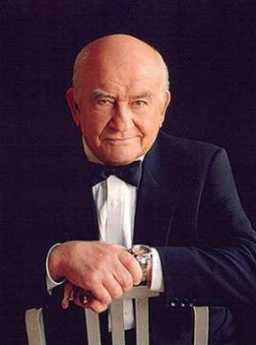
|
| Ed Asner |
A block captain is not a ward leader, at least not most of the time. The block leaders of Philadelphia are mostly self-appointed, de facto captains, and yes, they are mostly middle-aged black ladies. Their attitude is that politicians are there to serve the community, not the other way around. At a recent meeting, the leader of the Block Captain's Association called out to the nodding, approving group, "Call your councilman. We elect those people, put 'em to work!"
This enthusiastic group of several hundred grass-roots leaders meets several times a year in, of all places, the hallowed auditorium of the Philadelphia County Medical Society, but doctors are not running this show. Nor is the City Health Department, nor the Department of Streets, nor the various mental health and social service agencies that send representatives. The federal government expressed considerable gratitude in being able to address this group because their new Medicare prescription card was so terribly hard to explain (i.e. it was terribly hard to understand). The genius of the block captain movement is that it appoints leaders to understand what the establishment is trying to say, and then figures out a way to say it. You can make free flu shots available, even take them to the home or workplace, but most people won't accept them unless it is explained by someone they trust. Dead birds don't spread disease, mosquitoes do, but that really sounds a little unlikely. To believe that, you first need the word of a respected local leader. The U.S. Army is built around its sergeants, in the same way. That's in fact how things work at every social level, but in Philadelphia's black communities, it is finally becoming organized. For example, they like pamphlets. Pamphlets are what give sergeants credibility back in the neighborhood.
Success has a thousand fathers, failure is an orphan, so it's now hard to know who started this. Eve Asner, the sister of Ed Asner the movie star, can claim credit for starting a group called Philadelphia More Beautiful, dedicated to cleaning up the messes of the slums, and applying social pressures of a loud and effective sort to irresponsible neighbors. And then, along came the Deputy Health Commissioner Larry Robinson with HEAT. During a hot summer, it was possible for a hundred children and old folks to die of heat prostration because they were confused by dehydration and did things which made matters worse for themselves. The block captains were ideally situated to know who was in danger, who hadn't appeared outside in a day or two, and thus who might need to be forced to drink water or go to an air-conditioned movie. Training the block captains to recognize the signs of trouble fit nicely into the Health Department's ability to measure results with computers. Last year, only seven people died of heat prostration, and everybody knows whose block they lived in.
The Medical Society pays for everybody's lunch at the block captain's meeting, and it is a calculated policy. Every doctor knows how useless it is to talk in terms of calories, carbohydrates, high unsaturated fat content, and water-soluble vitamins. Pamphlets help, but what really works is to serve the block captains a lunch and tell them, now this is what we're talking about. Heaven only knows how that gets translated back in the neighborhood, but surely the first step is to give the block captain an unmistakable message. The Medicare bureaucrat looked visibly relieved when her painfully convoluted explanation of the Medicare prescription card was reduced to about two sentences by questioners in the audience: If you have Medicaid coverage, forget it. If you don't, that card's worth about $600. And this here pamphlet proves I know what I'm talking about.
There did not seem to be a scrap of ideology or power hunger or self-serving -- the usual hallmarks of politics as we commonly observe it. The over-riding principle on which these highly disparate groups are operating together is, pick a problem, and solve it.
Kenneth Gordon, MD, Hero of Valley Forge
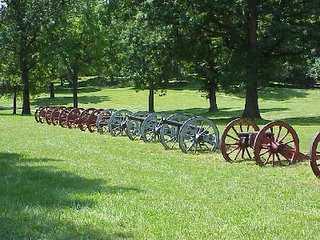
|
| Valley Forge |
There's no statue of Ken Gordon at Valley Forge National Park, although it would be appropriate. No building is named after him; it's probable he isn't even eligible to be buried there. But there would be no park to visit at Valley Forge without his strenuous exertions.
One day, Ken's seventh-grade daughter came home from school with the news that the father of one of her classmates said that Valley Forge Park was going to be turned into a high-rise development. That's known as hearsay, and lots of things you hear in seventh grade are best ignored. But this happened to be substantially true. At that time, the Park was owned by the Commonwealth of Pennsylvania, and Governor Shapp was finding the upkeep on the Park was an expense he needed to reduce. The historic area had two components, the headquarters area, and the encampment area. One part would become high-rise development and the other would become a Veteran's Administration cemetery. Although any form of rezoning has the familiar sound of politics to it, Dr. Gordon (a child psychiatrist) had the impression that Sharp was mostly interested in reducing state expenses, and had no particular objection to some better use of the historic area. At any rate, when Gordon went to see him, he said that he would agree to a historic park if Gordon could raise the money somehow. The Federal Government seemed a likely place to start.
Well, the sympathetic civil servants at the National Park Service told him how it was going to be. You get the consent of the local Congressman (Dick Schulze) and it will happen. If you don't get his consent, it won't happen. It seemed a simple thing to visit that Congressman, persuade him of the value of the idea, and it would be all done; who could refuse? After the manner of politicians, Schulze never did refuse, but somehow never got around to agreeing, either. It takes a little time to learn the political game, but after a reasonable time, the National Park employees told Gordon he was licked. Too bad, give up.
He didn't give up, he went to see his Senators, at that time Scott and Clark. They instantly thought it was a splendid idea, and instead of going pleasantly limp, they sent Citizen Gordon over to see Senator Johnson of Louisiana, the chairman of a relevant committee. Johnson also thought it was a great idea, and called out, "Get me a bill writer!" A bill writer is usually a government lawyer, tasked with listening to some citizen's idea and translating it into that strange language of laws -- section 8(34), sub-chapter X is hereby changed to, et cetera. Bill writers have to be pretty good at it, or otherwise, they will misunderstand the intent of the original idea, modified by the personal spin of the committee chairman, the comments of the authorizing committee, and later bargains struck in the House-Senate conference committee. Having negotiated all those hurdles, a bill has to be written in such a prescribed manner that it won't be found to have multiple loopholes when it later reaches the courts in a dispute. A good deal of the time of our courts is taken up with making sense of some careless wording by bill writers. That's what is known as the "Intent of Congress", an ingredient that may or may not survive the whole process.
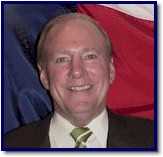
|
| Dick Schulze |
Ken Gordon had to go through this process, including testimony at hearings, for three separate congressional committees. To get everybody's attention, he organized several hundred supporters to write letters and get petitions signed by several thousand voters. These supporters, in turn, influenced the media and started a lot of what is known as buzz. All of this is an awful lot of work, but there is one thing about this case that can make us all proud. Not once did a politician suggest a campaign contribution was essential in this matter.
In time, ownership of the Park did in fact migrate from the Commonwealth to the U.S. Department of the Interior, hence to the National Parks Service. Everyone agrees it has been well managed, and increasing droves of visitors come here every year. It is now clearly a national treasure. Unfortunately, the encampment area got away and has been commercially developed, although not nearly as high-rise as originally contemplated. Along the way, many discouraging words were spoken about the futility of fighting against such odds. The outcome, however, is the embodiment of two slogans, the first by Ronald Reagan. "It's amazing what can be accomplished, if you don't care who gets the credit for it." The other slogan is older, and Quaker. All you need, to accomplish anything, is leadership. And leadership -- is one person.
One day Ken Gordon, the very busy doctor, was asked how much of his time was taken by this effort. His answer was, ten hours a week, every week for five years.
Old Blockley (P.G.H.)
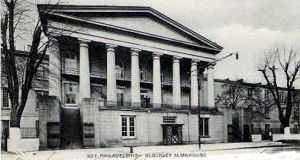
|
| Old Blockley |
For a long time, the Philadelphia General Hospital was the largest hospital in town, even growing briefly to seven thousand patients during the Civil War, but leveling off at about three thousand at the beginning of the Twentieth Century. At the end of World War II, it had shrunk to about 1500 beds, but it was Medicare and Medicaid in 1965 which finally did it in. By 1977 it was costing the City of Philadelphia about five million dollars a year beyond its revenues to run the place with only 300 patients, while the running expenses of the local private hospitals were actually less, per patient. Titles XVIII(Medicare) and XVIV(Medicaid) of the Social Security act constituted Lyndon Johnson's Great Society, and in effect they made every patient at PGH resemble a walking government check in the mind of hospital administrators. The local hospital association made the argument to the Mayor Rizzo that everybody would be better off if the hospital closed and those government checks were directed to the local voluntary institutions. After a few years, the federal government inevitably squeezed the generosity out of the bargain they would of course now like to abandon. But that's the way it goes. PGH is gone and it isn't coming back. The eighteen acres in Blockley Township, now West Philadelphia, were given to the University of Pennsylvania next door, and gigantic amounts of federal money were contributed to the building of skyscrapers replacements for the original PGH. Ironically, the two hundred children's beds now on the location are fewer in numbers than the three hundred adults once considered too uneconomically few to maintain, and the cost per day of hospitalization is roughly ten times the PGH cost which had been described as unsupportable. The rest of the real estate is built up with buildings involved in medical research, which is also an activity dedicated to working for its own extinction. Discovering a cheap cure for cancer would quickly create a need to fill the vacancies with something else. No one regrets this system of creative destruction, but everyone should regret the diminution of the spirit of local philanthropy which underlay it.
PGH was one of a dozen or so big-city charity hospitals, like Bellevue in New York, Charity in New Orleans, or Cook County Hospital in Chicago. Of these hospitals, PGH had surely been the best, and at the turn of the Twentieth Century a Mayor's commission issued a report about the place which began, "Philadelphia can surely be proud...." Having worked in Bellevue and having visited most of the rest, I can testify that was likely true. When PGH was finally torn down, the walls and floors had such substantial construction that changing the wiring and plumbing to some other purpose had become almost impossible. The PGH nurses were famous for running. Although the alcoholic and drug-addicted patients might be called the dregs of society, the alacrity of the student nurses in running them bedpans or answering other calls, was spectacular to watch. When a doctor came on the floor, they jumped to their feet and were usually ready with the patient's charts, unmasked. Unlike Bellevue, where the floors were creaky and wooden, the open wards at PGH were spacious, clean, well maintained and equipped. At Bellevue, the forty-bed wards were crowded with sixty or seventy patients, so close together you could almost roll from one end of the room to the other without touching the floor. I can remember seeing one seventeen-year-old Bellevue student nurse tending such award at night alone, the intern sharpening needles, and the medical resident developing electrocardiograms in the darkroom. None of this would have seemed acceptable at PGH.
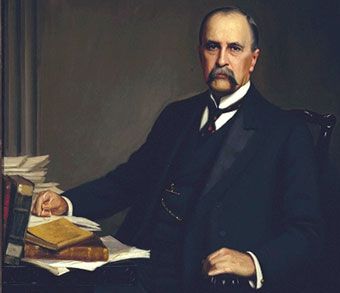
|
| Dr. William Osler |
Old Blockley was the place where modern systems of medical education originated. Up until William Osler came to Philadelphia, medical education mostly consisted of attending eight hours of lectures a day. Osler had an electrifying personality and wandered among the sick at PGH with a train of students following him. He is much quoted, and once suggested his obituary ought to read, "Here lies the man who took the students into the wards." A somewhat more elegant statement of the value of the practical experience was included in his dedication speech at the Boston Library: "To treat patients without books is to sail an uncharted sea. To read books without seeing patients is never to go to sea at all. Osler was somewhat underappreciated during his time in Philadelphia and went on to found the medical school at Johns Hopkins in Baltimore. Nevertheless, the main reason he later left John Hopkins and went to Oxford was his dismay at the adoption of the "full-time" system, which is to say the faculty stopped having a private practice of their own to act as a gold standard for their research and teaching. When all is said and done, there are some areas of discomfort in the transition of students from observers to actors. The PGH system of learning surgery was commonly reduced to a slogan, "See one, do one, teach one,"; things have progressed to the point where it is probably right for the public to insist on greater supervision and control than the old almshouse provided.
The disappearance of old Blockley ended a controversy, or even something of a mystery, about which was the oldest hospital in America, PGH or the Pennsylvania Hospital at 8th and Spruce. There had been an infirmary in Old almshouse at Eleventh Street, and there is no doubt the almshouse was there first. PGH grew out of the almshouse. However, there were many comments at the time of the founding of the Pennsylvania Hospital that it was now the first; that's a strange thing to say when the almshouse was three blocks away. Social historians need to look into the mindset of colonial America, which seems to have included the distinction between the worthy poor and the unworthy poor. Somehow, the founding principal of the Pennsylvania Hospital was to get people back to work who were capable of productive work, possibly even paying for itself in that way. In their minds, apparently just giving solace and help to those who were down and out was not quite the same thing.
Please Touch
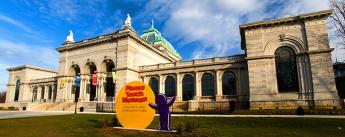
|
| Please Touch Museum |
There had been rumors for some time that the Please Touch Museum was planning to move from 21st Street to larger quarters, but recently its Executive Director Laura Foster appeared at a luncheon at the Franklin Inn Club to announce definite plans. The Museum moved into Memorial Hall in West Fairmount Park in the fall of 2008.
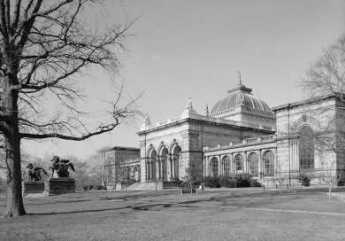
|
| Memorial Hall Fairmount Park |
There are over 400 children's museums in the world, and the first one was started in Brooklyn in 1899. Just why Philadelphia waited until the Bicentennial Celebration in 1976 to start one, is not clear. It's particularly unclear when you hear of its explosive success. Growing rapidly during an era when museums of all sorts are seeing declining attendance, the Please Touch Museum will be making its fourth move in thirty years, each time to larger quarters because they needed more room. Sooner or later, expansionism will get its comeuppance of course, and Memorial Hall is one awfully large building to fill. And to heat, and to paint, and to air condition. The price is right, however. The City Administration, which approached the museum with a proposal, has offered an 80-year lease for a dollar. When you hear that they have occasionally had 1500 visitors in a single day, however, and annual attendances approaching 200,000, almost anything seems possible.
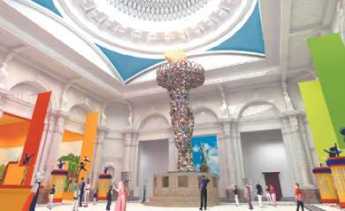
|
| Liberty Torch |
There are certain limits. Nothing frightens a 4-year-old like a herd of 10-year-old boys racketing about, so there are segregations necessary. In other situations, these little kids not only can't touch, but they also can't see and they want to see badly. And the sociology is interesting. The kids may well clamor to come when they hear other kids talking, but in general, it is the parents who get the idea that a museum trip would be fun. And the parents seem motivated by theories of upward mobility, of giving their child a "leg up" on the competition. The museum is certainly filling a need, but you have to wonder where our society is headed if a picnic in the park is mainly a good idea if it gives junior a leg up.
Meanwhile, keep tuned. To fill up that monstrous Memorial Hall will take publicity, and these gals sound as though they mean to have a lot of it.
Urban Bridges

|
| Reverend Mary E. Laney |
The Reverend Mary E. Laney recently told the Right Angle Club about her experiences in an Episcopal mission church, along with the history behind this innovation, and the establishment of a 501(c)(3) organization to help the idea on a national level. That may mean no more to readers of this site than at first it probably did to the Right Angle Club, before Mary Laney made it all come alive. It was quite moving.
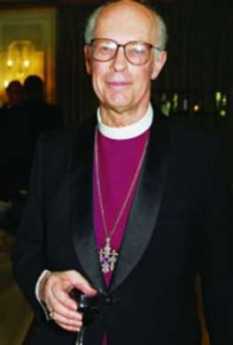
|
| Bishop Alan Bartlett |
During the 1980's she asked Bishop Alan Bartlett, at that time the Bishop of Eastern Pennsylvania for the Episcopal Church, if she might be assigned to an urban mission. As ethnic and religious population migrated around the Philadelphia landscape, quite a few Episcopal churches have been stranded in economically depressed neighborhoods, unable to afford a full-time pastor. The concept of a mission church was developed as a designation for churches that had dwindled to the point where only a handful of parishioners were left and were assigned to a category in which the Bishop would appoint a part-time Vicar to be in charge of what then needed financial support from the main church. Although in a sense Bishop White started the idea two hundred years earlier, there were no mission churches in Philadelphia in colonial times, but there are now over fifty of them, a quarter of the Episcopal churches in the region. Reverend Lancey was assigned to St. Gabriel's at the corner of Front Street and Roosevelt Boulevard, and stayed there fifteen years. She is now with St. Christopher's in Gladwynne.
The initial concept was to identify eight lead mission churches, build them up to be self-sustaining, and then replace them with eight new ones. With all good will and hard work in the world, this concept failed, largely because the social conditions of the poor at that time also depressed their educational level, and had instilled in them a culture of constant failure. In one telling episode, the parishioners said there was no hot water in the church. As a matter of fact, the pilot light of the hot water heater had gone out, and the parish was so sunken in the mindset of failure and despair they had not even looked into it. Mary Laney decided something had to be done to change the model.
What seems to have worked was the creation of a 501(c)(3) organization called Urban Bridges. The original idea behind this organization was that since the Constitutional separation of church and state precluded government grants to church no matter how struggling, but perhaps a tax exemption would make it possible for private donations to accomplish what was needed. There was, in addition, the sad experience that whenever the constitution barriers had somehow been overcome by circumvention, the many layers of bureaucracy usually consumed the money. It had proved disheartening to see four or five years go by after a government grant, with not a cent getting to the programs and all consumed by consultants, advisers and supervisors.
Meanwhile, the poor parishioners continued to base their hopes on this sort of relief, while neglecting things which might be more effective.
The Urban Bridges program evolved from a primarily fund-raising organization into a system of partnerships between prosperous suburban churches and the struggling urban missions. The suburban churches proved to be inspired with a wish to help but frustrated by a lack of means to do anything effective. It thus evolved that the suburban Episcopal churches supplied what was really most needed: practical examples of leadership on a local level, combined with visible evidence of successful effort. Literacy courses, drum and bugle instruction, computer tutoring and a variety of other spontaneous activities led to the example of leadership, and in the long run, was a far more effective fund-raising tool than printed appeals and button-holing. Even in the case of crime, it was the leadership that made the difference.
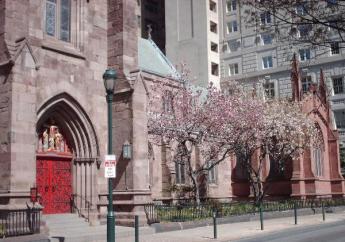
|
| St. Christopher's Church |
The story was told of a drug dealer in the neighborhood who dominated the streets with dogs and blocked access to schools unless the children agreed to sell drugs for him. Local police had proved unhelpful, and hopelessness was rampant. What would prosperous suburbanites do in such a situation? Obviously, suburbanites would not stand for such a situation and called in the Federal Drug Enforcement Agency. The crook was promptly deprived of his dogs and now resides in jail. That may not be wholly in the spirit of peaceful reasoning, but it's the American Way, all right. This was what seemed to be missing in the culture of poverty. It's the determination that whatever the cost, intolerable things will not be tolerated, combined with absolute faith that the system does provide ways to be effective without becoming either lawless or wards of the state. This is America, right?
Loaves and Fishes
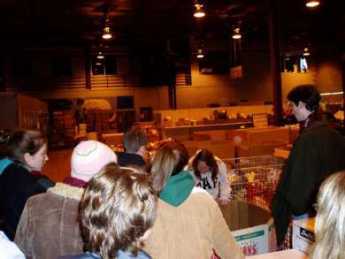
|
| Philadelphia Food Bank |
Philadelphia is full of people and institutions that have done wonderful things without a lot of fanfare and hype, butPhilabundance and its executive director, Bill Clark, surely set some sort of record. The organization has been in existence for twenty years and is generally known as a nice charity that gives surplus food to poor people. And how.
With a four-million dollar budget, they distribute food at a cost of about ten cents a meal. From that, you can easily calculate they are both efficient and big, very big. For a long time, they collected left-over food from restaurants and caterers and gave it to poor folks in shelters. But that was before someone had the brilliant idea to hire an executive director who had formerly been an executive in the supermarket business, rather than a dietician or a social worker or a retired lawyer. Nowadays, Philabundance still takes the calls from restaurants and caterers but refers them to some local food bank to do the pickup. And it doesn't distribute food to the poor itself, instead, it helps new churches get established in poverty regions, showing them how to organize and run food distribution agencies, or stores or kitchens.
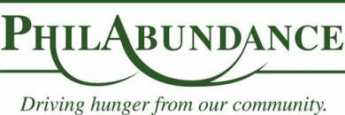
|
| Philabundance |
Philabundance is going for big deliveries, and cutting the big costs in the food chain. Clark knew who was dumping the food, by the carload, and it wasn't restaurants. He organized a system of collecting bread from major bakeries, fruit from major importers, meat from the food distribution center -- in carload lots. Someone from inside the food distribution system knows how tightly organized the shelf life is, and if he can get bananas to his eaters in five days, he can have them free from people who absolutely must have eleven days to get them through a delivery chain of fussy people picking and choosing what is on display before they buy. In a market system where food is routinely discarded in order to maintain stable prices (ask any farmer), someone who knows what he is doing can really get some bargains for the poor. You have to know about taxes, too. Donations of food are not just deductible at cost, but at cost plus half of the normal mark-up. A great many of the cargo containers arrive at Philabundance warehouse, unopened because they arrived too late for the weekend buying rush, and would otherwise have to be sold at low Monday prices. There's a lot to learn about this business.
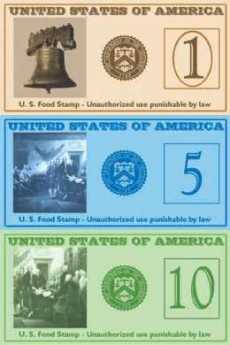
|
| Food stamps |
Food stamps might be a better way to distribute food to the poor, but big cities have an acute shortage of supermarkets, as you soon learn if you live there. New York has an extensive system of neighborhood mom and pop groceries, but Philadelphia doesn't. It's hard to know whether mom and pop stores can't survive in Philadelphia for some reason, or whether New York's notoriously political-legal system is slanted in favor of them, along with rent-controlled apartments on Park Avenue. Supermarkets in center city are hampered by the underlying supermarket the assumption that there will be ample place to park a car at both ends of the shopping trip. Since it is easy to pay $300 a month to park in center city, and even then you find the attendant may have parked someone else in the aisles, you can see that the supermarket idea, which largely developed in Philadelphia in the first place, is more popular in the suburbs.
So, anyway if you are going to throw food away you might as well give it to the poor and get a tax deduction. And if you are going to give food to the poor, you might as well be efficient about it. No doubt there will be some who raise the point that making things free for the poor will attract more of them into the region, raising Medicaid costs and so on. Maybe that's why Bill Clark draws so little attention to the splendid job he is doing, but if so, we really must betray him.
Sacred Places at Risk
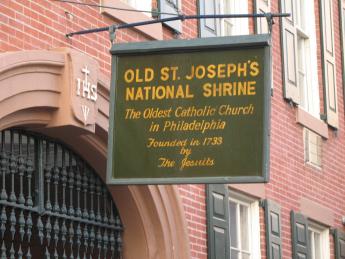
|
| Old St. Joe's |
When William Penn invited all religions to enjoy the freedom of Pennsylvania, he created a home for the first churches in America of many existing religions, and furthermore the founding mother churches for many new religions. Regardless of the local congregation, there is obviously a strong wish to preserve the oldest churches of the Presbyterian, Methodist, United Brethren, African Methodist Episcopal, Baptist, Mennonite, and many other denominations. While the founding church of Roman Catholicism was obviously not in Philadelphia, St. Josephs at 3rd and Willing was for many decades the only place in the American colonies where the Catholic Mass could be openly performed. The towering genius of William Penn lay in the combination of an almost saintly wish to spread religious toleration, combined with what must have been a sure recognition that the motive of Charles II in giving him the land, was to get rid of all those dissenters from England.
Philadelphia now has a thousand church structures within the city limits, and more than a thousand in the suburbs. However, many church buildings find themselves stranded by the migration of local ethnic groups to other locations, and a decision must be made whether to demolish a relic or sell it to a new population who have moved into the old neighborhood with a new religion. There is still greater discomfort with selling an old church to a commercial enterprise, but even that happens. The resulting bewilderment and dissension among the surviving parishioners is easy to imagine as they face these choices, or fail to face them, and it is readily imagined that the establishment in 1989 of Partners for Sacred Places filled a very important need.
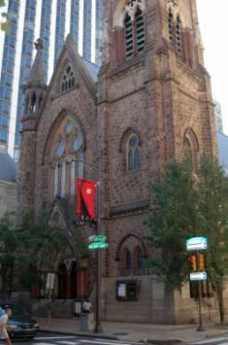
|
| First Presbyterian Church |
The Executive Director, Robert Jaeger, recently described to the Right Angle Club how the Partners operate. First of all, the Constitutional separation of church and state makes it difficult to seek funding or even advice from the Federal government. Pennsylvania has been less hesitant than most states in this regard, but even here the issue of fund-raising is a central issue. One only has to look at the Aztec and Mayan religious sites in Mexico to grasp that there are circumstances when the parishioners of a religion may have completely died out, but their monuments justify state assistance. Private, nondenominational philanthropy seems the easiest route for a society to take, in avoiding the obvious political and legal entanglements of seeming to assist one denomination more than others.
And then there are architectural issues;, can the building be saved at a reasonable cost, is it truly a unique or outstanding piece of art, can a reconstruction go ahead in an incremental way, are the necessary stone or other materials any longer obtainable, do the workman skills exist? In addition to these issues which are commonly presented to a congregation, there are issues they probably have never considered. As congregants move from center-city to the suburbs, they become commuters to church, largely out of touch with the local community and its activities. A survey conducted by the Partners suggests that 81% of the activity which takes place in church buildings on weekdays is conducted by and for non-members of the church; if the two groups lose touch with each other, opportunities are missed, and eventually there may be unnecessary friction. On the other hand, those non-religious activities probably escape the legal prohibitions against government assistance, and may suit themselves as vehicles for indirect government support. The approach has so much promise that Partners for Sacred Places has devised a computer program on their website which provides a way for congregations to assess their assets, and their problems. In fact, the organization conducts extensive training programs for church preservation, and has been forced by the size of the demand to exclude churches that are clearly failing beyond reasonable hope of recovery by their church membership.
The Partnership was originally founded by consolidation of the New York and Philadelphia organizations, to make a stronger national effort. But now things are going the other way. New chapters are springing up in Texas and California. Partners for Sacred Places is obviously proving to be a good idea, effectively managed.
WWW.Philadelphia-Reflections.com/blog/1269.htm
Manna

|
| MANNA |
On 23rd Street, right next to the home of the First City Troops, is another organization of quite a different character. This is MANNA, which stands for Metropolitan AIDS/HIV Neighborhood Nutrition Alliance. This group was founded in 1990 by members of the Presbyterian Church at 21st and Walnut but has become independent and non-sectarian. It has an annual budget of over $3 million, a hundred paid employees, and a thousand volunteers. They deliver meals to people who have been referred to them by physicians as suffering from AIDS, and agreed by the social workers on the staff, to be poor. Last year, they delivered 650,000 free meals and spent a lot of effort fund-raising to do so. About half of the funds come from the government, quite a bit from private foundations and individuals, and a lot from six annual fund-raising events. One of the six events is to sell pies at holidays, one is a Ballet Performance. There's a black-tie dinner, and so on. So the organization is a curious mixture of Show Biz and earnest volunteerism of the old Philadelphia spirit and style.
One might suppose from all this that Philadelphia is riddled with AIDS, and of course we do have a discouragingly large number of afflicted victims. However, there are a million people in the USA with HIV, and only 20,000 are found in Pennsylvania By contrast, New Jersey has 50,000 victims. And all of that is almost trivial compared with 40 million known victims worldwide with probably a lot more who are unrecognized as sick. The World Health Organization has found cities in Africa, Mombasa for instance, where 90% of the babies born in the hospital test positive. It is reasonable to suppose that Africa will be totally depopulated in a decade if matters continue unchanged.
So, in the meantime, until someone figures out something better to do, Philadelphia is responding to its problem in a traditional and typical way. The writer Susan Sontag has been saying that nothing short of a religious crusade for monogamy will save the undeveloped world, and maybe she's right. At least, people are thinking about the problem and trying to do something, however inadequate, to help.
Fairmount Park Historic Preservation Trust
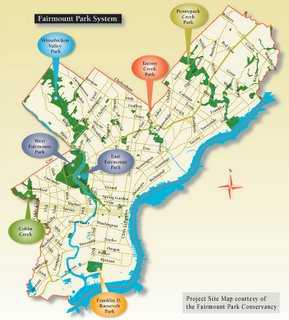
|
| Philadelphia's Fairmount Park |
New York's Central Park was created when it became clear there would be no park unless it was deliberately planned and its boundaries vigorously defended against real estate developers. Philadelphia's Fairmount Park, on the other hand, was to some degree a slum clearance project. The swift waters of the Wissahickon provide excellent power sources, provoking the construction of many mills. With steam power, they were abandoned, leaving desolate industrial hulks that blotted the landscape. Fairmount Park cleared out the remains of deserted mills, which had moved upriver to Manayunk, closer to a supply of coal. Fairmount Park was a creation of the Pennsylvania State Legislature, but the State never funded it. And it has thus always been somewhat larger than the City could afford.
In the early 1990s a beleaguered City government reached a public/private accord as a result of a commissioned study of the matter, which essentially urged that the city government should run the recreational programs in the parking area, and the private sector should be asked to do its best with land and historic building preservation. The William Penn Foundation, the Pew Charitable Trusts, and other philanthropic organizations banded together to form the Fairmount Park Historic Preservation Trust. Among its functions was to coordinate the many organizations which had been formed to preserve small areas of the park, as a result of the concerns of neighborhoods or descendants of former owners of historic homes. The Fairmount Park Trust finds itself in charge of over 400 houses, of which about 250 are genuine of historic value. They have to be preserved against vandalism and vagrants, mainly they have to be preserved against decay. Someone has to use them, and for that, someone has to spend money to fix them up and maintain them. If that is to happen, someone else has to set standards for preservation that balance the historic values with the need for some kind of present usage. Since few people would be willing to spend money and put up with uneconomical regulations if the building belongs to the park, the management of the Trust must manage and oversee very long-term leases. Obviously, the Trust must know what it is doing, have the wisdom to be innovative, and endure a fair amount of harangue by disappointed developers.
And it must supply some things which are hard to find, like advice and know-how about fixing up historic buildings of a certain age and history. The Trust has actually gone into the business of doing historic preservation for a fee, on its own property and elsewhere (Christ Church burial ground is an example). It thus generates some income to supplement philanthropic contributions. There is no requirement that prospective tenants must be non profit, only that the entity be of value to the neighborhood, and there are other signs that the Trust intends to be far-sighted and imaginative in the goal of making the Park something to be proud of, from the nearest to the farthest corner.
One idea suggested for further coordinated action might be to search for types of underbrush which would be repellent to deer who destroy the forest understory. Or, to search for particularly tasty "bait" shrubs which would draw the deer away from areas needing preservation. The combination of both ideas might lead to a natural balance, which would be unlikely to come about by the action of small local preservationists. Meanwhile, there are too many deer, and someone has to decide how and when to "cull the herd". That's how, in a small way, the trust got into the venison business.
So far, the Trust has preserved about 25 houses in the past ten years. That's a marvelous achievement, but it will take a century to complete the whole park unless momentum picks up. The Trust sort of needs an impresario of some kind or other to stir up public support.
Doing Well, Doing Good.
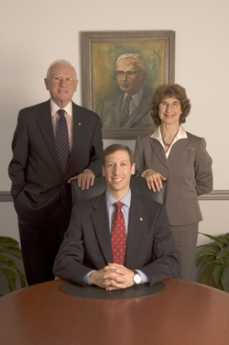
|
| Lynmar Brock |
Lynmar Brock is a Quaker, so what he does is surprising. He lives on a farm, but is Chairman of the Board of a food distribution corporation. He's also chairman of several other boards. He's written several books, and among them, a novel Must Thee Fight? relates the tribulation of one of his pacifist ancestors who nevertheless became a soldier at the Battle of Brandywine. The theme of this emotional conflict parallels the author's own struggle over being a conscientious objector who ultimately volunteered for the Navy because he felt he could not stand by while others fought his battles for him. The face of the soldier with a musket on the book jacket is his own.

|
| Rotary Seal |
When American forces recently entered Afghanistan, a great many people were forced to become refugees. Lynmar Brock was on the board of Rotary International, where a decision was made to provide relief for the refugees, and Mr. Brock flew over to lead the effort on the ground. Rotary raised $2 million almost immediately, and the task was to translate the money into something the refugees really needed. Since "shrinkage" is a common fate for refugee shipments, Rotary bought locally. They were able to distribute 83,000 pairs of shoes, 53,000 blankets and similar quantities of a number of other basic needs. Ultimately, the three-year effort raised $115 million and distributed items in the millions. It was important to give the goods to the local tribal chief, who then redistributed to the members of the tribe. To give it directly would undermine the authority of the chief, very likely provoking him to interfere with it. Accordingly, it is essential for relief workers to make friends with the chieftains, and it is essential to avoid the appearance of being a sap. All of the clothing was stamped with a big indelible yellow Rotary Seal; if it turned up in the black market, it would still be obvious what its source had been. At the same time, it was essential for donors not to appear to be soldiers. One of the missions of the group was to show the Afghans that Americans were real people who cared, and not all were soldiers. That they were successful in this way was brought out by one tribal chief coming forward and saying, "Teach us English. It's the language of the world."
Some influential Rotarians are active in American ophthalmological circles, and arranged to have American eye surgeons extract a great many cataracts from Afghans otherwise destined to a life of blindness. Since the Taliban routinely poisoned the wells, it was vital that farmers like Lynmar Brock were able to show how to repair or replace the local water supply. It might have been better to replace opium farming with tomatoes, but a compromise was made to replace opium with marijuana. That's an improvement, of sorts. The danger inherent in this work must not be shrugged off. All vehicles of foreigners were preceded and followed by at least six local soldiers. As the cavalcade moved from one tribal area to another, the soldiers were changed for soldiers of the new tribal area; their loyalty just had to be trusted. And, indeed, the co-chairman of the committee was mysteriously murdered one day.
The Rotarians return home full of praise for the U.N. field workers, mostly European, who are actually engaged in foreign relief work. The headquarters staff back home at the U.N. are described with only a shrug that speaks volumes, but it is useful for us all to keep the distinctions in mind.
Lynmar says it's great to be home. In his busy life there's work to be done on the farm, and in his corporation, and writing another novel. And there is supervision also needed for the Rotary efforts in the Ivory Coast. It's not completely certain, but sometimes he actually gets some sleep.
Astral
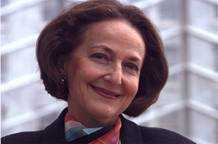
|
| Vera Wilson |
Brotherly love assumes all kinds of unexpected shapes in this city, and one of them is Astral. Vera Wilson recognized a critical gap in the Philadelphia classical music world, and in ten years has quite successfully filled it. Our town attracts the world's outstanding classical music talent to its schools, especially the Curtis Institute. It also supports the great established performers in its concert halls and recording studios. But how does a young virtuoso get from here to there, from a conservatory to the concert stage? Quite often, they don't make it at all, because no one helps them.
Pretty much single-handedly, and single-minded, ten years ago Mrs. Wilson established a non-profit organization to act as a bridge for young people with the talent and ambition to be classical musical soloists. What do such people need? Well, they need an incubator. They need membership in an organization that will provide them audiences, press notices, experience, a little emotional support, and some unobtrusive advice. And while Philadelphia is a world-renowned musical center, it could always use a few more concerts, a larger environment of musical enthusiasts, and a more enhanced reputation as the place to go if you plan to be a star.
Just about all these things are rapidly taking place. In ten years, Astral has put on nearly two hundred major concerts that would not have been put on, and every year puts on over two hundred local performances. Auditoriums that never thought of themselves as anything special are becoming the location of fine performances by performers who are clearly going somewhere. Musical affinity groups have formed around the idea of getting to know some virtuosos, helping some gangling kids, and even forming friendships with other local musical fans. Enthusiasm.
The formula involves a lot of hard work. Famous musicians have to be persuaded to contribute their time to auditioning prospective proteges. Concerts have to be planned, and auditoriums found to house them. Audiences have to be drummed up; pamphlets, advertising, and publicity have to be created. And paid for. Foundations have to be approached, grant applications have to be written, private donations solicited. Somewhere, $600,000 a year has to be raised to promote 26 rising stars. The whole thing would cost ten million a year if it were commercial.
Mrs. Wilson, who is not herself a musician, likes to describe herself as a groupie. It is a little hard to reconcile this elegant cultivated Argentine expatriated with the groupie concept. But maybe not. Perhaps we all have some enthusiastic groupie-ness talent in us.
Native Habitat
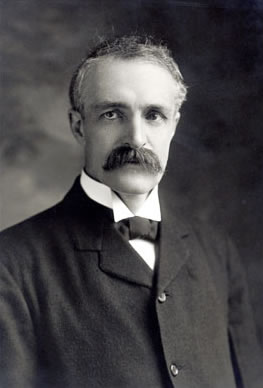
|
| Gifford Pinchot |
Teddy Roosevelt's friend Gifford Pinchot is credited with starting the nature preservation movement. He became a member of the Governor's cabinet in Pennsylvania, so Pennsylvania has long been a leader in the formation of volunteer organizations to help the cause. Sometimes the best approach is to protect the environment, letting natural forces encourage the growth of butterflies and bears in a situation favorable to them. Sometimes the approach preferred has been to pass laws protecting threatened species, like the eagle or the snail darter. Sometimes education is the tool; the more people hear of these things, the more they will be enticed to assist local efforts. The direction that Derek Stedman of Chadds Ford has taken is to help organize the Habitat Resource Network of Southeast Pennsylvania.

|
| butterfly |
The thought process here is indirect and gentle, but sophisticated; one might call it typically Quaker. Volunteers are urged to create a little natural habitat in their own backyards, planting and protecting plant life of the sort found in America before the European migration. If you wait, some insects which particularly favor the antique plants in your garden will make a re-appearance, and in time higher orders like birds that particularly favor those insects, will appear. The process of watching this evolution in your own backyard can be very gratifying. To stimulate such habitats, a process of conferring Natural Habitat certification has been created. In our region, there are over three thousand certified habitats.
Of course, you have to know what you are doing. Provoking people to learn more about natural processes is the whole idea. For example, milkweed. That lowly weed is the source of the only food Monarch butterflies will eat, so if you want butterflies, you want milkweed. For some reason, perhaps this one, the Monarch is repugnant to birds, so Monarchs tend to flourish once you get them started. After which, of course, they have their strange annual migration to a particular mountain in Mexico. Perhaps milkweed has something to do with that.

|
| Empress tree |
If you plant trees and shrubs along the bank of a stream, the shade will cool the water. That attracts certain insects, which attract certain fish. If you want to fish, plant trees. And then we veer off into defending against enemies. The banks of the Schuylkill from Grey's Ferry to the Airport are lined with oriental Empress trees, with quite pretty purple blossoms in the Spring. These trees seem to date from the early 19th Century trade in porcelain (dishes of "China" ) on sailing vessels. The dishes were packed in the discarded husks of the fruit of the Empress tree, and after unpacking, floated down the Schuylkill until some of them sprouted and took root. Empress trees are certainly an improvement over the auto junkyards hidden behind them. On the other hand, Kudzu is an oriental plant that somehow got transported here, and loved what it found in our swamplands. Everywhere you look, from Louisiana to Maine, the shoreline grasslands are a sea of towering Kudzu, green in the spring, yellow in the fall. It may have been an interesting visitor at one time, nowadays it's a noxious weed. So far at least, no animals have developed a taste for Kudzu, and no one has figured out a commercial use for it. When an invasive plant of this sort gets introduced, native habitat and its dependent animal life quickly disappear. So, in this situation, nature preservation takes the form of destroying the invader.
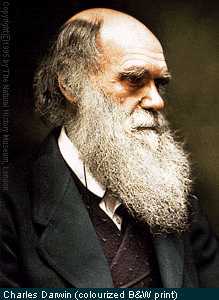
|
| Charles Darwin |
But where is Charles Darwin in all this? The survival of the fittest would suggest that successful aggressors are generally fitter, so evolution favors the victor. Perhaps swamps are somehow better for being dominated by Kudzu, pollination might be enhanced by killer bees. At first, it might seem so, but if the climate or the environment is destined to be in constantly cycling flux, diversity of species is the characteristic most highly desired. For decades, biologists have puzzled over the surprising speed of adaptation to environmental change. Mutations and minor changes in species seem to be occurring constantly, and most of them are unsuccessful changes. But when ocean currents change, or global warming occurs, or even man-made changes in the environment alter the rules, we hope somewhere a favorable modification of some species has already occurred standing ready to take advantage of the changing environment. Total eradication of species variants, even by other species which are temporarily better adapted, is undesirable. In this view, the preservation of previously successful but now struggling species is a highly worthy project. The meek, so to speak, will someday have their turn, will someday inherit the earth. For a while.
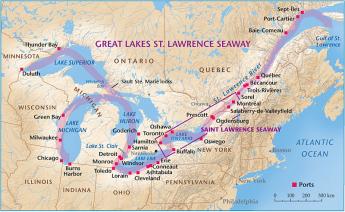
|
| St. Lawrence Seaway map |
And finally, there are variants of the human species to consider. To be completely satisfying, a commitment to preserving "native" species in the face of aggressive new invaders must apply to our own species. Surely, a devotion to preserving little plants and insects against the relentless flux of the environment does not support a doctrine of driving out Mexican and Chinese immigrants at the first sign of their appearance, like those aggressive Asian eels plaguing the St. Lawrence Seaway?. Here, the answer is yes, and no. For the most part, invasive species are aggressive mainly because they find themselves in an environment which contains no natural enemies. If that is the case, fitting the newcomers into a peaceful equilibrium is a matter of restraining their initial invasion long enough for balance to be restored through the inevitable appearance of natural enemies. So, if we apply our little nature lessons to social and economic issues related to foreign immigration, the goal becomes one of restraining an initial influx to a number which can be comfortably integrated with native tribes and clans. In the meantime, we enjoy the hybrid vigor which flourishes from exposure to new ideas and customs.
In the medium time period, that is. For the long haul, if the immigrant tribes really do have -- not merely a numerical superiority -- a genetic superiority for this environment, perhaps we natives will just have to resign ourselves to retreating into caves.
WWW.Philadelphia-Reflections.com/blog/1219.htm
Marian B. Sanders, Quaker Activist, 87

|
| Pre K Group |
Marian Binford Sanders, 87, of Mount Airy, a former principal of Lansdowne Friends School who devoted her life to Quaker service, died following gallbladder surgery April 23 at Chestnut Hill Hospital
Mrs. Sanders headed Lansdowne Friends from 1975 to 1981. During that time, her husband, Edwin, was a director of Pendle Hill, a Quaker study center in Wallingford, where the couple lived and where she taught courses. In the early 1980s, the couple lived at Cambridge Friends Meeting in Massachusetts, where they ministered and supervised the facilities.
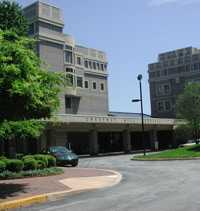
|
| Chestnut Hill |
After retiring to Chestnut Hill in 1985, according to her son, David, Mrs. Sanders lectured on the poet William Blake at Pendle Hill, taught adult literacy, and cared for her husband, who had Alzheimer's disease, until his death in 1995.
She was dedicated to the concept of world citizenship, her son said and opened her home to students and travelers from around the world. In 1997, she received an award from Earlham college in Indiana honoring her and her late husband for the "55 years of the shared struggle for human justice, for an end to war ... and for broad service in the Society of Friends."
Mrs. Sanders grew up in Dayton, Ohio, and Butler, Pa. She earned a bachelor's degree from Earlham College and, in 1939, the year she married, a master's degree in English literature from Pennsylvania State University.
In 1940, her husband, a Quaker pacifist, was sentenced to federal prison for a year for refusing to register for the draft. After he was paroled, the couple taught at Pacific Ackworth Friends School in Temple City, Calif., which they helped found. For more than a year in the 1960s, they trained teachers in Kenya. Later, Mrs. Sanders taught English literature in Russia as an exchange teacher with the American Friends Service Committee.
In addition to her son, David, she is survived by sons Michael, Richard, John, Robert, and Erin; a daughter, Beth Sanders-Blevins; eight grandchildren; and four great-grandchildren.
A memorial service will be at 3 P.M. June 26 at Pendle Hill 338 Plush Mill Rd., Wallingford.
Memorial donations may be made to Lansdowne Friends School, 110 N. Lansdowne Ave. Lansdowne, Pa. 19050.
-Philadelphia Inquirer, May 15, 2004
Friends Lifecare at Home
Over thirty Quaker retirement villages scatter through America, more than twenty in the suburbs of Philadelphia -- "under the care of the Yearly Meeting", as their expression has it. But for some people, community living seems unattractive. It does not speak to their condition.
For one thing, it may not be affordable.

|
| Friends Lifecare |
Or the style of may seem too fancy, or too plain, for some tastes regardless of cost. The increasing emotional rigidity of growing older is a factor; by the time people get to be seventy-five, they had better make this decision or forget it. Plenty of people are hale and hearty at ninety, but they establish pretty firm ideas about the sort of person they want for neighbors while they are still in the workforce. Quite often it's just a habit, people have lived in their home for several generations and cannot imagine another neighborhood, lifestyle, or environment. This is home, and they intend to die there.
So, to address this need, or market, a group of Quakers conceived of a retirement village without walls. Live in your own home and someone will come to oversee things, will know what to do if there is an emergency, and may eventually make the decision for you that you absolutely must go somewhere else. All of this is wrapped within an insurance vehicle, to recognize the fixed incomes of retired people, the inevitability of terminal illnesses, and the occasional risk of monumental medical expenses. At present, about 1600 people in Philadelphia are enrolled in the unique plan of Friends Lifecare at Home, making it one of the largest retirement communities in the country. The organization receives universal praise for its imaginative responses, as well as the dependability and high quality of the people it sends out to the homes of subscribers. Friends Lifecare is a pioneer, and it is gradually weeding out the ideas that didn't work and adding new features that were not originally contemplated. One of its greatest challenges is the need to adapt to unexpected and uncontrollable changes in the Medicare program. Slashes in the Medicare program could bankrupt Friends Lifecare, and even sudden windfalls like the Medicare Drug Benefit create management problems. There can be no doubt that one element of trust exists for which there is no substitute; Philadelphians know that the invisible support of the community and its Quaker core is behind them. If anyone can possibly preserve a moral commitment to the elderly, it will be the Quakers.
Ultimately, the commitment is not so much to 1600 subscribers as to the notion of finding out what works. Life expectancy has extended by three additional years, during the past ten; that's a joy, but it's a problem to finance. The optimum size of the organization is also an unsettled question. Although this program is relatively large by comparison with individual retirement villages, it may not be large enough to have spare capacity to cope with influenza epidemics or record-breaking spells of bad weather. Since it's the only one of its kind, it is vexed by the popularity in ever-widening geographic areas. It must grow to some reasonable size in one area before it can spread its resources to another. By the same reasoning, it must have a reasonable number of prosperous subscribers if it is to accept even a limited number of poor ones.
The idea of creating a seamless partnership with the residential-type retirement villages is certainly attractive, but Friends Lifecare must be careful to avoid becoming too much of a life raft for other people's problems. When the resale price of residential housing rises in a housing bubble, people wish to cling to a rising investment. During the same economic period, the entry and rental price of residential villages also rise. With a great many uncertainties that are specific to this pioneering effort, it is hard to know what policies to develop to insulate the lifecare environment from speculation in the mortgage and housing markets. Or, right now, high-rise apartment development. All of this creates a need for clear minds in the governance, determined to see and acknowledge difficult reality. If anyone can do it, Quakers can.
The Kimmel Center: Comments On The Economics of Music

|
| Kimmel Center |
In 2001, The Kimmel Center for the Performing Arts opened to the public, at a cost somewhat to the North of $200 million, and an annual budget in excess of $80 million. Although the generosity of Sidney Kimmel and Raymond Perelman must be gratefully acknowledged, and the ambitious energy of Philadelphia's political and musical worlds must be admired, there is little question that the city strained its resources to the utmost to achieve the new center. The Philadelphia Orchestra must appear on anyone's list of the best symphony orchestras in the world. It's likely going to stay there, too, because the orchestra stands on a wide base of associated Musical schools, chamber music groups, and intensely loyal musical audiences. As they say in baseball, they have a deep bench.
Nevertheless, software piracy has just about eliminated an important source of income from the sale of recordings, seat prices are dauntingly high, other symphonies and other forms of entertainment have greatly improved in recent years. First-class musicians are not paid like sports stars, perhaps, but the top layer begin their careers with salaries in six figures, and top conductors commonly receive a million dollars a year, just like corporate executives. Between the high costs and the practical upper limit to what audiences will pay for a seat, about a third of the budget must be subsidized by some form of donation or fund-raising. It takes a lot of effort to raise thirty million a year.
For reasons not entirely clear, the Kimmel center
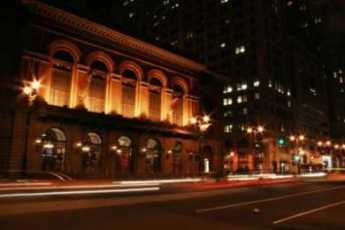
|
| Academy of Music |
is a free-standing corporate entity, whose main tenant (the Orchestra) owns a competitive music hall, the old Academy of Music. In other words, the capacity of Philadelphia's musical locations has been substantially increased. Increased, that is, beyond the metropolitan area's capacity to fill seats for classical music. A season's list of seventy-five productions may not fill the capacity, but the production schedule is limited by the fact that almost every production sustains a loss which must be made up by fund-raising.
Following Julius Caesar's
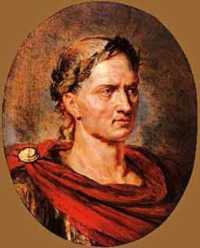
|
| Julius Caesar's |
motto that Fortune Favors the Brave, the leadership of the town has embarked on a daring musical exploit. The remarkable design team constructed the hall along highly innovative lines, based on movable wooden wall panels, controlled by computers. The hall itself becomes an instrument, slowly adapting and learning from each orchestral piece to produce an evolving product that no orchestra could produce without the hall to surround it. No one yet knows how far this idea can be taken, but it is possible to imagine four or five quite different versions of the same piece, each one recognizably distinct and with its own following.
And revolving stages, adaptable hall design, and computerized modeling make it possible to have performing arts, not merely classical symphonies. It remains to be seen whether the designers can achieve perfection in a number of different forms, not merely limiting the design to a specialized version for a single purpose. If that works, capacity can be increased by redefining capacity. Just imagine what a wedding you could hold there.
And just imagine how that worries the owners of the other six theaters in the neighborhood. In fact, just imagine how it worries the Philadelphia Orchestra to learn that there are plans to bring other visiting orchestras to town. Or how it worries other cities to hear that Philadelphia hopes to draw musical audiences from a long distance. There's going to be some creative destruction here, and some high adventure.
Phillycarshare
 |
| Jerry Furgione |
Jerry Furgione recently intrigued the Right Angle Club with what those small red cars are all about. A non-profit organization named PhillyCarShare has been able to grow a fleet of 400 autos to rent by the hour -- gas, insurance and washing included. Each car has a home base in some parking lot or garage or other accessible place, from which you take it, and back to which it goes when you are done with it. Reservations are handled by phone or internet, payment by credit card; a platoon of attendants come around at night to refill the gas and check on things.

|
| Philly Car Share Lot |
Now that's not quite as convenient as having the car delivered, or picking it up at one place and dropping it off at another, but it's workable. One of the technical secrets is a wireless system working a lock which can be controlled remotely. For a $25 onetime membership fee the customer gets identified with a particular lock, and the car keys are inside the car. That's a little kludgey (as trendy people say) because if you forget to lock the car when it's parked it can be stolen. No doubt technology could soon be developed to handle the whole business electronically, emitting signals that the car is parked but unlocked, issuing automated scolding and just-this-once remote locking and unlocking, and perhaps a dozen other engineering features. But that requires more volume than 400 cars, and it's early days. Present reliance is made on repeated reminders to lock the car when you aren't using it, backed up with a $100 fine if you forget. It's probably the biggest source of friction.
The rise in oil prices helped the car share business a lot, and enthusiasm among young early-adopters carries things quite a way, so the business is growing. It probably won't be possible to judge the future until competition appears and business levels off, at some stable point. If some of the rough spots can be fixed with gadgetry, this hourly rental system should have a permanent place in our environment. Since it's a non-profit, it will be of interest to see what variants the for-profit sector can provide.
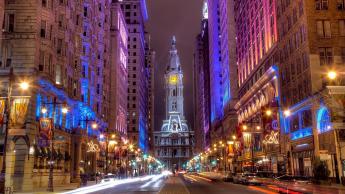
|
| City of Philadelphia |
At the moment, the business has the nuisance of an average 6-months delay to get each new parking spot approved by the various ownership and licensing agencies. But the developers of high-rise apartments are learning that having rental cars headquartered at the building entitles the builder to provide fewer off-street parking spaces, so revenue potential starts to appear. Companies, and in particular the City of Philadelphia have taken to using this system to reduce the size of their car fleets; universities are nibbling at the idea of shared memberships. Hard to know where this will lead.
You learn some things the hard way. The cars once had a plastic card to use for filling up at a gas station, but too many cars were broken into to steal the cards, so this had to be curtailed. If you have an accident the company's insurance takes care of you, but then there are quarrels about renewals of insurance, both theirs and yours. People who are used to jumping into their own cars, and out of them whenever and where ever they please, tend to feel a little constrained by the need to make reservations and be prompt about them (because someone else might be waiting for the car).
Which brings you to the ultimate trade-off in this system. People want to have lots of cars sitting around, so they can use spur-of-the-moment planning. The business, on the other hand, wants every car to be in constant motion, every slot in the schedule filled up. Right now the cars average eight users a day and have comparatively little waiting for reservations, only because the typical user at present does not want the car during 9-5, five days a week hours. As business increases, it should emerge just what the break-even points are between too many cars and too few. From the customers' point of view, that means, "How much are you willing to pay to have a car immediately and invariably available?" At the equilibrium point between maximum customer convenience and minimum price, we'll soon see what the public really wants and will pay for.
Meanwhile, the experimentation goes on to explore the tastes and preference of the Philadelphia public, region by region. They have a few pickup trucks if you like, and even a few Lexus's. Although the original idea was developed in Europe, Philadelphia has here the largest hourly rental business in the world, and it's galloping along briskly.
Quaker Gray Turns Quaker Green
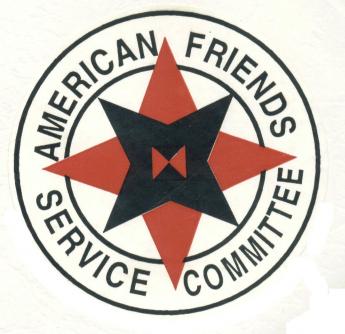
|
| American Friends Service Committee Logo |
Miriam Fisher Schaefer, at one time the Chief Financial Officer of the American Friends Service Committee, had to cope with the economics of renovating the business headquarters complex for various central Quaker organizations. They're housed in a red-brick building complex, naturally, located on North 15th Street right next to the Municipal Services Building of the Philadelphia City Hall complex. The original building within the complex is the Race Street Meetinghouse, funds for which were originally raised by Lucretia Mott. The Quakers needed to expand and renovate their offices, a nine million dollar project. Miriam, a CPA, calculated that the job could be made completely environment-friendly for an extra $3 million. The extra 25% construction cost explains why very few buildings are as energy-efficient as they easily could be. However, in the long run, a "green" building eventually proves to be considerably cheaper. Not only would a green Quaker headquarters be a highly visible "witness" to environmental improvement, but it would also pay for itself in reduced expenses after about eight years. That is, if friends of the environment would provide $3 million in after-tax contributions, they would provide a highly visible example to the world, and reduce the running expenses of the Quaker center by a quarter of a million a year, indefinitely. Effectively, this is a charitable donation with a permanent tax-free investment return of 12%, quite nicely within the Quaker tradition of doing well while doing good.
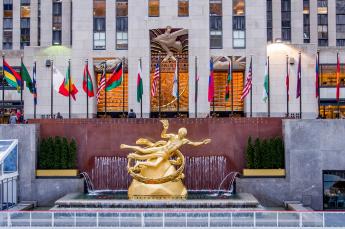
|
| Rockefeller Center |
Energy efficiency isn't one big thing, it is a lot of little things. If you dig a well deep enough, its water will have a temperature of 55 degrees, and only require heating up another 15 degrees to be comfortable in winter, or cooling down thirty degrees to be comfortable in the summer; that's described as a heat pump. Then, if you plant sedum, a hardy desert succulent plant, on the roof it will insulate the building, slow down rainwater runoff, and probably never have to be replaced. Rockefeller Center, you might be interested to learn, has a "green roof" of this sort, which has so far lasted seventy years without replacement. The Race Street Meetinghouse was built in 1854 and has so far had many roof replacements, each of which created a minor financial crisis when the need suddenly arose.
The ecology preservation movement is full of other great ideas for city buildings because buildings --through their heating, ventilating and air conditioning -- contribute more carbon pollution to the atmosphere than cars do. For another example, fifty percent of the contents of landfills originate in dumpsters taking construction trash away from building sites. What mainly stands in the way of more recycling of such trash is the extra expense of sorting out the ingredients. Catching rainwater runoff allows its reuse in toilets, eliminating the need to chlorinate it, meter it, and transport it from the rivers. And so forth; you can expect to hear about this sort of thing with great regularity now that the Quakers have got stirred up. You could save a lot of air conditioning cost by painting your roof white. At first, that would look funny. But do you suppose oddness would bother the Society of Friends for one instant? No, and you can expect them to make it popular, in time. People at first generally hate to look funny, but with the passage of time they grow to like looking intelligent.
A lot of people want to save the planet. So do the Quakers, but they have come to the view that the public is more easily persuaded to save money.
Community Volunteers in Medicine
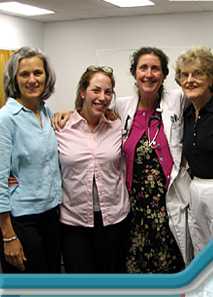
|
| Comm Volu In Medicine |
Mary Wirshup has a very different medical background from mine, but she's my kind of doctor. I couldn't help wishing, as she addressed our urban luncheon club, there could be thousands more like her, even while understanding more fully than she seems to, the reasons why doctors are driven from her behavior model. As we parted, it felt like saying a last goodbye to the Spartans marching to Thermopylae.
As 46,000 medically uninsured persons in Chester County get sickness and injuries, they know that a Federal Law prohibits a hospital accident room from refusing to see them, so ways are found to shunt patients to the CVIM free clinic, run by volunteers. This law is, in turn, a response to a government-created situation where a hospital which "accepts" patients must keep them. Any economics teacher can tell you that supply/demand issues are best addressed by price adjustment, so price controls in whatever guise lead to shortages. I must say I have little sympathy with the devious strategies which hospitals often employ to disguise their rejection of uninsured patients. At the same time, I know a lifeboat will sink if too many climbs aboard. Nevertheless, the semantic switch from lack of insurance to lack of care implies that only more insurance can surmount the barriers to care, which is absurd. For one thing, I know too many hospital administrators who are paid a million dollars a year, and one who is paid two million. And at least two health insurance executives are in the newspapers with a net worth over a billion -- yes, that's billion with a b. We have reached a point where reducing all physician income to zero would only reduce "healthcare" costs by 10%. As I look at Dr. Wirshup's modest clothing I can only surmise she plans to continue her modest living until she is 80 years old, after which her savings might see her out. Squeezing physician reimbursement is not intended to save significant money, nor intended to restore physician incomes to more equitable levels. It is intended to address the oversupply of physicians without confronting either the universities or the foreign trained lobby.
The elite tranche of medical schools do their part to relieve physician oversupply without reducing class size, through the encouragement of their students to go into research. I was well along at the National Institutes of Health before I finally decided I had not gone into medical school with that goal, and returned to teaching and patient care in a more satisfying model not too different from CVIM's obviously Pennsylvania Dutch spirit. The Amish at the far western end of Chester County reject the whole idea of insurance; their most characteristic statement is "Don't send me no bills." That attitude is rather a contrast with the shiny housing and automobiles in the Silicon Valley developments of Southern Chester County, or even with some rather bewildered Quaker farm families scattered over the rest of the county next to the horsey set. Chester County is America.
On Second Street in Society Hill, next to the park where William Penn's house stood and a few feet from Bookbinders, is the house of Dr. Thomas Bond. Bond conceived the idea of building the first hospital in America and with Franklin's publicity machine succeeded in getting it built, to care for the "sick poor". Dr. Bond started a second enduring tradition as well. When the Legislature expressed doubt that the institution was sustainable, he pledged to convince the local medical profession to serve the poor without charge. Some of the legislators who voted for the measure did so in the belief that charity care would never appear so the gesture would be without cost. The physicians did indeed come forward, in sufficient numbers to run many institutions for two hundred years. In 1965 health insurance made its national appearance and has regarded the benchmark low costs of charity care as a threat, ever since.
Neopolitan Right Angle
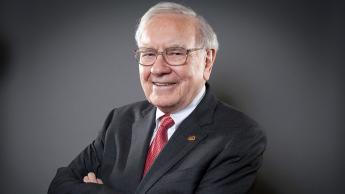
|
| Warren Buffett |
The Right Angle Club of Philadelphia recently heard from a former member, Merrill Roth, who has moved to Naples, Florida. Such retirement places are populated by people from all over the country, all anxious to show the merits of where ever they came from. So, Merrill decided to transplant one of Philadelphia's jewels to the West Coast of Florida; he started a Right Angle Club of Naples, meeting monthly in the Vanderbilt Club. By great good luck, he discovered that one day a week was Ladies Day at the golf course, an ideal circumstance for founding a men's club. Before he knew it, he had a hundred members, filling up the dining room to capacity.
So, being Merrill, he started a second one, which has now grown to thirty members. One of the central themes of these clubs is that Naples has a great many cultural events and institutions, but newcomers have trouble locating them. So his clubs fill a local need.
Since he started the clubs, he had to arrange for the speakers, and shouldering this burden for the rest of his life now seems a little daunting. So, it was useful to remind him that the Philadelphia Right Anglers of the Mother Church assign that task for only a year since most everybody can find forty friends who can speak, but nobody wants to do that forever. Other clubs encounter the same issue, and one solution has been to hire an executive director of the club and have him get the speakers. Since nobody knows an infinite number of entertaining speakers, that soon gets to be too much; and so the executive director hires a program director. Pretty soon that gets expensive, and the club starts going to agencies. The whole thing eventually loses its character as a voluntary fraternal group, gets unaffordable, and the programs wander away from the interests of the members. The only thing worse is to own your own clubhouse. The seeds of the club's destruction are sown by failing to appreciate these realities of club dynamics. Warren Buffett tells investment advisors to eat their own cooking. The club variation of that sage advice, is, get your own speakers.
Use the Internet for Your Club
Most clubs, family groups, or neighborhood associations are held together by one loyal volunteer who does all the work. This limits the scope of the club to what one person is able to do in spare time. When that central person gets tired of it or moves away, things tend to fall apart. In the spirit of encouraging more volunteerism, this article suggests some ways the home computer can easily automate the normal drudgery of running a club. Having just performed this task for the local computer society, I can report it takes about two hours to put it together. If I did it three times, it would take forty-five minutes. A rank beginner, who doesn't even know what the words mean, might take all day to do it, but no more than that.
Most of the programs a club would need were first developed for people on the go, like a salesman who visits several cities, or a college student who commutes. It's an easy step to imagine different club members in different places instead of one person in several places. Electricity travels so fast that connecting computers together over the whole world's Internet can be thought of as essentially creating one big computer. For practical purposes, it doesn't matter whether a piece of information is in two parts of one computer or in two different computers hooked together by the Internet. The whole process is so cheap it might just as well be free.

|
| The New Macintosh Mac Mini |
Selection of Computer and Operating System. Over ninety percent of the world's home computers are based on the Windows operating system, but Windows is having a lot of trouble right now with viruses and spam. Right now is Apple's big chance, because the Apple OS X operating system, based on Unix, seems to be immune to viruses and spam. So, if you are buying a new computer, I suggest you look at Apple's headless version. That's a little six-inch box to which you attach the monitor, keyboard, and printer that presumably you have left over from some Windows system. Times will change, but right now this five hundred dollar little headless job is worth the money. That's for the club secretary; all the club members can use any kind of machine they happen to have, at least for read-only use.
Router. If you have several computers on one telephone line, you need a router to send the right signals to each machine. Because the router changes the identification numbers every time it is restarted, it tends to foil the buccaneers out there who are trying to find your credit card. Therefore, it's not a bad idea to have a router attached, even if you only have it connected to a single computer. Security folks say it takes about fifteen minutes for some buccaneer to find a newly installed computer, and most banks get several hundred break-in attempts every hour. That's because everybody is getting automated these days, including criminals.
Choice of Browser. After you get set up and organized and all, you need to download the Fire fox browser, which right now is faster and more spam-proof than either Internet Explorer or Netscape. Go to some other browser and enter https://www.mozilla.org/products/firefox/. There's no harm in having several browsers sitting on your computer, including Opera if you like, but right now Firefox is the one to use. A browser, in case you care, is a program that takes a stream of Internet data and translates it into the image on your screen, sort of like translating Morse code into a telegram. Some browsers are lean, mean and fast, while others are loaded with a lot of bells and whistles that slow them down. If you can't see any difference by trying them, go with the one that gives you most spam protection.

|
| Yahoo Calendar |
Yahoo Calendar. There are lots of computer calendars, but right now Yahoo offers one that is somewhat better for public use by clubs. For an illustration, take a look at the Philadelphia Orchestra calendar that can be located on Philadelphia Reflections in the lower left column, by first clicking the Philadelphia Calendars button, and then clicking the link to the Orchestra's schedule. Naturally, the Orchestra doesn't want people changing their public schedule, so the calendar is read-only. You can create a calendar like this for your club or organization by going to www.calendar.yahoo.com and entering an identifier and password. You can only change the calendar if you have the password, so be careful who is allowed to have it. If you make a misjudgment about this, just abandon the calendar and start a new one. You can, of course, create a personal calendar for yourself; it would be nice to merge your calendar with organization calendars. Calendar-merge programs do exist but presently are a little primitive. Even nicer would be the ability to drag and drop individual events from one calendar to the other, but that's mostly on the wish list.
Yahoo Address Book. There are zillions of address books, but Yahoo provides a public one if you allow club members to know the password. On the one hand, it's a big convenience for the secretary to have everybody fill in his own data. It can take ten or fifteen minutes apiece to complete all that information. On the other hand, if just anybody can have all this data, you can expect to get lots of unwanted solicitations. Naturally, you want to keep intruders from altering the data, but whether or not you make your membership list public is your own decision. So, probably you want to transfer the data to a list that you keep private, using a system of letting people enter data, and then erasing it after it is transferred.
Listserv. A very handy tool is to create a listserv, which is a system of e-mail that is sent to everyone on the list, and everyone can chime in with comments. It makes for a lot of local excitement, and it keeps families together, including reunion classes from all the schools you went to, 'way back then. If the Rs and the Ds get to bashing each other on the Listserv, you will learn the value of designating some sober soul to be list master, given the power to exile people whose mouths get too noisy.
Minutes and History as Blogs. Most clubs keep minutes, and after a while, they start to record their history. It's a lot of work, and often gets lost; furthermore, it's hard for anyone but the author to read. We suggest you create a blog and hang it on the Internet.
While there are a dozen programs and systems for creating blogs (that's short for Web logs), Google has bought blogger.com from that company, and has pepped it up quite a lot. Like the rest of these ideas, this one is free, and there are several million of these in existence. Sometimes people write poetry in the form of blogs, and some other people put up some pretty raunchy pictures or commentary. Apparently, Google doesn't care, so they shouldn't mind if you publish the minutes of the East Whipswitch Cooking Society as blogs. It's very easy to do, and their canned templates produce some pretty elegant web sites in minutes. That's right, minutes in minutes.
Finances and Newsletters. Clubs typically collect dues or charge for luncheons, but financial stuff on the Internet is more complicated and must be dealt with in a later article. Similarly, you can publish a newsletter using RSS that is very spiffy indeed, but that's really hard to explain, and must be described in a separate article, too. Anyway, these preliminary items are enough to keep a new club busy for a few months.
Fast User Switching. Other operating systems will surely imitate it, but Apple is at present where you have to go to make a separate computer section for your club. Apple originally had the idea that several people would use the same machine, and want to keep their data secret from each other. So, they have a system in which you can click the upper right corner of the screen, and you can place yourself in a secret room with its own password. We suggest that it would be better to see this as a new desktop. All graphical interfaces of all computer operating systems use the metaphor of a desktop, which is what suggested to me that the club needs a desktop like my own. That is, it's littered with half-finished business of a dozen sorts, suddenly abandoned when the phone rings or a visitor arrives. You would like to be able to come back to your desktop and take up your work where you left off. For that, you probably need several desktops, and that's what fast user shifting provides you. Not vitally essential, but very convenient.
Favicons. Especially if you have fast user desktops specially designated by work topics instead of people, you can really use the favicon, or favorite icon, feature. A favicon is the little miniature do-hickey to the left of the webpage URL in the URL box. Maybe you never noticed it, but it's usually there. If you take your mouse and drag the favicon onto the desktop (you may have to shift something to create some blue sky desktop room) a new icon will appear on the desktop. Close up and click on that new icon, and you will open up a browser and go right to the page you were using when you created the icon. This is such a really neat feature that your desktop is apt to fill up quickly with a lot of web pages you happened to come across. It doesn't take long for the favicons to choke the desktop into uselessness, so this feature is at its best in a system where the topics of general utility to the user are sub-set by fast user switching.

|
|
Apache has the largest share of the market and is available for most computers. |
Your Own Website. Apache. Your club will soon get the idea that you need your own website, but in fact, you already have several of them. Your calendar, address book, club minutes blog, club history blog already add up to four websites. To most people, having their own website means consolidating all this material into one elegant page, with photos and artwork. You can do that, but it's much harder, and you first need to see if you really have a need for that. By far the easiest way for amateurs to have a website is to pay somebody a couple hundred dollars to write the code for it, and pay an Internet provider ten or twenty dollars a month to display it for you.
But for advanced players, like a club of computer professionals and particularly if that club runs a little on the snooty side and highly prizes its privacy, it might want to consider going all the way and becoming its own Internet provider. In that rather special case, it brings us back to Apple, since the OS X system includes a free copy of Apache, the program for running your own site on your own computer. Now, that's really a big undertaking, far beyond the average club. So if privacy of that order is mandatory, you may have to hire someone to set it up for you. But Apache sure makes it possible, if that's where you feel you want to go.
Your Own Newslettter. First, take a look at what you are trying to achieve, and a handy example would be https://www.yahoo.com/.

|
| Yahoo |
You will see it is not a daily or a weekly, it is continuous. The page of the newspaper is a montage of ten or twelve blocks on a page. For example, one block might display the month's schedule, another shows sports scores, another shows the stock market, etc. Each one of those blocks is probably updated at a different time, making this a continuous newsletter. Of course there is a way provided to individualize the blocks of space, change the color schemes, etc. Since this newsletter is on the Internet, anyone can read it from anywhere in the world, at any time. That is, they can read it if they know the password, which some clubs want to keep private, and others prefer to skip because it is a nuisance when people forget what the password is and call you up at home after midnight to ask for it.
What underlies this process is a technique known as RSS. Each block of space in the newspaper is operating on a different scheduling, and each blocks "polls" a donor site every so often, for example fifteen minutes. The polling program calls the URL of each donor site at a preset time, where a record is kept of the last time the site was modified. If the site has been changed since that last visit of the polling program, the new site is downloaded to the newsletter page. If there has been no change, the polling program simply goes on to the next-scheduled site. In effect, the polling program is acting as a "robot". Modifications of this system, with considerable elaboration, are at the heart of the Google robot and other robots for other purposes. Generally speaking, the ordinary user doesn't have to know how to construct one of these robots, or modify one. No doubt, there will be extensive elaboration of this concept in the near future, but that's essentially how you can construct a usable newsletter in short order.
www.Philadelphia-Reflections.com/blog/464.htm
Use the Internet for Your Club (2)
First, take a look at what you are trying to achieve, and a handy example would be
https://www.yahoo.com/. You will see it is not daily or weekly, it is continuous. The page of the newspaper is a montage of ten or twelve blocks on a page. For example, one block might give you the month's schedule, another shows the sports scores, another shows the stock market, etc. Each one of those blocks is probably updated at a different time, making this a continuous newsletter, and of course, there is a way provided to individualize the blocks of space, change the color schemes, etc. Since this newsletter is on the Internet, anyone can read it from anywhere in the world, at any time. That is, they can read it if they know the password, which some clubs want to keep private, and others prefer to skip because it is a nuisance when people forget what the password is.
What underlies this process is a technique known as RSS. Each block of space in the newspaper is operating on different scheduling, and each blocks "polls" a donor site every so often, for example, fifteen minutes. The polling program calls the URL of each donor site at a preset time, where a record is kept of the last time the site was modified. If the site has been changed since that last visit of the polling program, the new site is downloaded to the newsletter page. If there has been no change, the polling program simply goes on to the next-scheduled site. In effect, the polling program is acting as a "robot". Modifications of this system, with considerable elaboration, are at the heart of the Google robot and other robots for other purposes. Generally speaking, the ordinary user doesn't have to know how to construct one of these robots or modify one. No doubt, there will be an extensive elaboration of this concept in the near future, but that's essentially how you can construct a usable newsletter in short order.
Volunteerism Needs a Business Plan
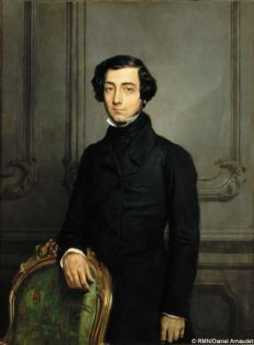
|
| Alexis de Tocqueville |
The visiting Frenchman Alexis de Tocqueville was struck most by the volunteerism he found everywhere in the young American nation; in his view, the first reaction of 19th Century Americans to a problem was to create a volunteer organization to fix it. Benjamin Franklin, who created dozens of such initiatives, was held up as its great exemplar. But de Tocqueville visited us at the beginning of the Industrial Revolution, and we are now well past that into the Information Revolution; volunteerism has noticeably declined. Not only have the great volunteer organizations like the Masons and the Red Cross suffered, but it is far more difficult to enlist the help of others to form a pick-up group to attack some issue or other. It is in that sense the general spirit of volunteerism has declined. The likely difficulty is not selfishness, but the helplessness of people to control their own time.
When volunteer groups to assemble, they are mostly composed of self-employed people like plumbers and dentists, free to be somewhere else during "normal business hours", which although shorter than they once were, seem extended by commuting time and by chores pushed aside during workplace confinement. To some extent longer commuting distances make it physically impossible to do personal chores in the vicinity of the workplace. But constrained personal time is also related to increased control behavior by management. A successful big business has to employ strategies to get employees with cell phones to stick strictly to business while the employer is paying for their time. Now that so many women are going out to work, the family unit needs to struggle to coordinate everyone's work time so there will be some remaining opportunity to conduct family life. When a working couple shares the home tasks and babysitting, the preempted time now extends to two working partners, and what is left is called "quality time". A probably temporary elaboration of this time competition is the need to chauffeur teenagers to their resume-enhancing activities. For the time being, you don't pick a college, the college picks you, and parents desperately labor to assist their children on a career path. Quite obviously, America needs to evolve better ways of trading work at home for more flexibility in the actual workplace, and we also need to build more first-rate colleges, but those issues are not the present topic. To summarize: It's awfully hard to assemble a group of volunteers simultaneously because employers have so successfully assembled their time. Failing to appreciate the tradeoffs inherent in commuting time is a secondary but still important factor, somehow related to the recent housing/schools mania.
Consequently, volunteer organizations increasingly tend to regard their chores as something you hire someone else to do if it proves impossible to dump them on someone who is retired or unemployed, or too timid to refuse. Even nominal volunteers are reluctant to step forward. This leads to recruitment lectures along the line that naturally you must sacrifice if you really truly believe in the goals of the dear old Whatsis Association, surely just a coercive speech pattern. That claptrap was never heard during the age of universal volunteers; volunteering was just one of those things everyone expected to do to get community activities accomplished. We're losing something important if we continue to endorse this attitude. Sometime during the first twenty-four hours in military service, for example, someone will surely advise the new recruit -- never volunteer.
For a penniless non-profit to adopt the solution of hiring staff when there is no revenue stream to pay them, is the first step toward the dissolution of the organization. Essentially, the non-volunteers are ordered to contribute money if they choose to be draft-evaders, and eventually, the officers and staff begin to look back at the organization members as cows to be milked. A class of people who are only making a living is substituted for those who understand and promote the goals, and it just goes downhill from there.
Instead, all volunteers really must each do some unpaid work, and the officers and directors must set an example of it. What an organization does next is crucial. Individual members, either anonymous or hoping to remain anonymous, must be approached with the suggestion they accept responsibility for a task. The wild-eyed response to this approach is quite familiar, like the lame excuse that there is no time. A counter response that I'm busier than you are, does not improve the conversation because it suggests the refuser is merely a selfish shirker. Instead, initial requests must take the following form: They should be for a simple, limited task without any obligations stretching to infinity. Almost everyone will be glad to bake a cake for a party, but almost no one will agree to be chairman of the cake-baking department unless the boundaries of that commitment are more reliably limited than they usually are.
In modern times, any major undefined volunteer responsibility is seen as potentially leading to an unthinkable conflict with gainful employment or else its ill-considered outgrowths like commuting. Since that's the basic problem, all-volunteer invitations must respect the true issue and devise workable ways to circumvent it. Role models certainly help if you have any.
www.Philadelphia-Reflections.com/blog/1448.htm
Making Volunteerism a Business
This is a business proposal, first laid before the Union League of Philadelphia because it seems the logical place to begin. Essentially, it proposes to create a service business for the collective administrative chores of many non-profit clubs and institutions. The business plan envisions one general partner and many limited partners.
The Problem to Be Solved
As the French tourist Alexis de Tocqueville famously observed, the American style for getting things done is to form a volunteer organization. Ben Franklin probably set a world record for starting such things, but after two hundred years, the business model is fraying at the edges. We have become so accustomed to administrative luxuries that the faithful leadership is often unable to stretch to the challenge, while small organizations simply cannot afford the cost of doing things with paid professional employees. It seems a fair guess that a staffed administrative office, with computers and all, cannot be provided for less than a hundred thousand dollars. That creates a threshold of a hundred members paying a thousand dollars annual dues -- an insurmountable obstacle for most of the many volunteer societies we used to have. Is it possible to create a central agency which computerizes the common tasks for many organizations at an affordable cost?
How to Begin the Experiment
Without bothering to ask, it seems a certainty that the largest wealthiest club in Philadelphia is already busily at work on the task of computerizing its billing, accounting, payroll, etc. and is probably nibbling at the tasks of scheduling, name tagging, refunding pre-paid non-attendance, newsletters, websites, archiving, purchasing, etc., etc., etc. It seems a relatively achievable task to request that such functions be generalized to accommodate more than one organization; essentially, this is the substitution of algebraic variables for Union League specifics, and scaling up the processing capacity. And testing it, to ferret out the unfortunate short-cuts you will probably discover. Generalized programming is not difficult, it's just a habit that has to be learned.
Once accomplished on a few common tasks, the general partner can look for limited partners to test the product. Once tested by performance, you can consider charging for it. At that step, you will have to have customer conferences and endure the painful process of learning what has proved to be unsatisfactory in the eyes of a non-captive customer.
Members, the Ultimate Customers
The public is struggling to cope with home computers -- cheap enough, but hard to learn. Another treat awaits them: in about three years, you can expect most of them will be struggling with the same learning curve on their portable telephones with miniature computers inside. This is not a hopeless obstacle, it is an opportunity to train them, and charge them for the service. You cannot expect to move much faster than the public at large, but at least you can make yourself the leader among the early adopters, and eventually the hero to the downtrodden masses. When attendance at the training seminars begins to dwindle, it is time to phase them out. The goal is to have a significant portion of the membership walking around with their daily schedules and their reminder notices, and their emails -- in their pockets. To have the choice of programs and meetings on check-off calendars, which automatically trigger reminders, cancellations, traffic and weather warnings, and credit card charges, with rebates if they don't show up. When they get to a meeting, the door attendant will have a list of who is expected, with nametags prepared and sufficient seats at sufficiently staffed tables, watching slides shown on a projector that was pre-ordered and confirmed, with a speaker who has been repeatedly notified and reconfirmed with maps and directions, and met at the door by a representative who has been told to meet him, after he put his car in a space that was pre-reserved at the hotel that was reserved for him.
The only thing this informed member has to do is pick out his choice of meeting, and pay his credit card bill. He will surely find he can go to many more meetings than he used to.
The Middle-Man Organization --our Uneasy Partner
Any significant savings which result from this system will reduce employment at the cooperating clubs -- an uncomfortable reality to deal with. Therefore it would seem wise to begin with piece-work and vacation or overflow work until it becomes common knowledge that this system is both better and cheaper. Certain functions, like annual dues collection, suit this purpose better than others. Those organizations which have recently experienced fraud or embezzlement will be more open to the suggestion of outside service. This is not the best kind of business, and its early losses will have to be anticipated and capitalized. The main opportunities will arise when clubs lose their main administrative director, a fact that might be recognized in the running of a head-hunter function which notifies you of coming opportunities and simultaneously creates a favorable climate for cooperation. Training courses for execs should be considered.
Revenue Sources
The limited partners should be charged a portion, say 10%, of revenue flow through the system, an amount estimated to be greater than needed. Toward the end of the year, say December 1, the surplus should be returned. If this system does not result in a profit for everybody, something needs to be re-examined.
The second source of income lies in the differential in merchant charges between credit cards and debit cards, typically a little more than 1%. This will, of course, require negotiation with the banks, but the truth is that the General Partner is assuming most of the default risk which this differential is claimed to cover.
Finally, this system will either work or it won't. If it works, it can be franchised to other cities.
The Association (5)

|
| American Medical Association |
The American Medical Association has several hundred thousand physician members, all of whom consider themselves important members of their communities, hence important members of the AMA. "The Association" maintains a large, experienced, and frequently successful lobbying staff in Washington. It would be wildly impractical to permit every individual member of the Association to walk into the Washington office and give orders to the staff. Even when individual doctors have a very good idea, and the staff members thoroughly agree with it, it's never safe to assume the professional as a whole agrees. And in fact, it is always possible to find some doctor who violently disagrees, no matter what the topic.
So, a couple of centuries of experience led to a system of funneling physician opinion up to the line to the House of Delegates, and passing it through that narrow neck of the funnel before it is released to the Washington office as "policy". Sure, a couple of knuckle-heads can sometimes block a good idea at the narrow neck of the funnel, just as an occasional Leonidas can save civilization at this Thermopylae, against a bad idea. Sometimes an idea slides all the way through on the first try, and sometimes it is necessary to build up a head of pressure behind it. The fundamental question before the House of Delegates is not entirely whether a proposition is a good idea or a bad one; an equally important question is whether it likely reflects the prevailing viewpoint of the profession.
My first salvo in the campaign to win AMA approval for Medical Savings Accounts was a letter to Jim Sammons, the Executive Vice President. He wrote back promptly that he had read the Medical Savings Account proposal three times, and still didn't understand it. Although my opinion of him was never quite the same, he did me the favor of demanding simplicity, to be more quotable. An IRA for Health. An IRA plus a catastrophic policy. What's good about that? Cheaper. What makes it cheaper? Compound interest. How does it help poor people? More people can afford to buy something that's cheaper. Sammons said, ok, I can live with that.
The letter to the EVP turned out to be a good idea because it established my claim to ownership. A few months later I arrived in Chicago with a crisp, brief zinger of an MSA proposal, only to find that somebody from Louisiana was attending the same meeting with an almost identical proposal, called CHIP. Mike Smith was president of the Louisiana Medical Society, and not only had the same idea but personally had a lot of Louisiana oil money which he freely spent on professional packaging of his presentation. Mike and I suspiciously circled each other like two wildcats for a few hours, but we had so much in common that very shortly we were the best of friends, remaining so for years until his unfortunate death. He introduced me to his Southern friends, I introduced him to my Northern ones, and the idea itself picked up some allies on its own merits. It had a fairly easy time of it in the House of Delegates. However, it was referred to a committee for polishing and deeper consideration. Six months later it had disappointingly picked up quite a lot of unforeseen opposition, probably after the hospital and insurance executives heard about it. It took another six months to fight through a wall of specious argument, but an endorsement of the Medical Savings Account did become a policy of the AMA and the eager Washington staff was thus free to run with it.
It has remained AMA policy ever since, and the main technical problem for its main sponsors became one of keeping the idea alive in a House of Delegates with constantly shifting turnover. The AMA is like the court system; it doesn't like to keep revisiting an issue that is settled policy. Too many other members have proposals requesting attention, so why should we go on reaffirming old matters? However, the proposal was stalled in Congress, and for the momentum, we needed to keep beating the drum with variations which somewhat stretched the patience of the more senior members of the House of Delegates. To them, I apologize, with gratitude for their tolerance.
But what was the matter with Congress? What was the matter with the editorial page of the New York Times? I was always uneasy about a protracted debate because reducing the cost of medical care (from the patient's point of view) was apt to translate into reduced income for doctors. I was leading a procession of self-employed entrepreneurs into a proposal to cut their own income for the benefit of the public; how long could physician enthusiasm be maintained for that? I'm proud to say the answer is at least twenty-five years.
Even in retrospect, I am a little surprised that even such sophisticated students of medical economics could remain focused for so long. They might have come to regard the sponsors of MSA as being on an ego trip, or else nutty fanatics obsessed with a lost cause. Or they might have joined the young newcomers in fearing that such determined opposition at a national level might signify the opponents were somehow right to oppose it. The arguments advanced by the opponents really seemed to have very little merit, but perhaps in private, it might be possible to sympathize with some embarrassing circumstances that explained the vigor of the resistance without crediting its excuses. Political debate after all, even in scientific organizations, quite characteristically wraps venal motives in a cloak of logic and altruism. I remained fearful for years that the House of Delegates would shrug its shoulders and let the opponents have their way. That they never, ever, did so was probably related to medical care being physician home turf; where you get used to hearing a lot of dumb arguments, but you don't have to credit them with any merit until merit is displayed. You can tell doctors a lot of fairy tales about architecture or investment banking perhaps, but if you talk medicine with them, you better have your facts.
Whenever my colleagues would privately draw me aside and ask why in the world a lot of people were so resistant to the MSA, I had to tell them I was not entirely certain. However, it was notable that three groups had important things to lose, and would probably fight to preserve them. The Medical Savings Account threatened the eighty-year-old pricing preferences between hospitals and insurance companies. Secondly, it threatened the sixty-year-old preferential healthcare pricing for members of organized labor. And finally, the politicians who were so anguished about the uninsured population might possibly be more interested in preserving the grievance than achieving its solution.
I can never remember a private conversation of this sort that didn't satisfy the doctor who asked the question. And I also never met a representative of health insurance, hospital administration or organized labor who would admit any truth to it.
American Chestnut Trees
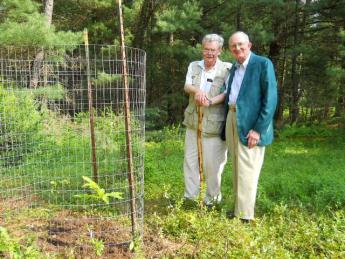
|
| American Chestnut tree |
RECENTLY, John Wenderoth of the Tyler Arboretum visited the Right Angle Club of Philadelphia, bringing an astounding account of the triumph, near-extinction, and revival of the American Chestnut tree. The Tyler Arboretum, and this man, in particular, is at the center of the movement to rescue the tree, although the modern Johnny Appleseeds of the movement seem to be a Central Pennsylvanian named Bob Leffel, and a geneticist named Charles Burnham. Together, they had the vision and drive to enlist a thousand volunteers to plant seedlings in Pennsylvania; and there are many other volunteer groups in other states within Appalachia. About 45,000 Chestnut hybrids have been planted, surrounded by wire fencing to protect the new trees until they grow too tall for deer to reach the leaves. Here's the story.
In 1904 it was estimated that a fourth of all trees in the Eastern United States were American Chestnuts. The tree typically grew to eighty feet before permanent branches took over, so the shading and tall pillars of tree trunks gave the forest a particular cathedral-like distinctiveness, much celebrated by such authors as James Fennimore Cooper. The wood of the American Chestnut tree is rot-resistant, so it was favored by carpenters, log-cabin builders, and furniture makers. It once was a major source of tannin, for leather tanning. The nuts were edible, but it has been a long time since they were available for much eating. The chestnuts you see roasted by sidewalk vendors are primarily Chinese Chestnuts, which actually come to us from South Korea. The Buckeye, or horse chestnut, produces a pretty and abundant nut but is too bitter for most tastes. For whatever reason, a fungus was first discovered to infect the chestnuts of the Bronx Zoo in 1905, attracting the attention of Teddy Roosevelt and his Progressive naturalist friends, but to little avail. The fungus (Cryptomeria parasitic) enters the tree through cracks in the bark, flourishes in the part of the tree which is above ground, leaving the roots undisturbed. Ordinarily, when this sort of thing happens, the roots send up shoots which keep the tree alive and flourishing. Unfortunately, the abundant deer of this area quickly nipped off the shoots as they appeared, and finally, the trees died. It took only a decade or so for this combination of natural enemies to wipe out the species, and today it is unusual to see lumber from this source. The forests of Chestnuts have been replaced by other trees, mostly oaks. The Chinese chestnut, however, proved to be resistant to the fungus, even though it does not grow to the same height.

|
| Chinese Chestnuts |
After many futile but well-meaning efforts to save the trees by foresters, friends of the American Chestnut tree turned to geneticists. The goal was to transfer the fungus resistance gene from the Chinese Chestnut to a few surviving American Chestnuts. It took six or seven generations of cross-breeding to do it (four generations of seedlings, then crossing the crosses, then weeding out the undesirable offspring), but eventually, the Tyler Arboretum was supplying truckloads of seedlings to the volunteers to plant in likely places. It's going to take many years for the seedlings to grow in sufficient numbers to make an impact on our forests, and eventually on our carpenters, but that effort is underway with gusto. If anyone wants to volunteer to join this effort, there appears to be room for plenty more people to help.
Revenue Stream for Historical Documents

|
| The Economist |
1.-2. Save the cost of publishing long bibliographies in every copy of a book whose readers mostly make no use of the bibliography, while still making the bibliography available to those who will use it. The Economist magazine now does this in the form of notifying the reader that the source documents for their articles are available on the Economist web site. This is a suitable methodology for publications with only limited bibliographies, but very large circulation and short shelf life. Essentially, it is a free service to readers which reduces the clutter and intimidation of citations to essentially unavailable sources.

|
| Kindle |
On the other hand, a recent book about Thomas Jefferson had 120 pages of bibliography citations. Unless that book has an unusually scholarly readership, most of the cost of printing and distributing 120 pages were wasted. Printing that book without the citations, but also publishing a diskette, Kindle, or website -- containing nothing but citations --would produce considerable savings for the publisher and reader, and they ought to be willing to pay for it. Unfortunately, there is resistance to anything new, and you may have to do it both ways until the idea catches on. The cost should include the right to some recognizable copy mark on the book, signifying this feature is available. Bowker and advertisers should be encouraged to use something smaller but similar. In that way, the concept can be advertised in advance of actual market penetration.
Some thought should be given to making some use of the searchability of such a bibliography. At the negligible cost, it can be resorted and listed in a wide variety of options(author, date, publication source), since the incremental cost of such additional material is minimal. For example, identifying all the citations available at one location should assist the scholar in deciding where to pursue his work. Perhaps there are ways to produce it which would help the librarian locate the material within the library or to pick out material in the same location before moving on.

|
| ABE Books |
3. Widen the availability of the text of primary sources. Much of this would be of interest to the non-professional reader if he could get to it more easily, and it would enlarge his sense of participating in the interpretation or "buy in". Unfortunately, most photocopying is still of poor quality, and the most useful version of the original is to use a keyboard. Therefore, I recommend searching for ways to induce the scholar to do it for you; if he really thinks it is an important document, would he please keyboard it for everyone else. If a way is provided for counting the number of "hits" on a document's citations, it will lead you to the popular documents, to begin with. Please don't try to start with "A" and end with "Z". After you have produced digitized copy, then photocopy it if you wish. The local Athenaeum makes quite a lot of revenue from selling reprints of architectural drawings, so there are exceptions.
4. Do not limit yourself to primary sources. There are copyright issues here, but a link to Amazon will get you revenue from Google, and a used copy of a book from ABEbooks will be delivered to your home by United Parcel Service. It's often cheaper than parking near a library.
REFERENCES
| Thomas Jefferson: The Art of Power: Jon Meacham: ISBN: 978-1400067664 | Amazon |
Army War College in Carlisle
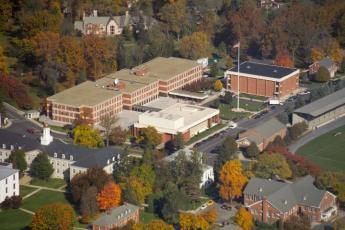
|
| U.S. Army War College |
Our program chairman, Carter Broach, once attended the Army War College, so he was in a position to invite Colonel Tom O'Steen to the Right Angle Club to tell us what the College was all about. Although there may have been times in the past when the Army welcomed secrecy surrounding its College, in recent years it has become concerned that the military may be isolating itself too much from the people it serves and defends. So Col. O'Steen was told he was welcome to talk to us. In fact, giving one speech to the public is a requirement for graduation. The history goes back to 1757, includes Ben Franklin, and also includes some interesting anecdotes which might not have been expected of a War College.
Like all land in Pennsylvania, this plot within what is now the town of Carlisle, PA, once belonged to William Penn. Nobody else owned it until 1757 when Ben Franklin was sent to negotiate its transfer from the Indians. William Penn had been careful to buy land from the Indians, even though he also formally owned it as part of a deed from Charles II of England. Other land proprietors had not been so scrupulous, often complaining of the Indian massacres which resulted, although seldom adopting Penn's rather inexpensive method of avoidance.
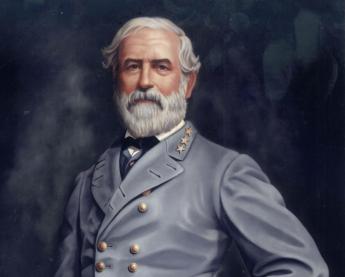
|
| Robert E. Lee |
During the Revolutionary War, Carlisle was a comfortable distance from the British Navy, and served as a backwoods artillery arsenal along the Appalachian Mountains, much as the Ho Chi Minh Trail served our enemy in the Vietnam conflict, along with an Asian mountain range. From 1790 to 1860, Carlisle served as a cavalry post, and then General Robert E. Lee invaded Pennsylvania up one side of a mountain ridge, with General Meade bringing up the Union forces from Washington DC on the other side of the ridge. The two valleys come together at Carlisle, so that spot had long been recognized as commanding both. Lee only got as far as Gettysburg before Meade caught up with him, but General Ewell's Corps took Carlisle as an advance guard. Confederate cavalry General JEB Stuart took Carlisle without sustaining a fight. Meanwhile, General Lee was fretting that Stuart was supposed to be his eyes and ears, keeping him informed of Union opposition, and it is possible that Stuart's Carlisle diversion thus had some influence on the outcome of the Battle of Gettysburg.
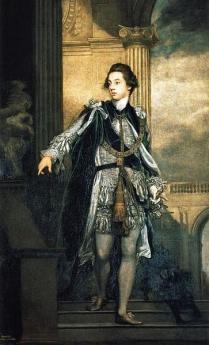
|
| Earl of Carlisle |
By 1879 there remained little purpose in a Carlisle military post, so it was turned into an Indian Industrial School, a couple of miles East of Dickinson College. After the Civil War, the nation lost its taste for exterminating Indians and turned to the idea of removing Indian boys from their families in order to assimilate them to white customs. Unfortunately, this did not work very well, and in fact, nothing worked very well. There are over 340 Indian languages from Eskimo to Aztec, but there is no record of any tribe allowing itself to be assimilated. The Spanish tried slavery, the French tried intermarriage, and the Americans tried persuasion and reasonableness. Eventually, we gave up and isolated them on reservations, but not before a wide-spread attempt was made to isolate Indian boys in boarding schools, hoping to remove them from tribal influences. That didn't work, either, but it was being attempted at Carlisle in the late 19th century. Interestingly, Carlisle is named after the family of the Earl of Carlisle, who was sent by Lord North after the disastrous British defeat at Saratoga, in order to see if the colonists might still be interested in Taxation with Representation. We weren't, so the Revolutionary War dragged on for another six years. Somehow, when war fever captures countries, small victories seems to close minds to what they had been originally fighting over. If the War College has time for another lesson, I suggest they add that one to their curriculum.
Before going back to the origins of the Army War College, we should salute the momentous football game of 1912, between the West Point cadets who included Dwight Eisenhower, and the Carlisle Indian School team which included Jim Thorpe. Thorpe was a member of an Oklahoma Indian tribe, but in many ways has been regarded as the best all-around American athlete in history. Eisenhower was pretty good, too, but Carlisle won the game.
 To raise and support Armies, but no Appropriation of Money to that Use shall be for a longer Term than two Years; To provide and maintain a Navy; 
|
| Constitution, Article 1, section 8 |
Several members of the Right Angle audience expressed the view that the Armed Services have more to fear from know-it-all university professors who feel they monopolize the field of strategic thinking than from Congress, which tends to have a goodly number of combat veterans in its ranks. It's all very well to repeat the mantra that the armed forces must respect civilian control, and then it's also just as well to remember that most coups are military coups in other countries. But whatever the future brings, these young Lt. Colonels will be the ones we must count on when the going gets really tough.
53 Blogs
William Penn: Visionary with Persuasiveness
 Even when we know how it eventually turned out, it is hard to imagine how William Penn would dare to suppose the King might give him Pennsylvania, and even harder to understand how he managed to negotiate the agreement.
Even when we know how it eventually turned out, it is hard to imagine how William Penn would dare to suppose the King might give him Pennsylvania, and even harder to understand how he managed to negotiate the agreement.
Second Amendment: The 28th Infantry Division
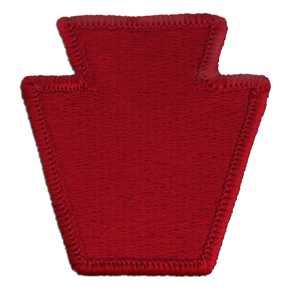 Seldom regarded as a warlike state, Pennsylvania has one of only eight reserve divisions of the U.S. Army and the oldest.
Seldom regarded as a warlike state, Pennsylvania has one of only eight reserve divisions of the U.S. Army and the oldest.
Franklin: Upstart Hero of King George's War (1747)
 'King George's War' was two wars prior to the Revolution. Ben Franklin raised an army when the Quaker proprietors' wouldn't. The experience maybe gave him ideas.
'King George's War' was two wars prior to the Revolution. Ben Franklin raised an army when the Quaker proprietors' wouldn't. The experience maybe gave him ideas.
Nation's First Hospital, 1751-2016
 The nation's oldest hospital changed more from 1948 to 2016 than it did from July 4. 1776 to 1948.
The nation's oldest hospital changed more from 1948 to 2016 than it did from July 4. 1776 to 1948.
The First and Oldest Hospital in America
 The history of American medicine is the history of the Pennsylvania Hospital.
The history of American medicine is the history of the Pennsylvania Hospital.
Slaveowning Quaker Steps Up To The Plate
 Slaves were valuable property, but it became a Quaker duty to give them their freedom. John Woolman, who started the idea, suggested freeing them in your will.
Slaves were valuable property, but it became a Quaker duty to give them their freedom. John Woolman, who started the idea, suggested freeing them in your will.
Pennsylvania Prison Society
 When the British monarchy put William Penn in jail, they set in motion a social movement which has changed prison management more than it changed Penn.
When the British monarchy put William Penn in jail, they set in motion a social movement which has changed prison management more than it changed Penn.
Tales of the Troop
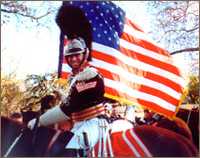 Dennis Boylan is collecting stories from the archives of Philadelphia's First City Troop. Someday, it should result in a great book.
Dennis Boylan is collecting stories from the archives of Philadelphia's First City Troop. Someday, it should result in a great book.
July 4, 1776: Patients in the Pennsylvania Hospital on Independence Day
Patients in Pennsylvania Hospital on Independence Day, 1776.
College of Physicians of Philadelphia
 The oldest medical organization in the Western Hemisphere was original founded by eight doctors who had gone to medical school, unlike the rest. It's now a museum of medical history with a huge public attendance, it's a fabulous medical historical library and a famous medical lecture venue. And it's a doctor's club.
The oldest medical organization in the Western Hemisphere was original founded by eight doctors who had gone to medical school, unlike the rest. It's now a museum of medical history with a huge public attendance, it's a fabulous medical historical library and a famous medical lecture venue. And it's a doctor's club.
The Garden Show Evolves
 Exhibitors at the Philadelphia Garden Show have gradually evolved from amateurs to nurserymen, and from nurserymen to florists.
Exhibitors at the Philadelphia Garden Show have gradually evolved from amateurs to nurserymen, and from nurserymen to florists.
Wagner Free Institute of Science
 The Wagner science museum may not be the oldest museum in Philadelphia, but it is certainly the only one that is exactly the same as it was in the Nineteenth Century. It's a museum museum.
The Wagner science museum may not be the oldest museum in Philadelphia, but it is certainly the only one that is exactly the same as it was in the Nineteenth Century. It's a museum museum.
The Savoy and the Orpheus
 Two amateur singing groups are fixtures of the Philadelphia musical, and social, scene. Their success is partially due to the high costs of union labor.
Two amateur singing groups are fixtures of the Philadelphia musical, and social, scene. Their success is partially due to the high costs of union labor.
Onward, Christian Soldiers
 Like a fairy godmother, Jane Kroc has dropped a spectacular gift on the poor of North Philadelphia, and the Salvation Army. Opening in 2009.
Like a fairy godmother, Jane Kroc has dropped a spectacular gift on the poor of North Philadelphia, and the Salvation Army. Opening in 2009.
Cushman Club for Lonesome Actresses
 One of the ancient Camac Street clubs has closed its doors, to become a charitable foundation.
One of the ancient Camac Street clubs has closed its doors, to become a charitable foundation.
AFSC: American Friends Service Committee
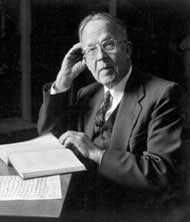 Quakers serve, without fear or favor.
Quakers serve, without fear or favor.
Philadelphia Mafia: The First Fifty Years
 For forty years after 1880, The Philadelphia Mafia was a small vigilante group secretly protecting Sicilian immigrants from marauding gangs of local Italians, which were definitely not the same thing. Prohibition transformed the whole nature of the underworld.
For forty years after 1880, The Philadelphia Mafia was a small vigilante group secretly protecting Sicilian immigrants from marauding gangs of local Italians, which were definitely not the same thing. Prohibition transformed the whole nature of the underworld.
Plays and Players, Haddonfield Version
 This year the Haddonfield Plays and Players celebrate their 75th anniversary, with an outstanding production of Anything Goes, by Cole Porter Y'13.
This year the Haddonfield Plays and Players celebrate their 75th anniversary, with an outstanding production of Anything Goes, by Cole Porter Y'13.
Christmas Reflections
 It once was a tradition to go back to the big city for Christmas shopping..
It once was a tradition to go back to the big city for Christmas shopping..
Skating and Humane
 America's premier indoor skating club had its origin as a life-saving association.
America's premier indoor skating club had its origin as a life-saving association.
The American Friends Service Committee
 Bravery in the face of danger, both physical and social, underlies the enormous international prestige of this remarkable Quaker relief organization. Many of its achievements defy all comparison.
Bravery in the face of danger, both physical and social, underlies the enormous international prestige of this remarkable Quaker relief organization. Many of its achievements defy all comparison.
Recording for the Blind and Dyslexic
 Out in King of Prussia, almost 300 volunteers make tape recordings of textbooks for people who can't read.
Out in King of Prussia, almost 300 volunteers make tape recordings of textbooks for people who can't read.
Police Athletic League
 The Police Athletic League wasn't invented in Philadelphia, but it has done the city a lot of good.
The Police Athletic League wasn't invented in Philadelphia, but it has done the city a lot of good.
Main Line School Night
 There are a lot of continuing education courses, but few are as successful as Main Line School Night, with 14,000 students, hardly any of whom need education.
There are a lot of continuing education courses, but few are as successful as Main Line School Night, with 14,000 students, hardly any of whom need education.
George Willoughby, 95, Peace Activist
 In The Philadelphia Inquirer for February 4, 2010, By Claudia Vargas Inquirer Writer.
In The Philadelphia Inquirer for February 4, 2010, By Claudia Vargas Inquirer Writer.
SCORE
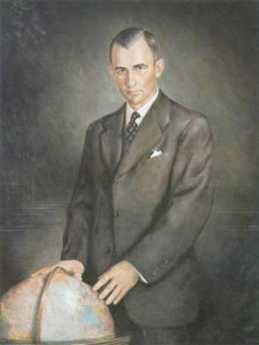 The Service Corps of Retired Executives has taken a new turn in Philadelphia, primarily serving minority start-ups, a majority of which are founded by black women.
The Service Corps of Retired Executives has taken a new turn in Philadelphia, primarily serving minority start-ups, a majority of which are founded by black women.
Block Captains
 A remarkable group of volunteers look out for their neighbors.
A remarkable group of volunteers look out for their neighbors.
Kenneth Gordon, MD, Hero of Valley Forge
 This soft-spoken child psychiatrist was mainly responsible for keeping real estate developers from building houses all over the Valley Forge encampment.
This soft-spoken child psychiatrist was mainly responsible for keeping real estate developers from building houses all over the Valley Forge encampment.
Old Blockley (P.G.H.)
 Every Victorian American city had a big medical almshouse, but Philadelphia had the best. The 1965 Amendments to the Social Security Act (Medicare and Medicaid) destroyed P.G. H. at the behest of local hospitals. They now regret it.
Every Victorian American city had a big medical almshouse, but Philadelphia had the best. The 1965 Amendments to the Social Security Act (Medicare and Medicaid) destroyed P.G. H. at the behest of local hospitals. They now regret it.
Please Touch
 The Please Touch Museum, a roaring success story, is planning to move too much larger quarters in the Fall of 2008.
The Please Touch Museum, a roaring success story, is planning to move too much larger quarters in the Fall of 2008.
Urban Bridges
 The Episcopal Church has found a practical way for its prosperous suburban branches to form partnerships with struggling urban parishes.
The Episcopal Church has found a practical way for its prosperous suburban branches to form partnerships with struggling urban parishes.
Loaves and Fishes
 Philabundance comes close to automating the feeding of homeless people, drawing on the techniques of the supermarket chains.
Philabundance comes close to automating the feeding of homeless people, drawing on the techniques of the supermarket chains.
Sacred Places at Risk
 Church structures don't migrate, but church members do. A volunteer organization in Philadelphia has formed, to help endangered congregations decide how to review their options and act on the best choice.
Church structures don't migrate, but church members do. A volunteer organization in Philadelphia has formed, to help endangered congregations decide how to review their options and act on the best choice.
Manna

Fairmount Park Historic Preservation Trust
 First you must learn how colonial buildings were made, then you have to learn how to do it yourself. And after that, this imaginative preservation society has branched out to help other regions restore colonial buildings.
First you must learn how colonial buildings were made, then you have to learn how to do it yourself. And after that, this imaginative preservation society has branched out to help other regions restore colonial buildings.
Doing Well, Doing Good.
 A board member of Rotary International recently ran an Afghanistan relief program and wrote a novel about the Battle of Brandywine. He's a Quaker, lives on a farm, and is chairman of the boards of several organizations.
A board member of Rotary International recently ran an Afghanistan relief program and wrote a novel about the Battle of Brandywine. He's a Quaker, lives on a farm, and is chairman of the boards of several organizations.
Astral
 Vera Wilson decided that young musicians need help to become famous, so she set up an organization to create musical stars. It seems to work, and it adds sparkle to Philadelphia.
Vera Wilson decided that young musicians need help to become famous, so she set up an organization to create musical stars. It seems to work, and it adds sparkle to Philadelphia.
Native Habitat
 Increased foreign trade, especially to Asia, has brought us some new plant types. Lacking natural enemies, they are taking over.
Increased foreign trade, especially to Asia, has brought us some new plant types. Lacking natural enemies, they are taking over.
Marian B. Sanders, Quaker Activist, 87

Friends Lifecare at Home
 Philadelphia Quakers run over twenty retirement communities for the elderly in their region. One of them is a virtual village, one without walls.
Philadelphia Quakers run over twenty retirement communities for the elderly in their region. One of them is a virtual village, one without walls.
The Kimmel Center: Comments On The Economics of Music
 Philadelphia needs more than one concert hall, but two of them may be more music than we can manage.
Philadelphia needs more than one concert hall, but two of them may be more music than we can manage.
Phillycarshare
 Those little red cars running around Philadelphia are for rent, by the hour.
Those little red cars running around Philadelphia are for rent, by the hour.
Quaker Gray Turns Quaker Green
 Quakers mean to turn their headquarters near Philadelphia City Hall into a glowing example of how to save money while they save their environment.
Quakers mean to turn their headquarters near Philadelphia City Hall into a glowing example of how to save money while they save their environment.
Community Volunteers in Medicine
 A little group of medical volunteers in Pennsylvania's Chester County may not understand the underlying issues very well, but they just pitch in and do what they can about the medically underserved.
A little group of medical volunteers in Pennsylvania's Chester County may not understand the underlying issues very well, but they just pitch in and do what they can about the medically underserved.
Neopolitan Right Angle
 A transplanted Philadelphian plants a metastasis in Florida.
A transplanted Philadelphian plants a metastasis in Florida.
Use the Internet for Your Club

Use the Internet for Your Club (2)
Clubs like to have newsletters. If you have enough news to fill one, they are pretty easy to create and maintain. However, they are a little hard to explain, so stick with us as we build up the idea.
Volunteerism Needs a Business Plan
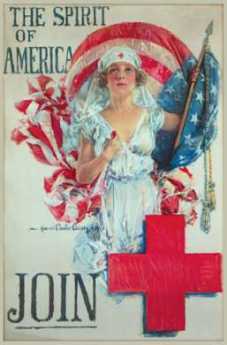 Volunteerism has declined in recent years because of conflicting demands made by gainful employment. The spirit of volunteerism has not diminished, it just needs a different business plan.
Volunteerism has declined in recent years because of conflicting demands made by gainful employment. The spirit of volunteerism has not diminished, it just needs a different business plan.
Making Volunteerism a Business
The computer has systematically eliminated middle-men and middle management in every business. Why not extend that to social clubs, entertainment, and the rest of the non-profit world?
The Association (5)
 The American Medical Association claims to represent the collective views of the medical profession, and sometimes its detractors scoff at that idea. AMA really has an elegant system for hearing the voice of a single physician, and if it likes what it hears, is really good at magnifying that voice.
The American Medical Association claims to represent the collective views of the medical profession, and sometimes its detractors scoff at that idea. AMA really has an elegant system for hearing the voice of a single physician, and if it likes what it hears, is really good at magnifying that voice.
American Chestnut Trees
 Scarcely a century ago, American Chestnut trees were a quarter of all trees in America. Now, they are almost all gone, but a thousand volunteers are trying to rescue them.
Scarcely a century ago, American Chestnut trees were a quarter of all trees in America. Now, they are almost all gone, but a thousand volunteers are trying to rescue them.
Revenue Stream for Historical Documents
 New blog 2013-01-10 17:45:38 description
New blog 2013-01-10 17:45:38 description
Army War College in Carlisle
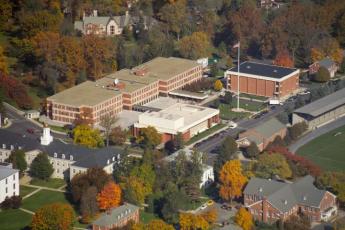 If you have been to Carlisle, PA, you have seen the Army War College, but you may not know much about it.
If you have been to Carlisle, PA, you have seen the Army War College, but you may not know much about it.